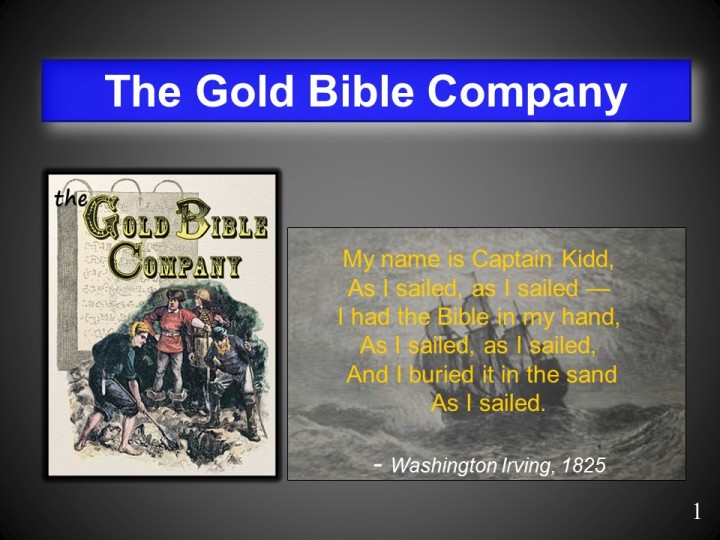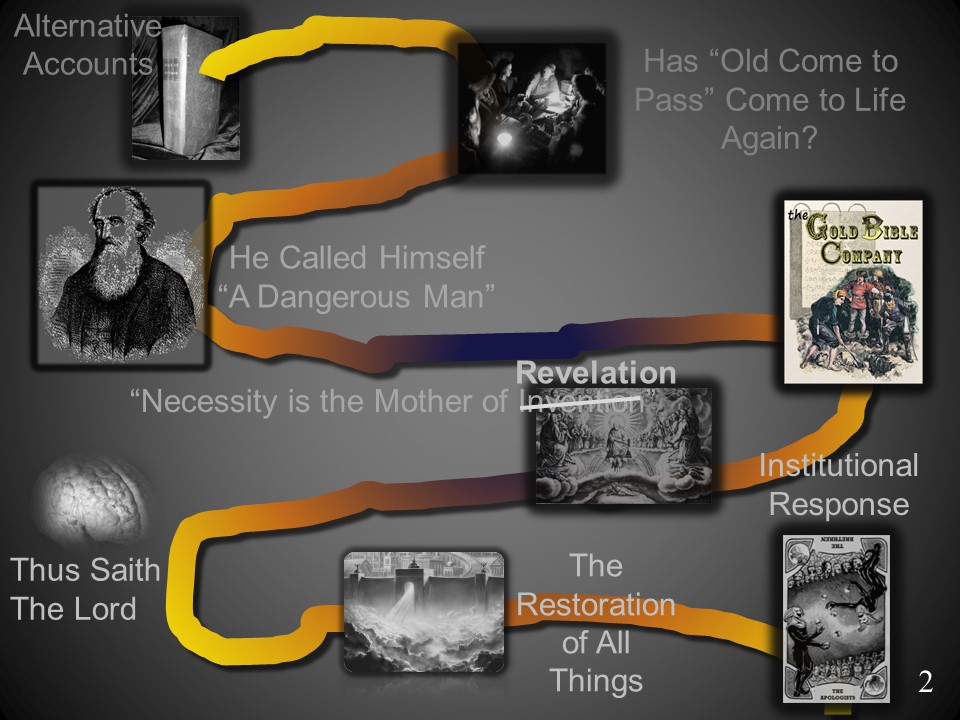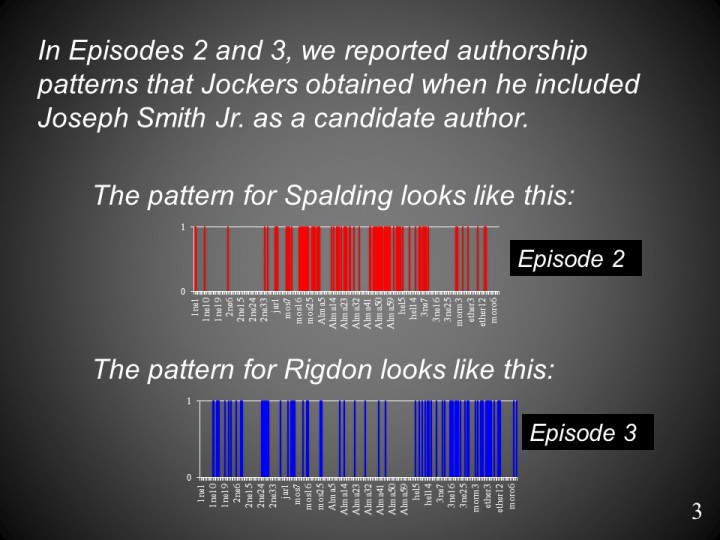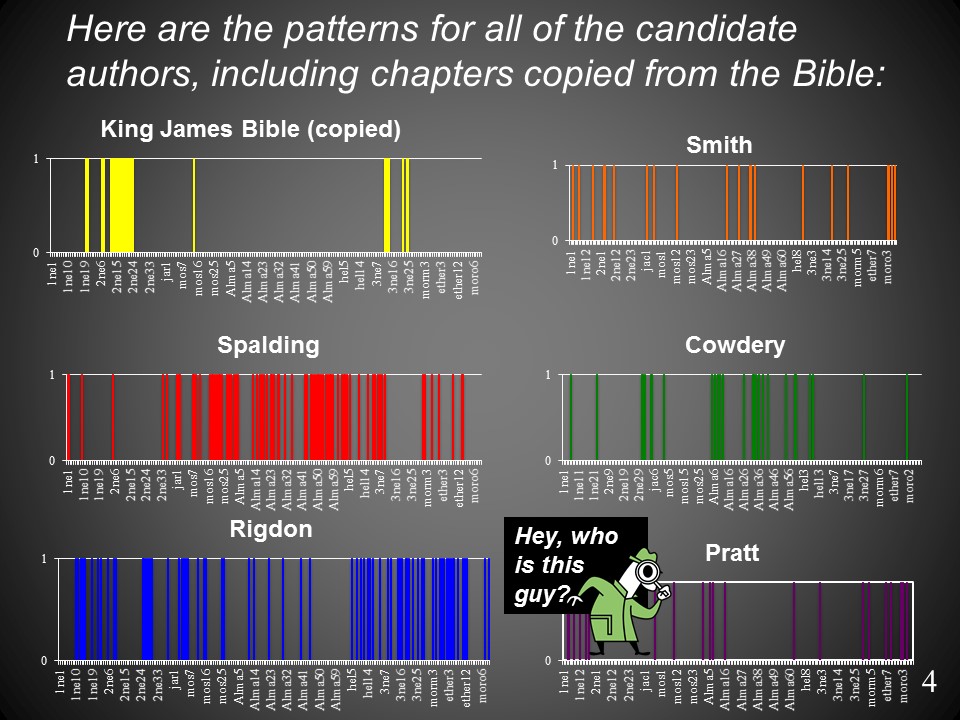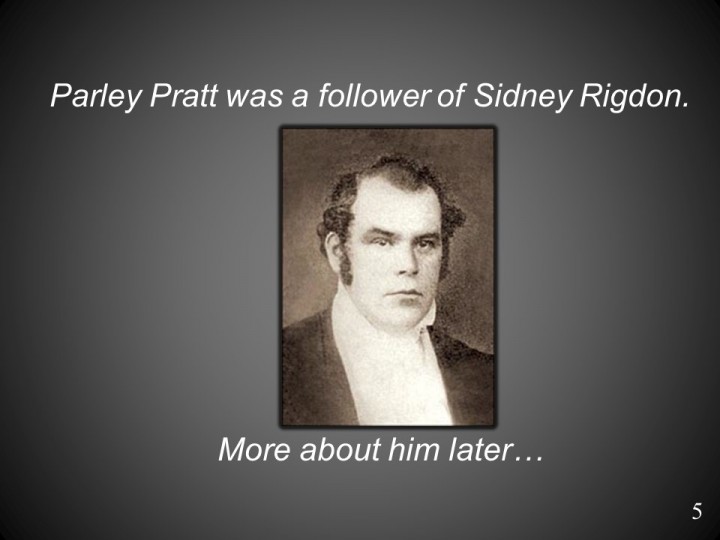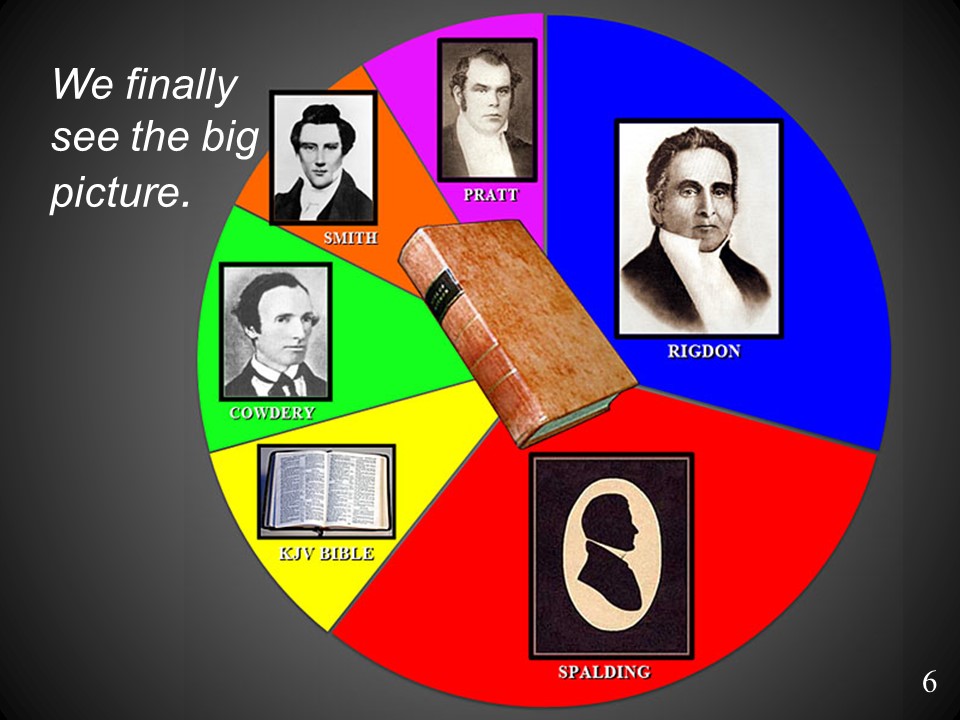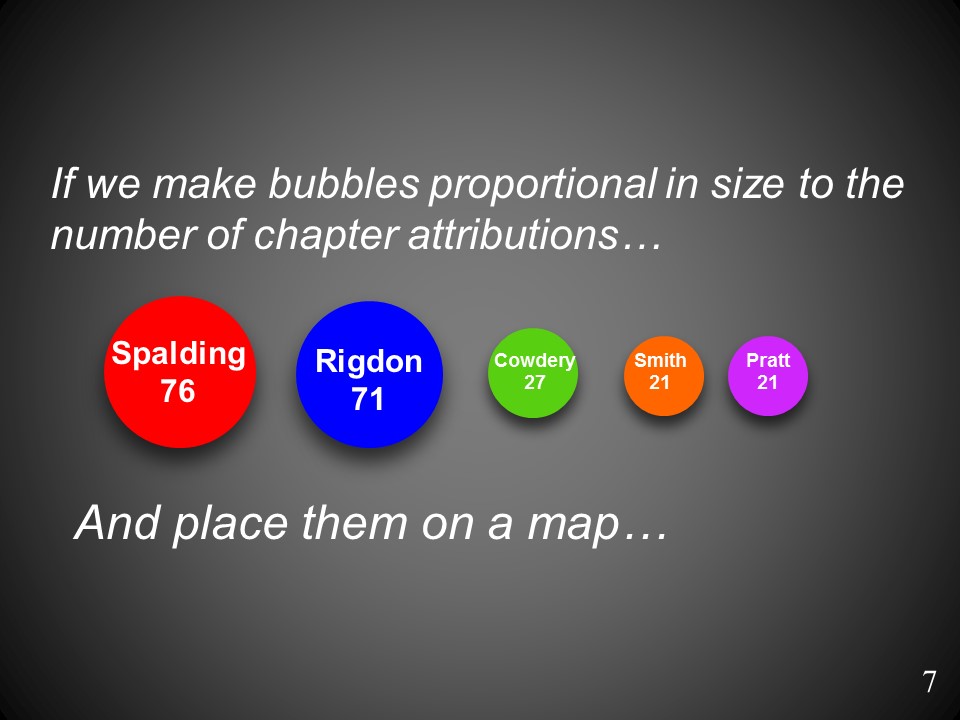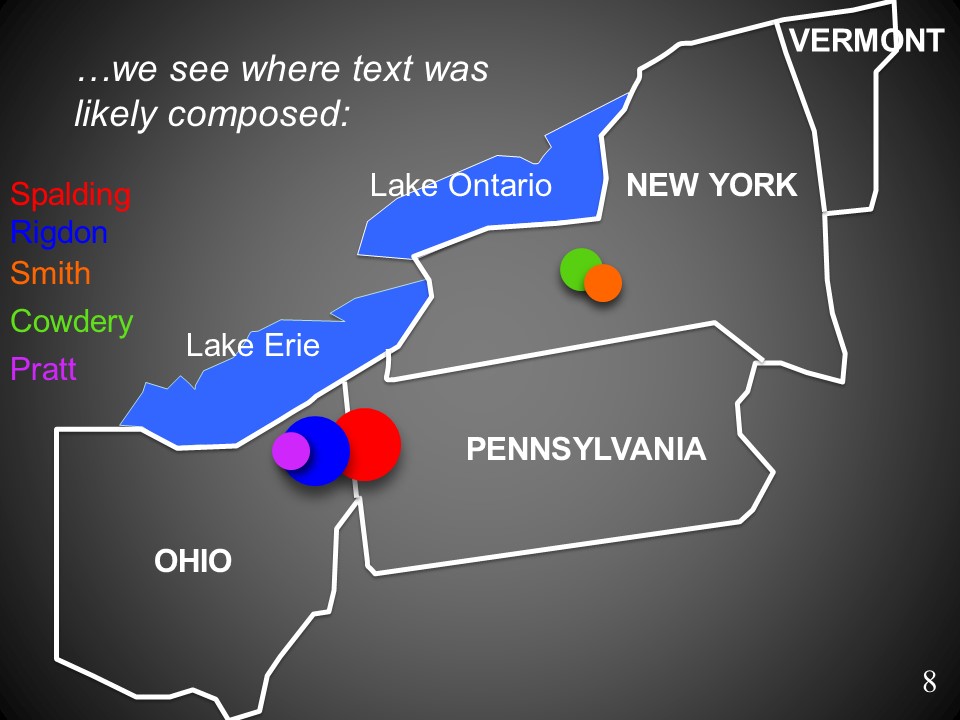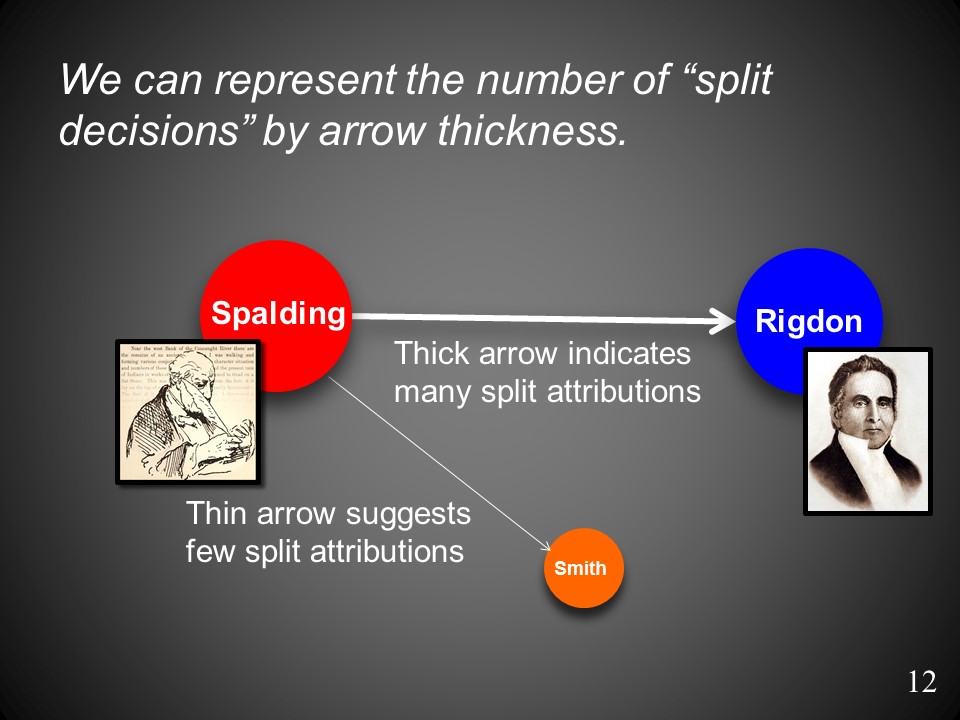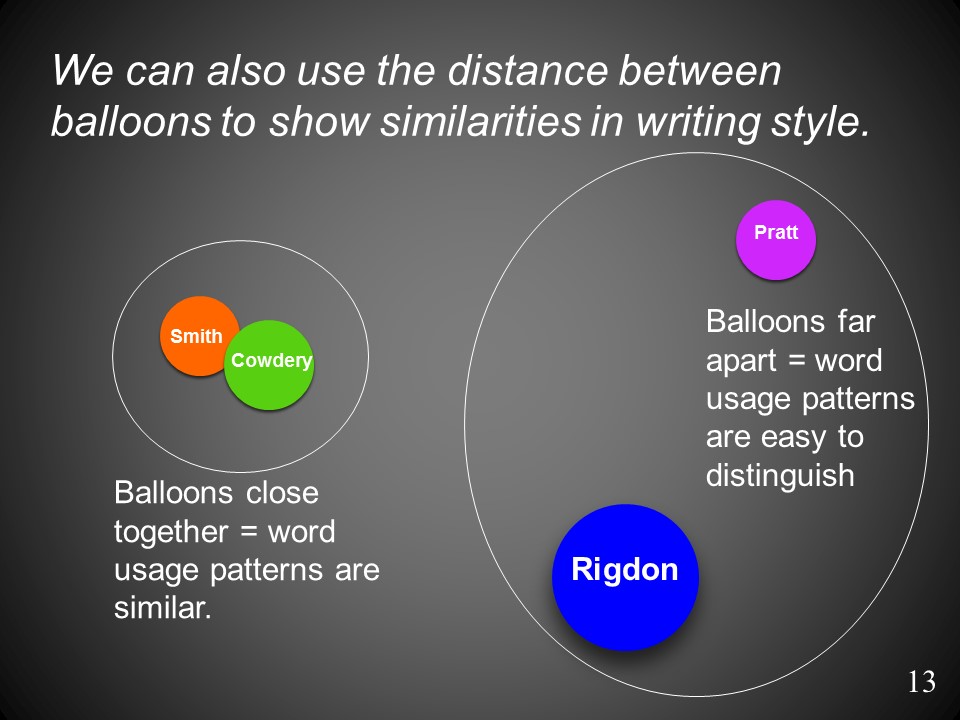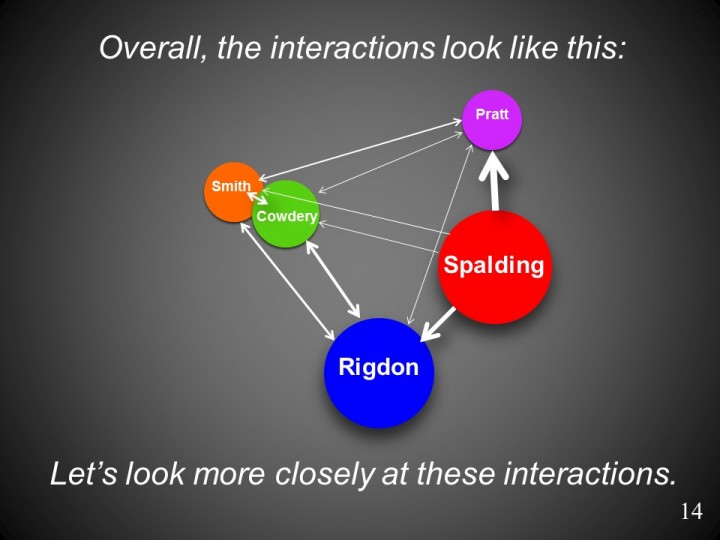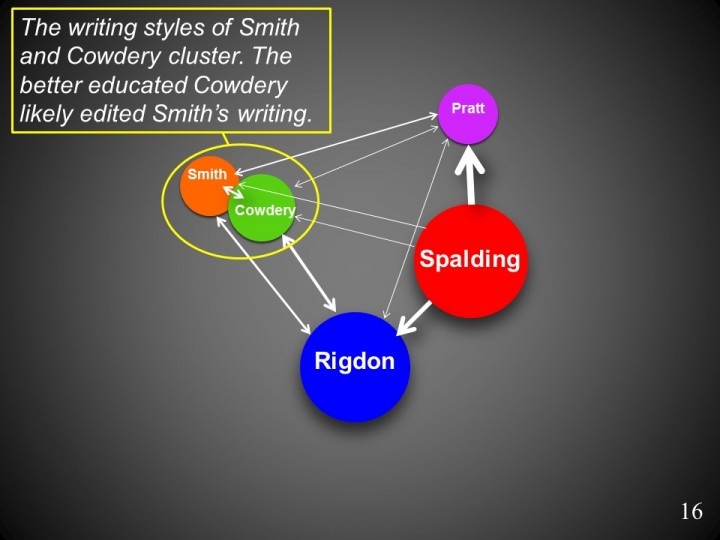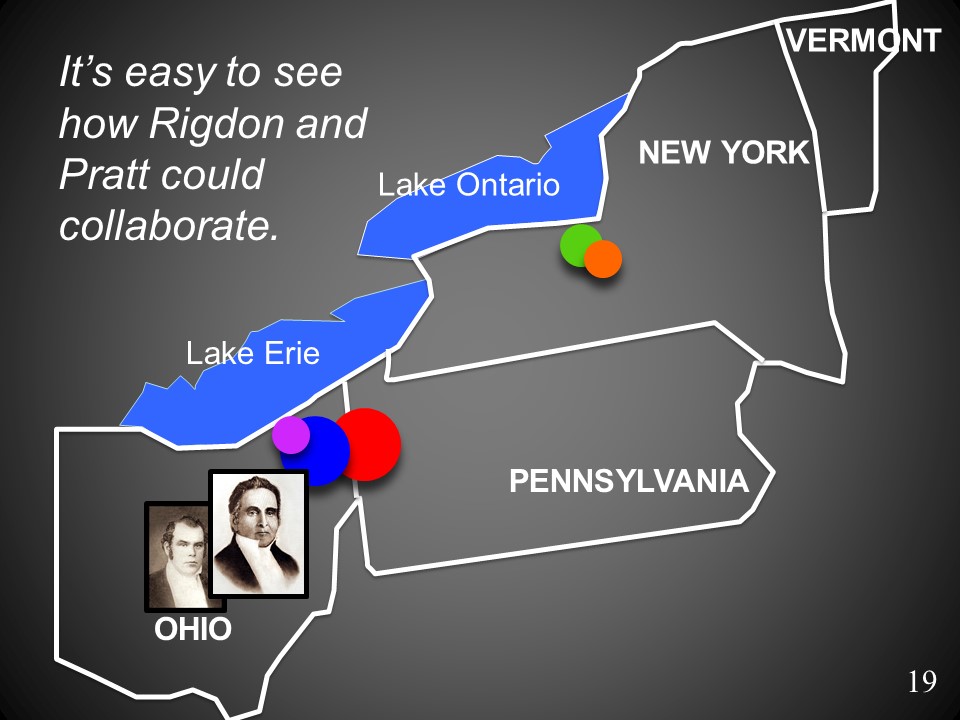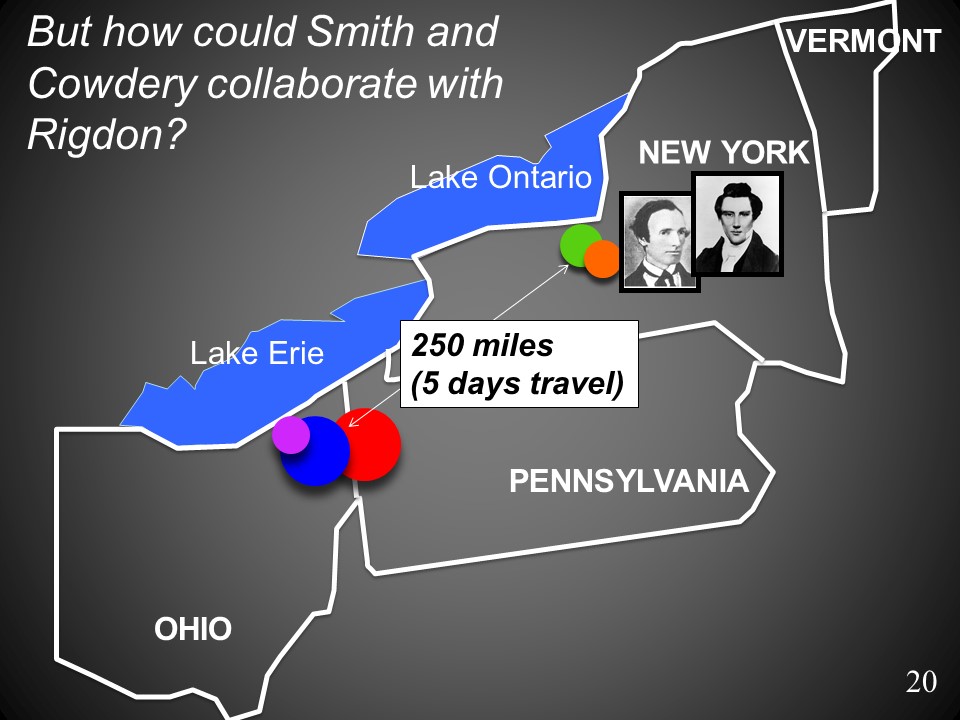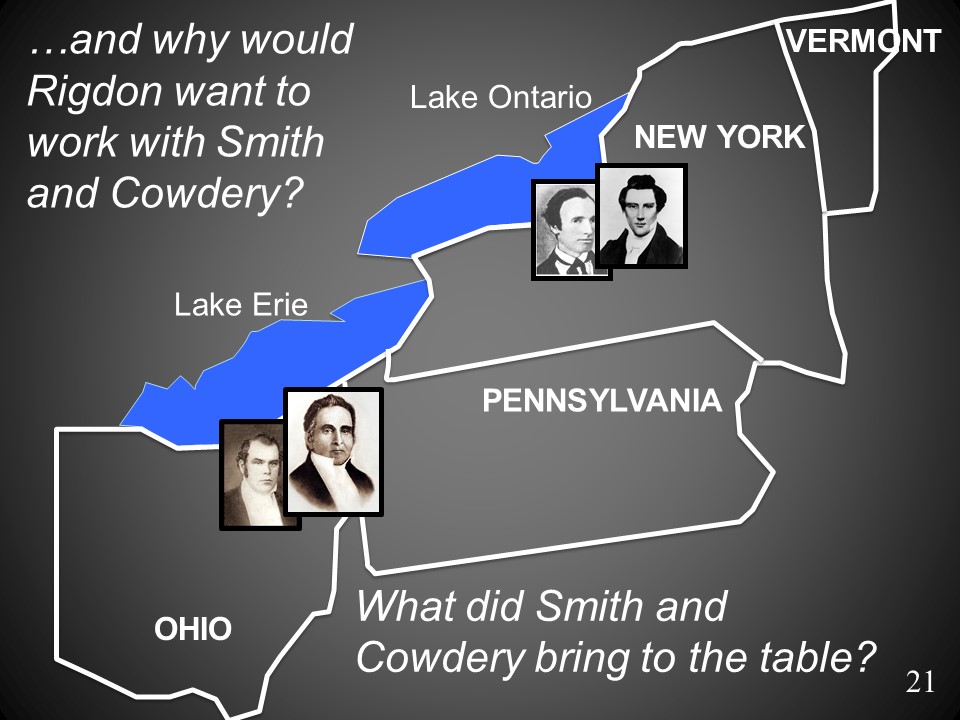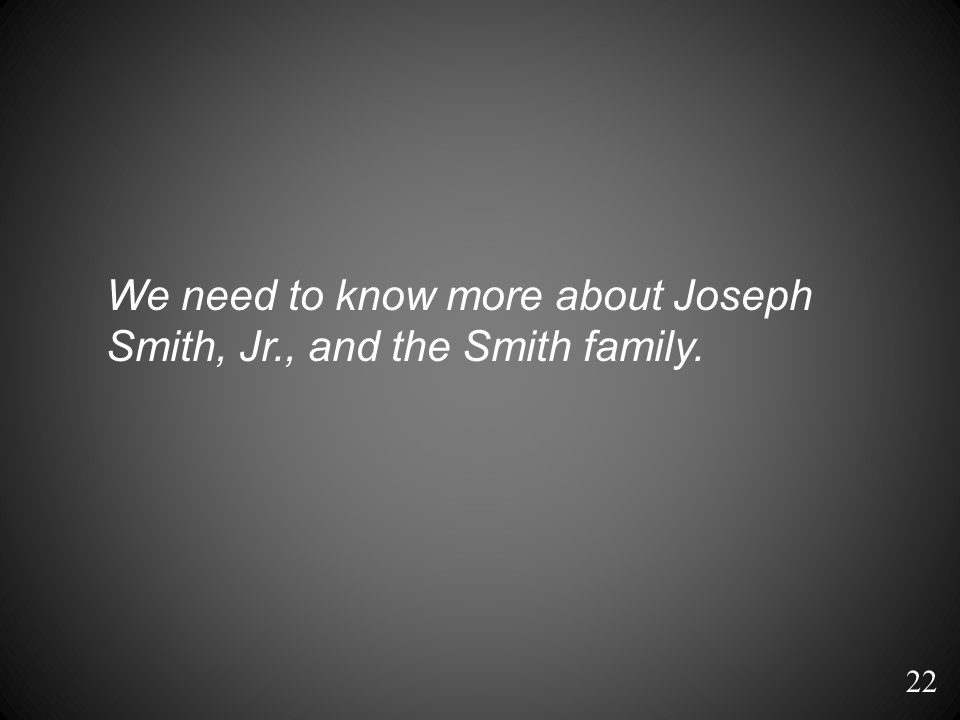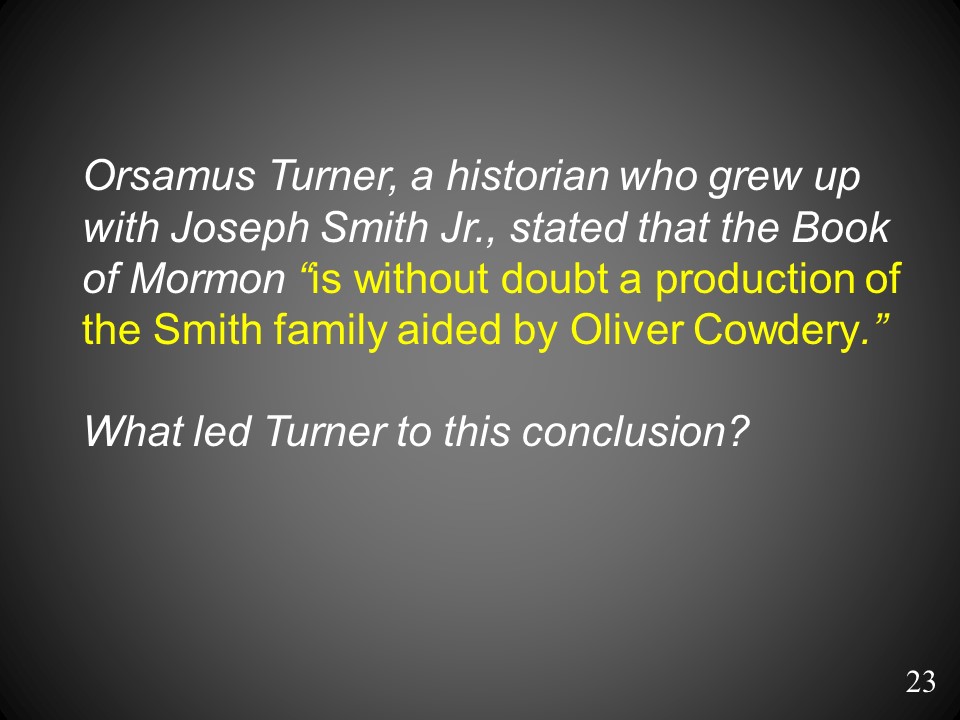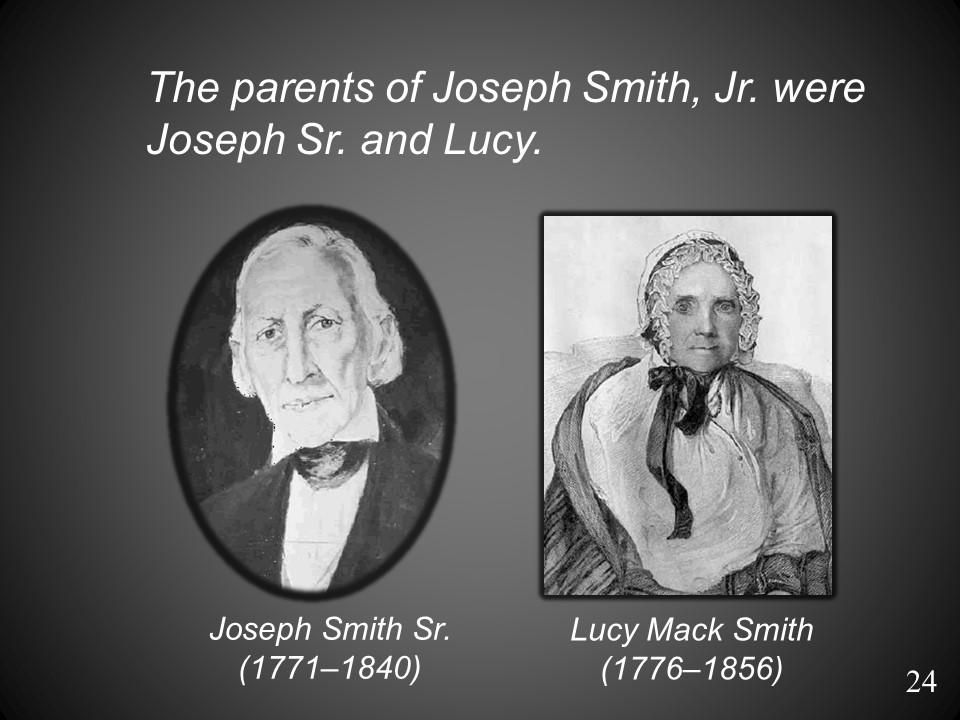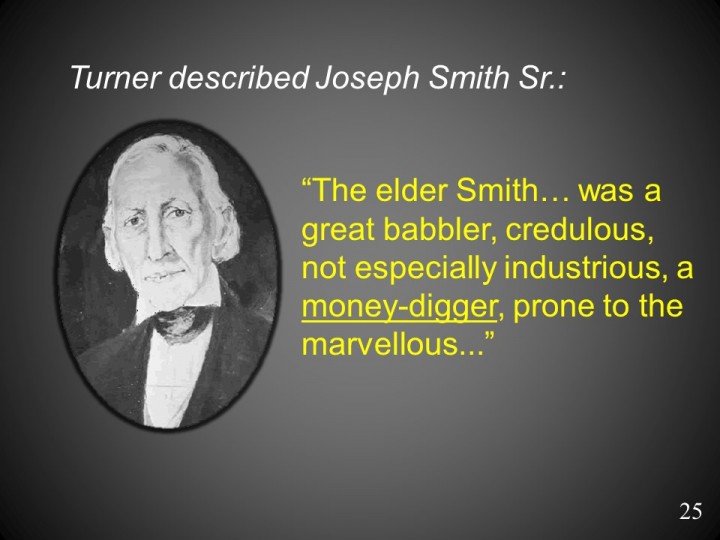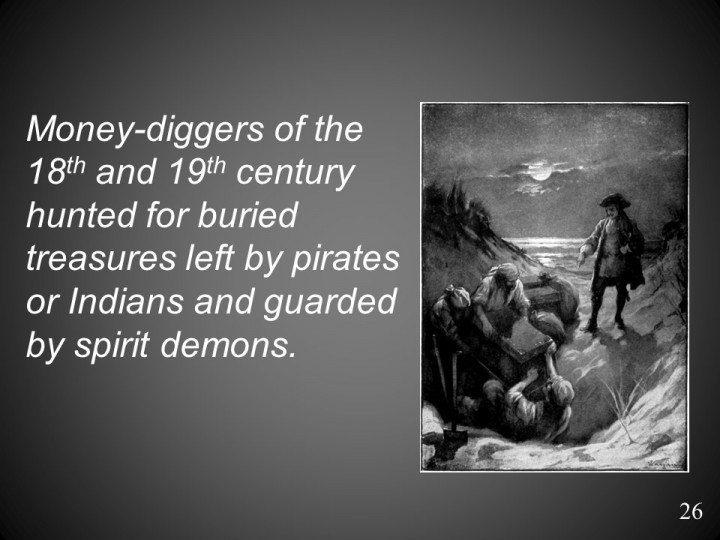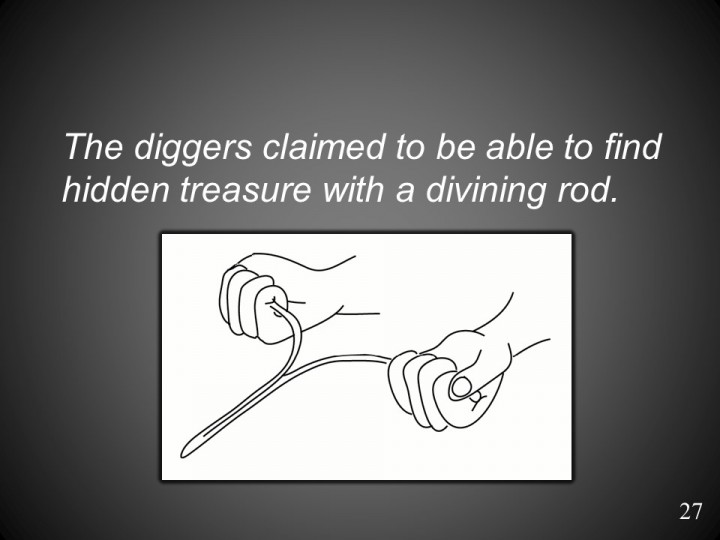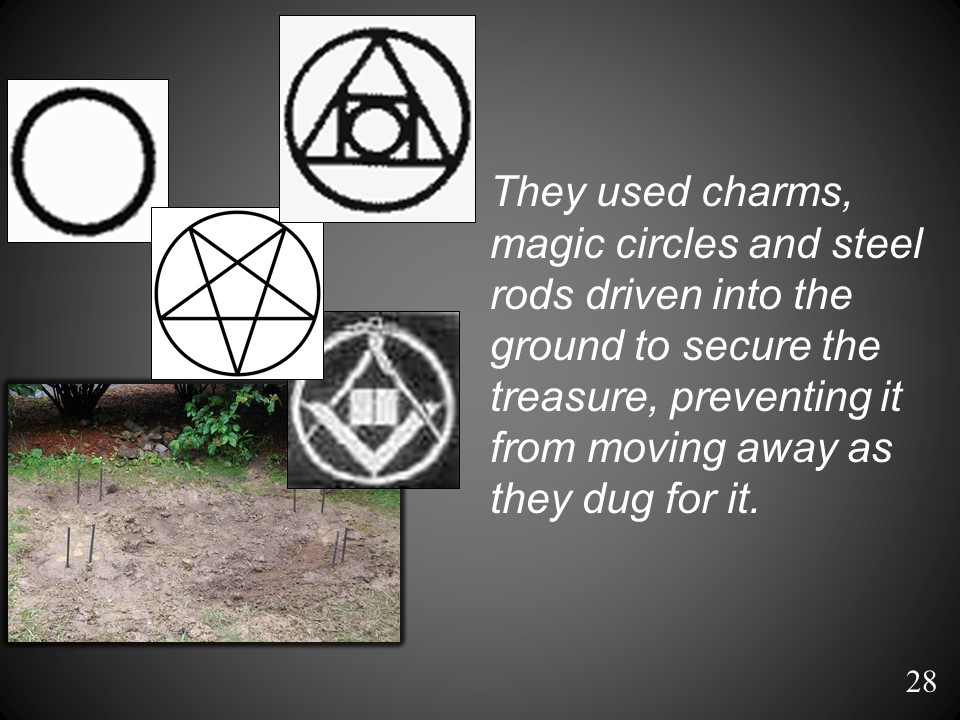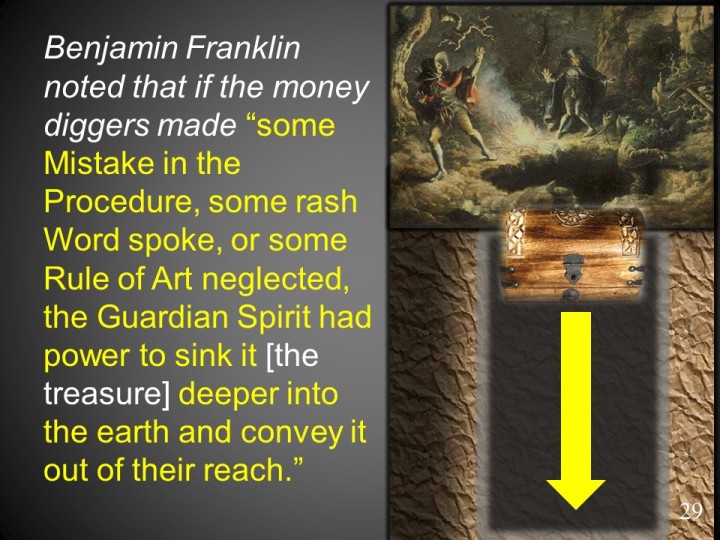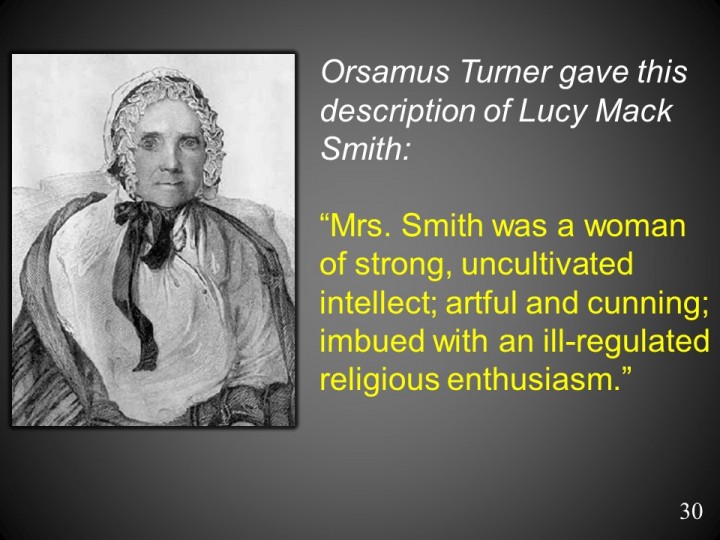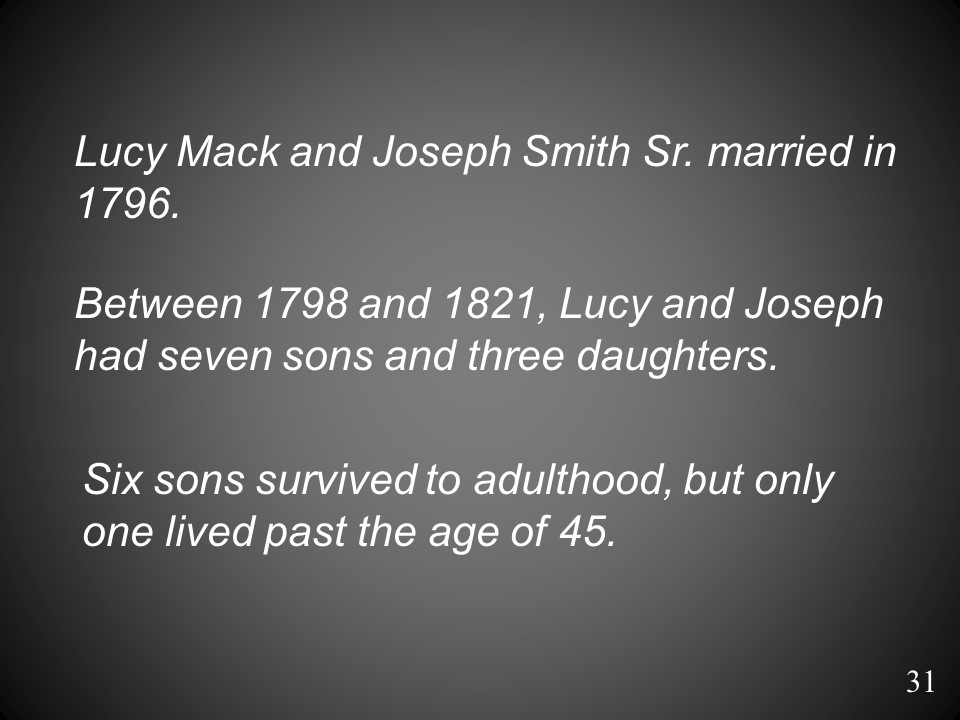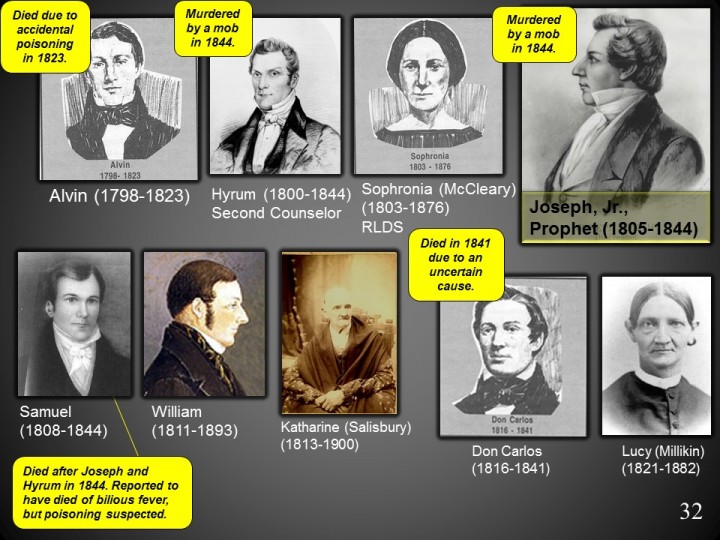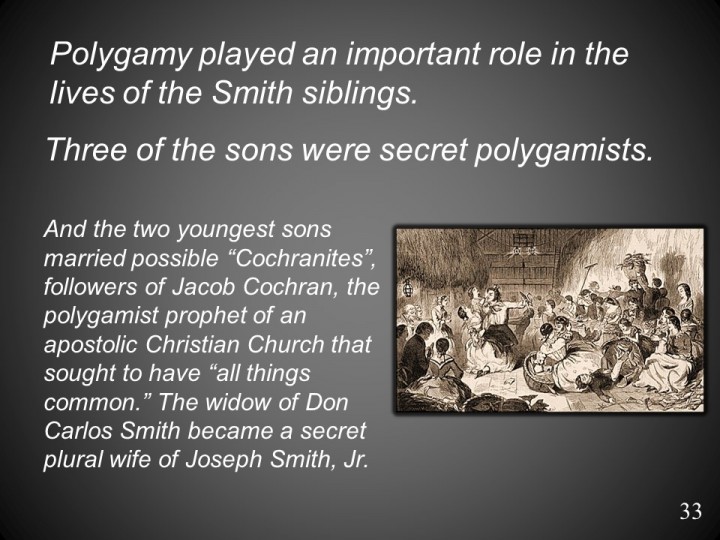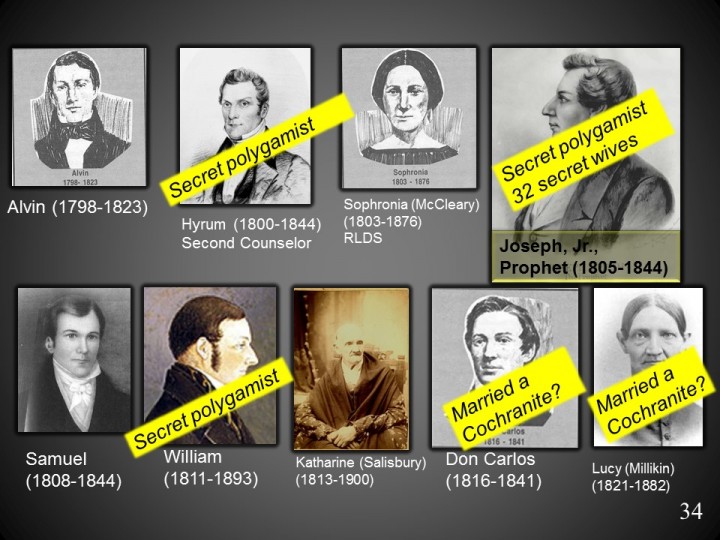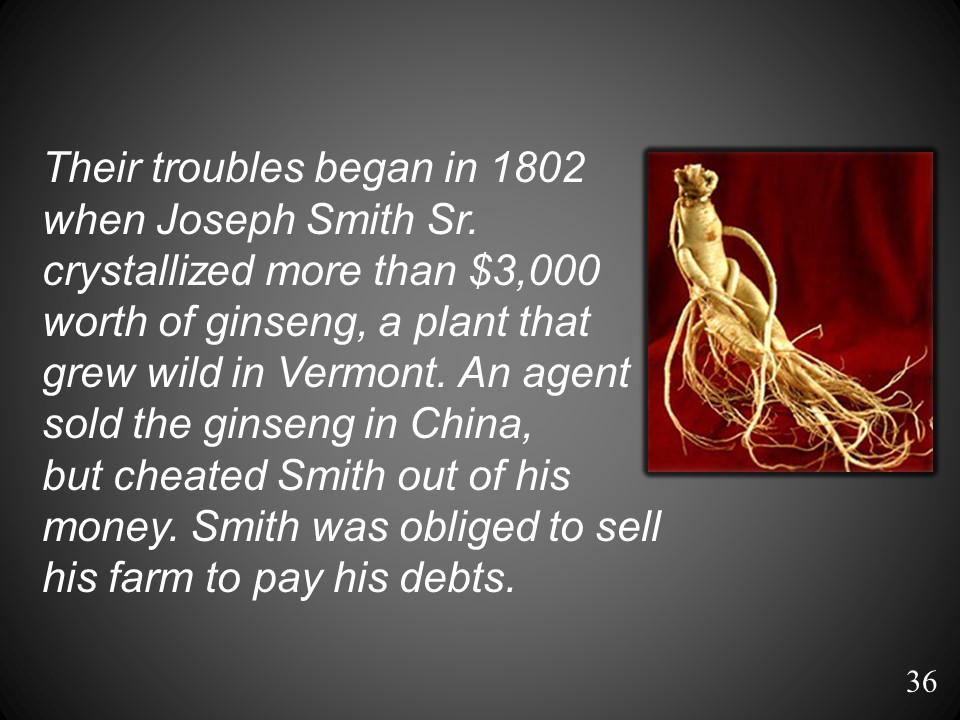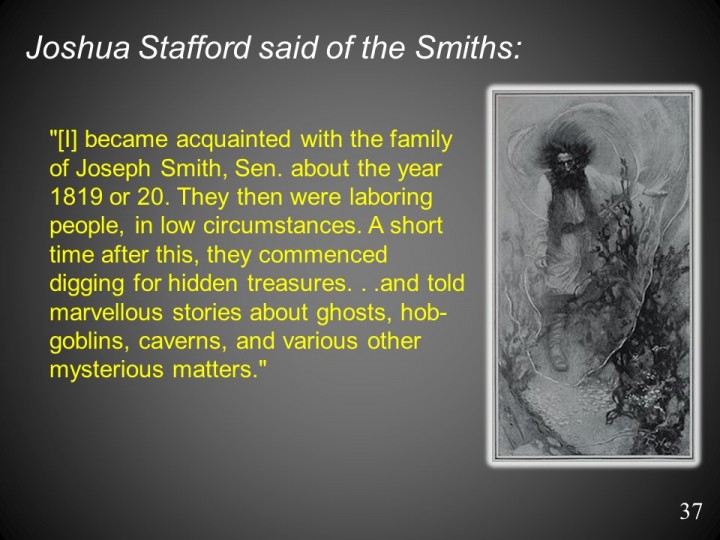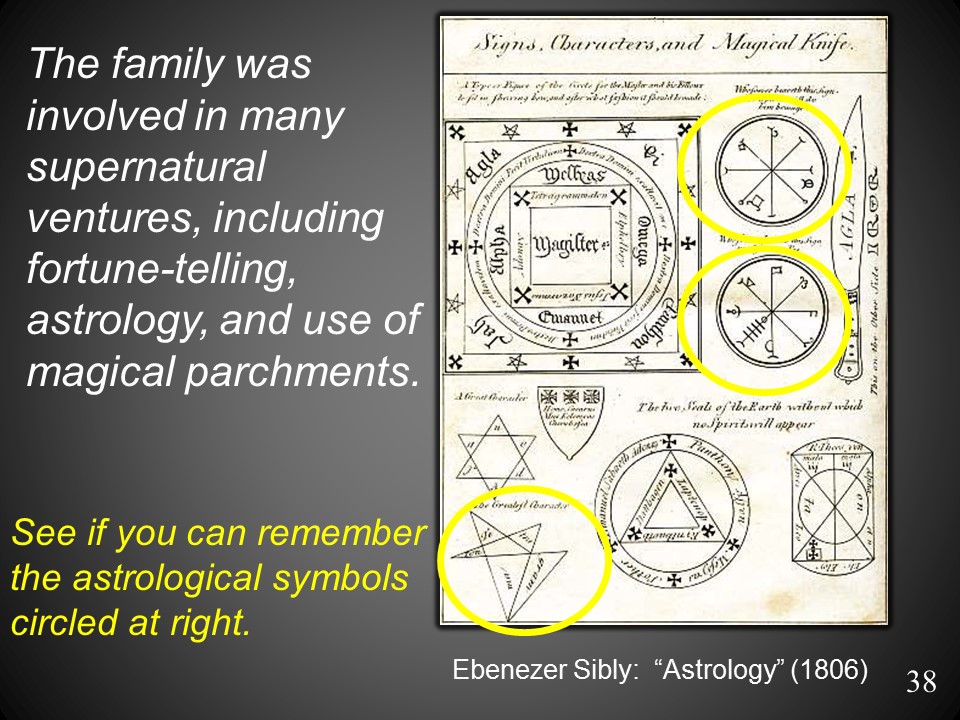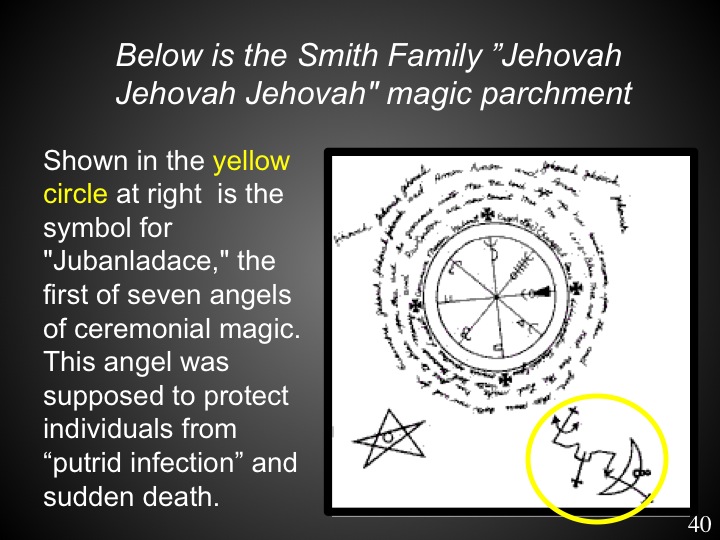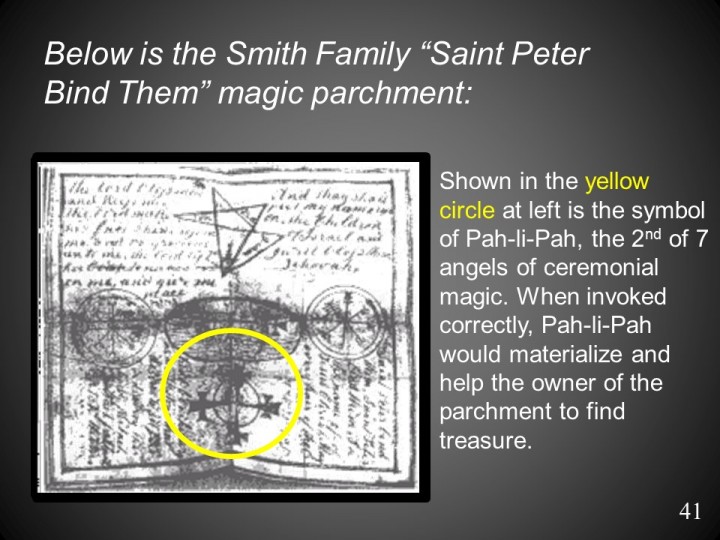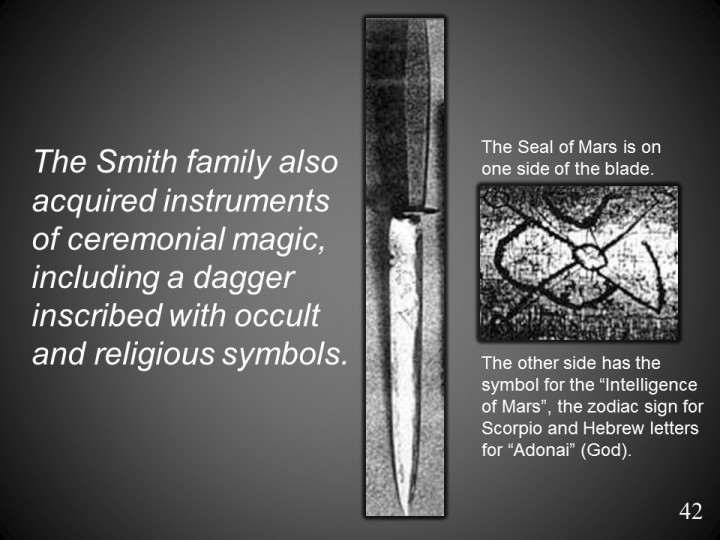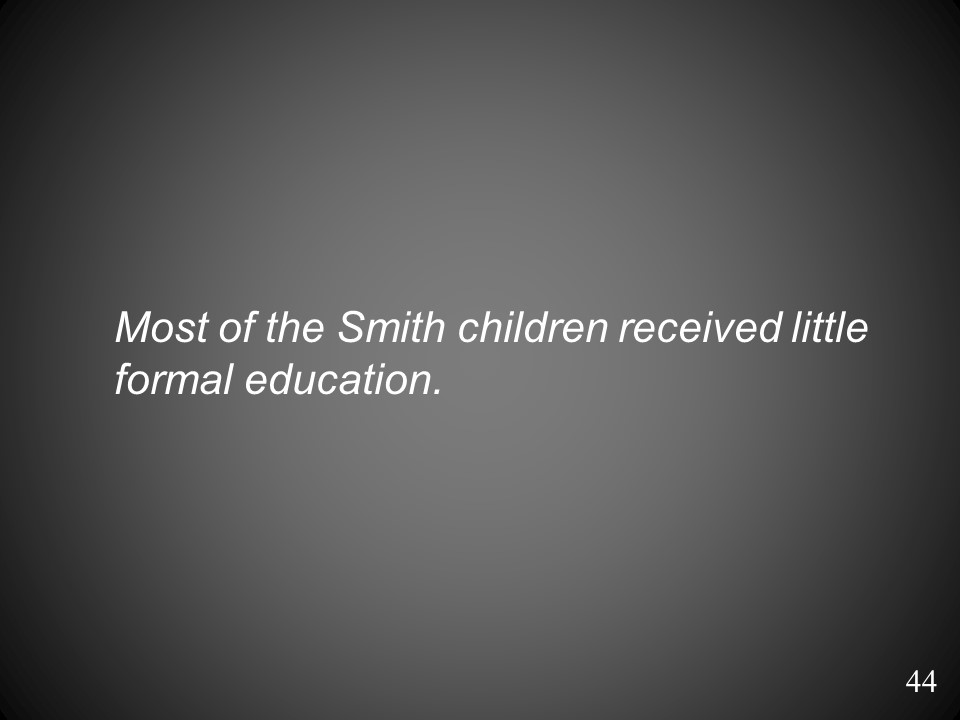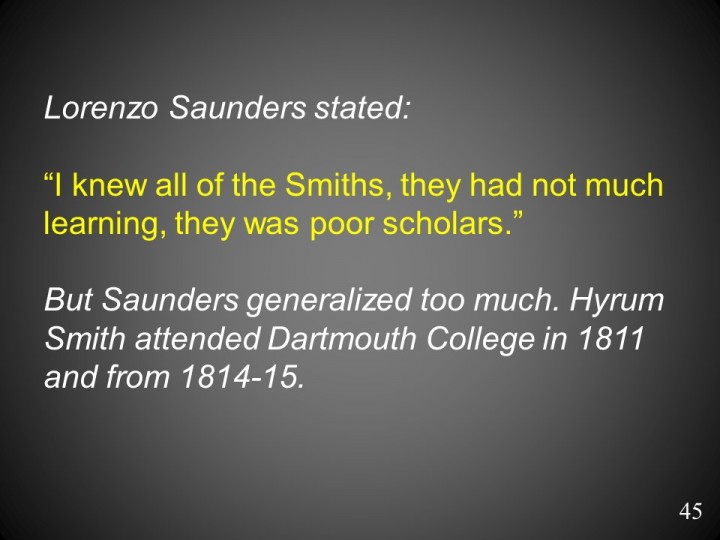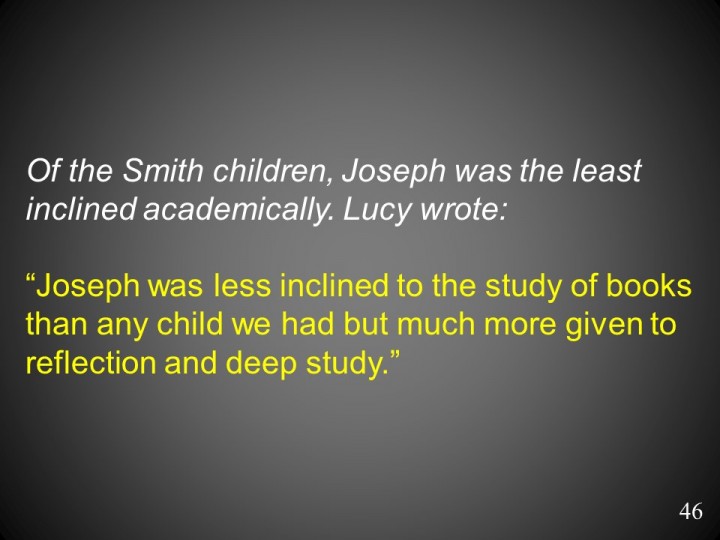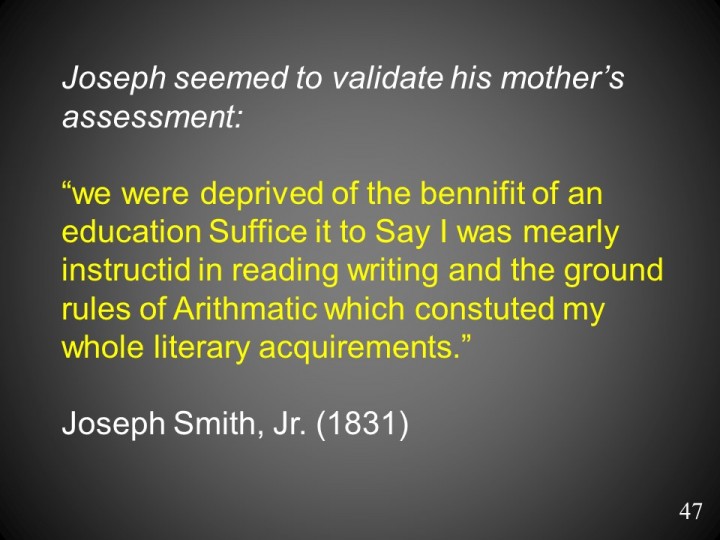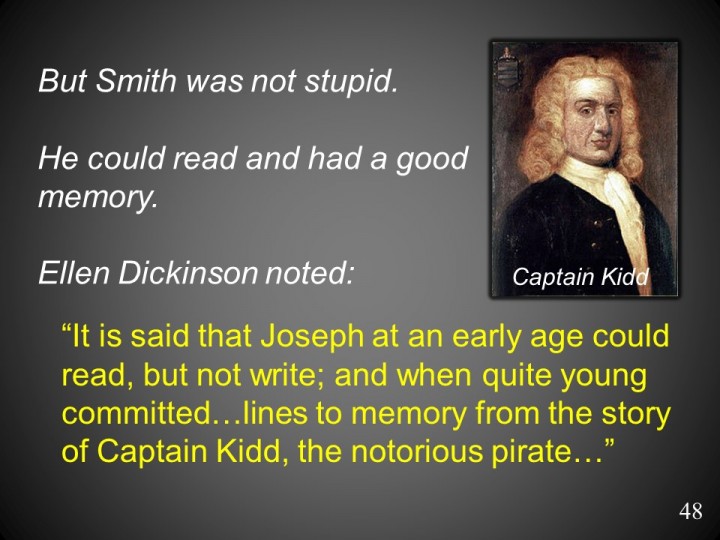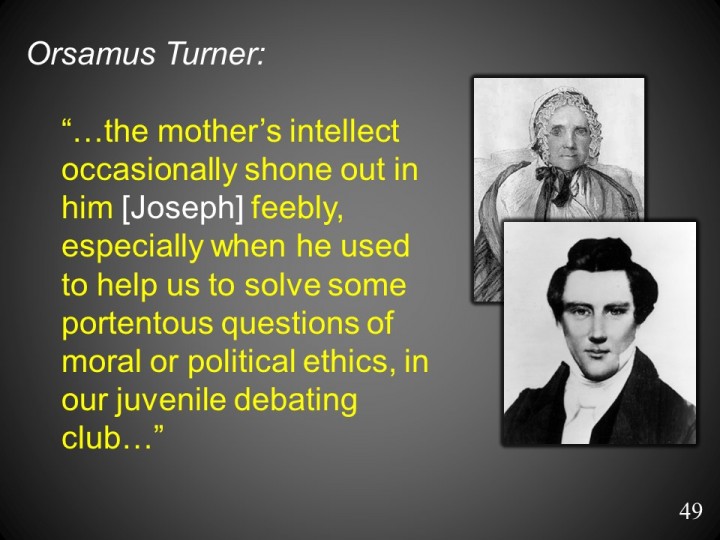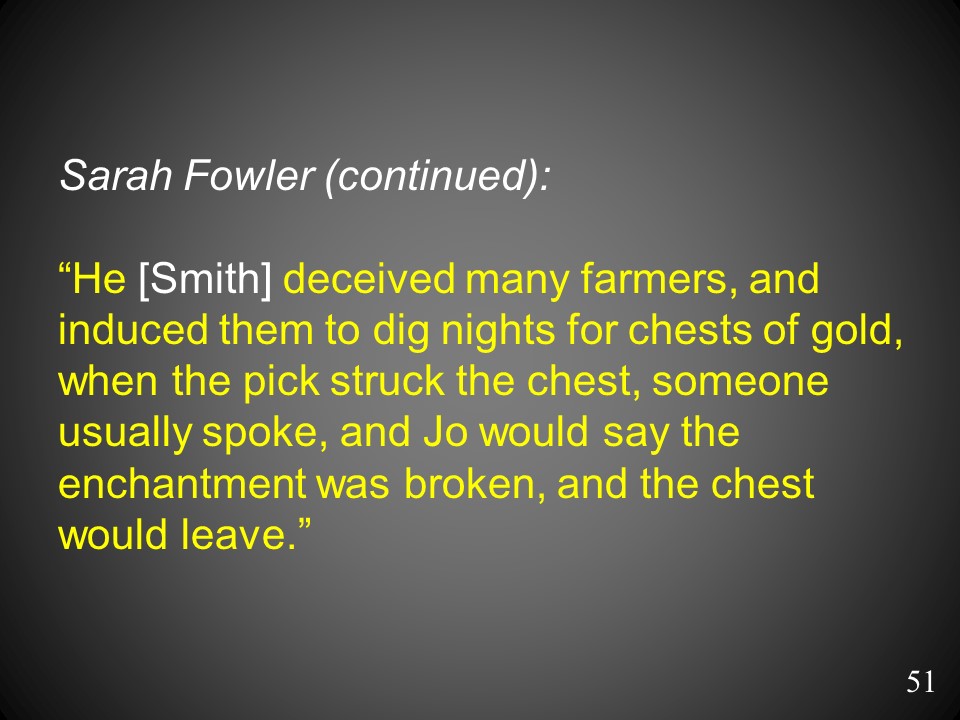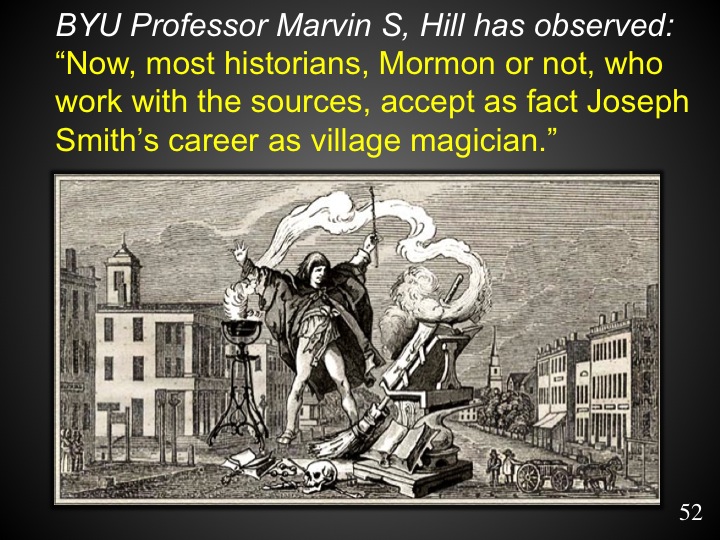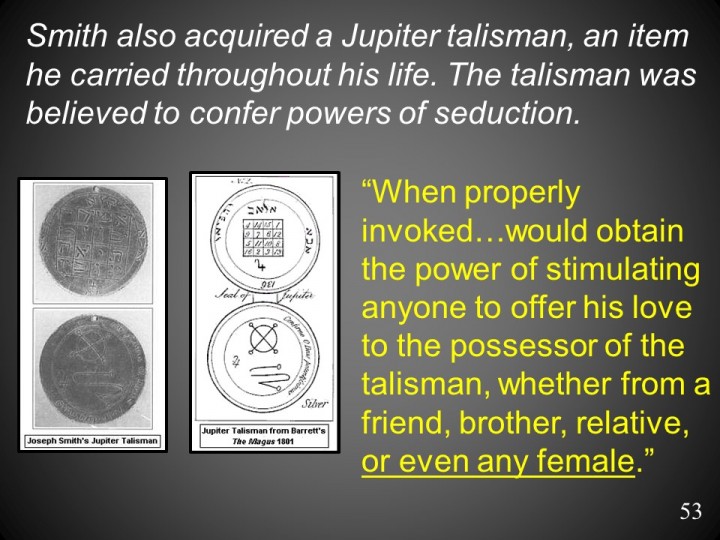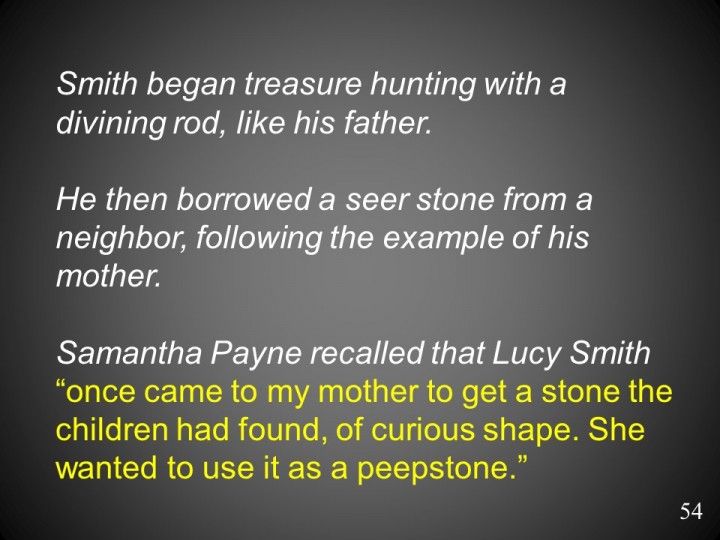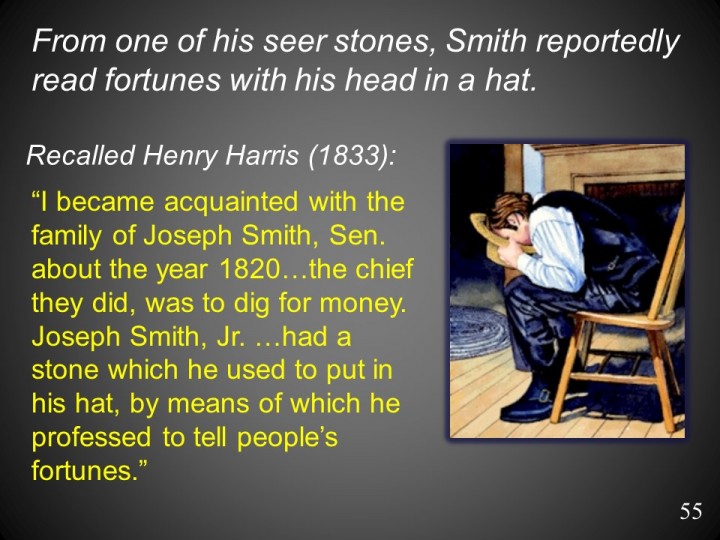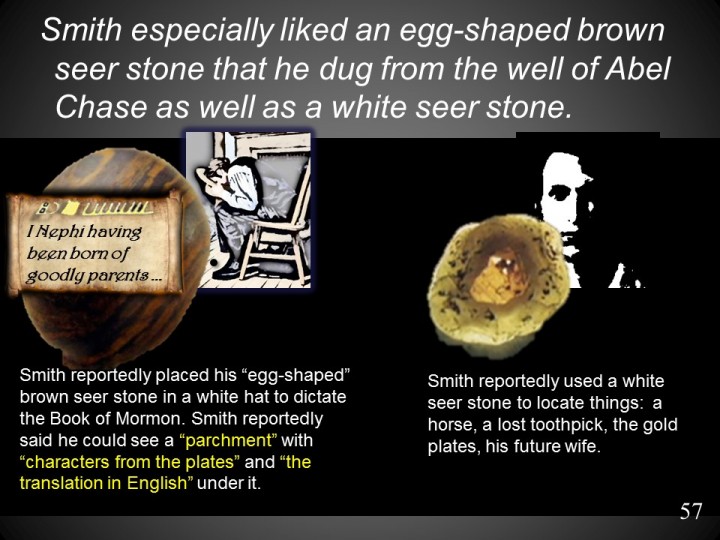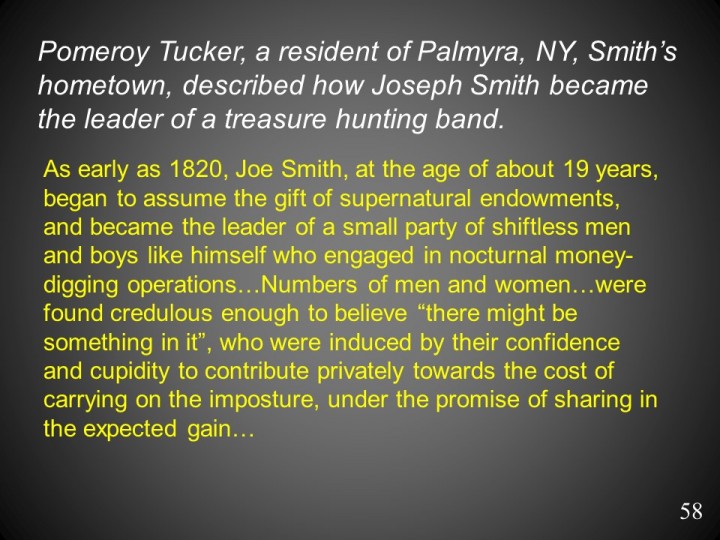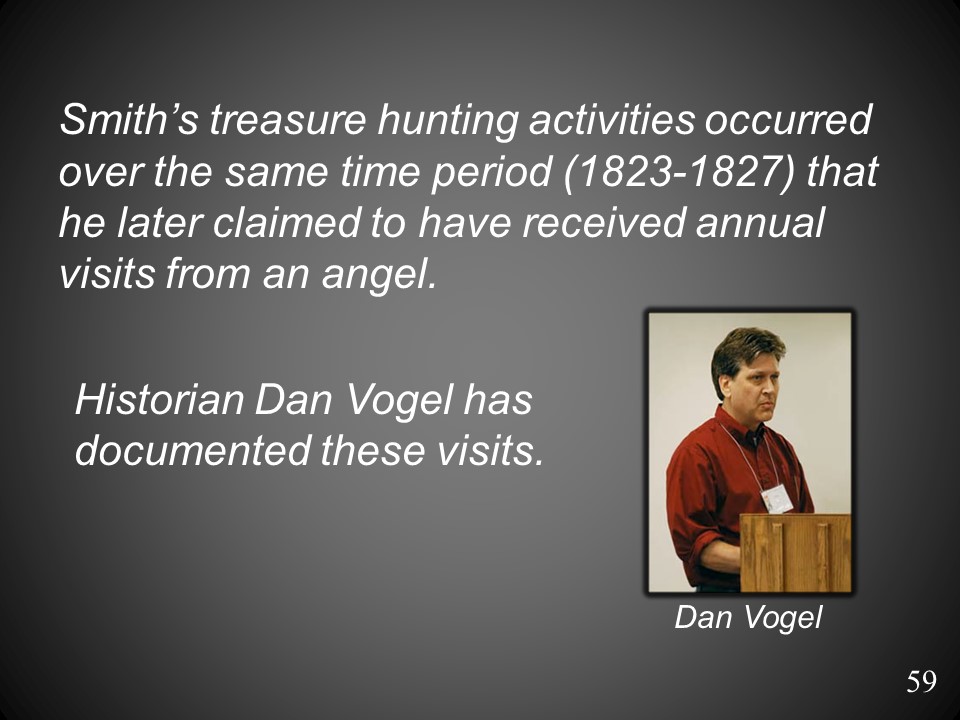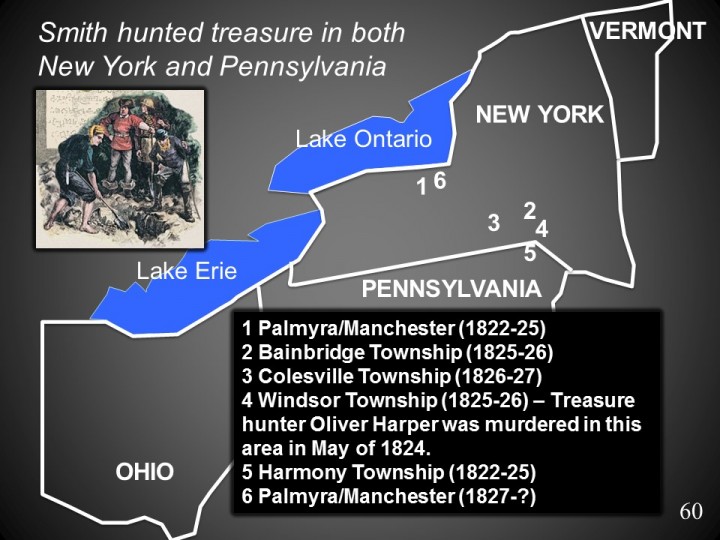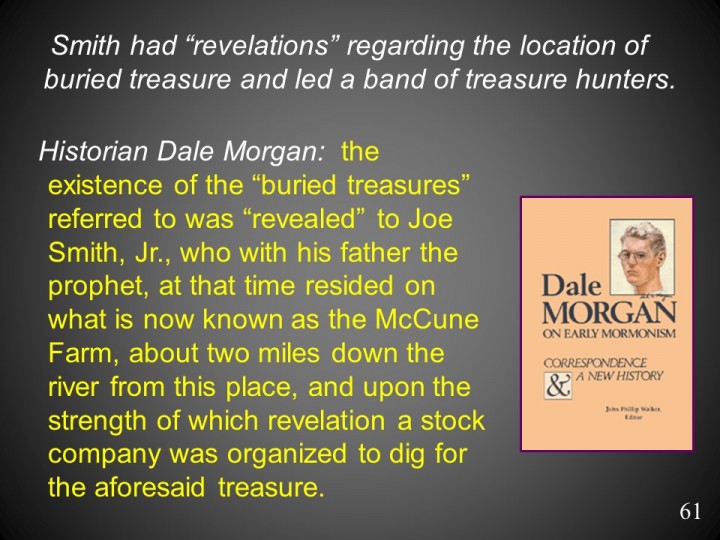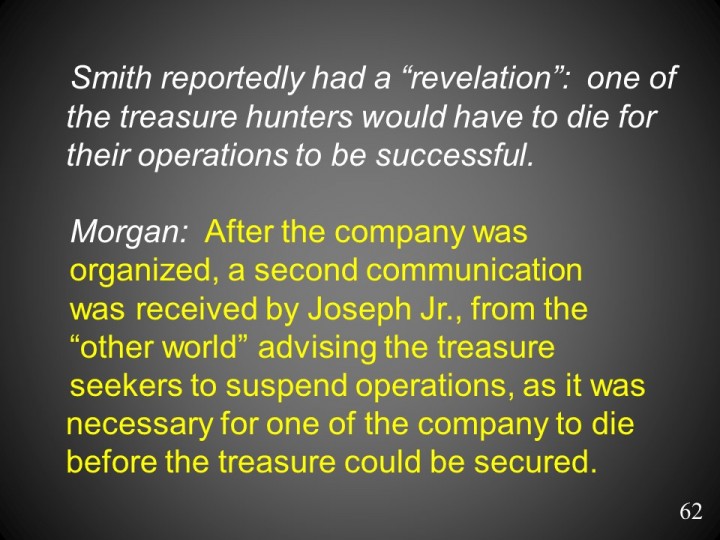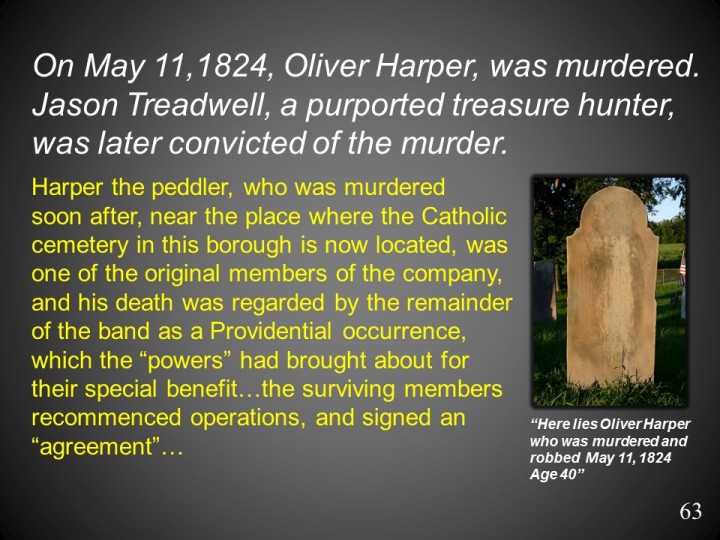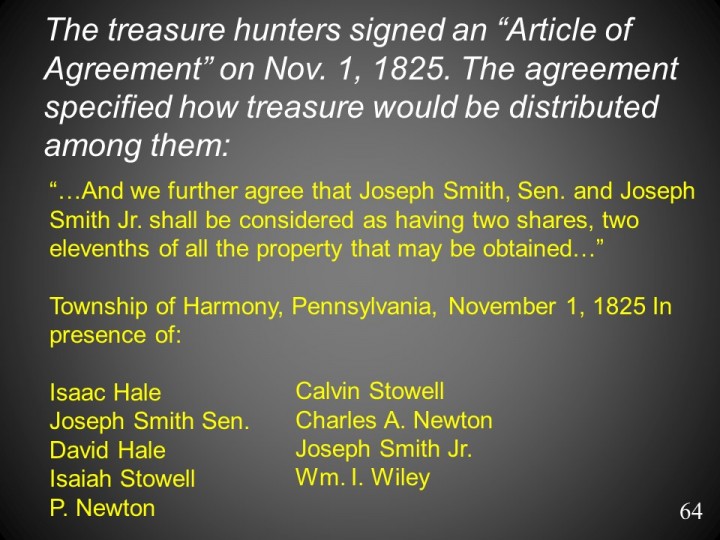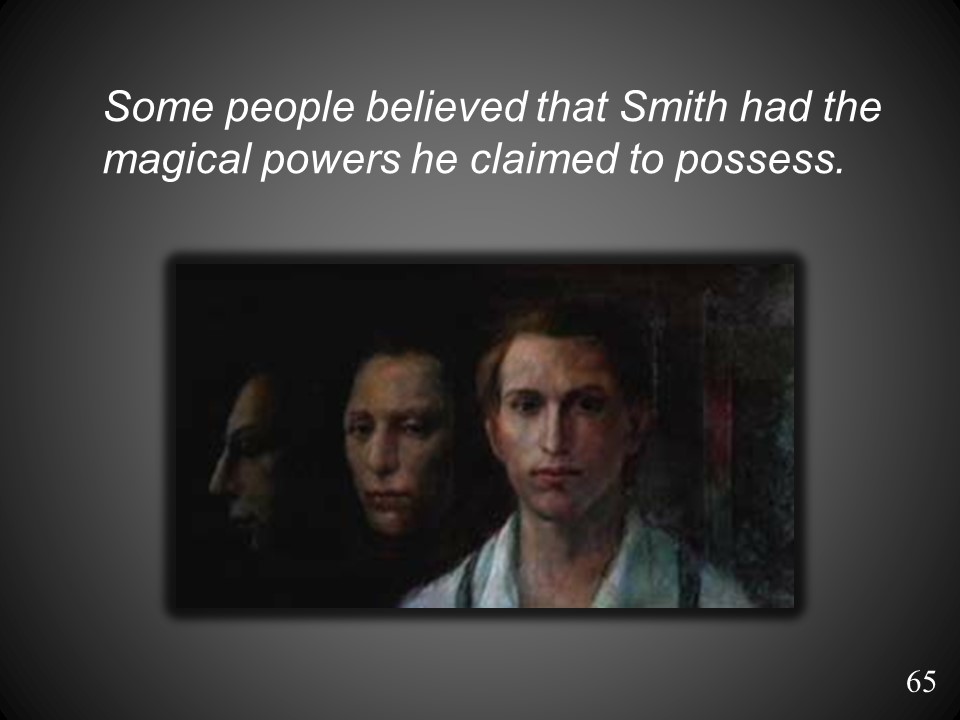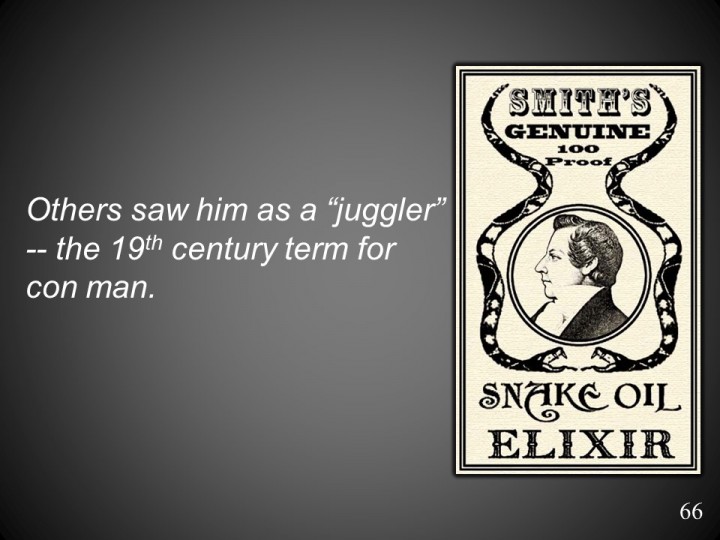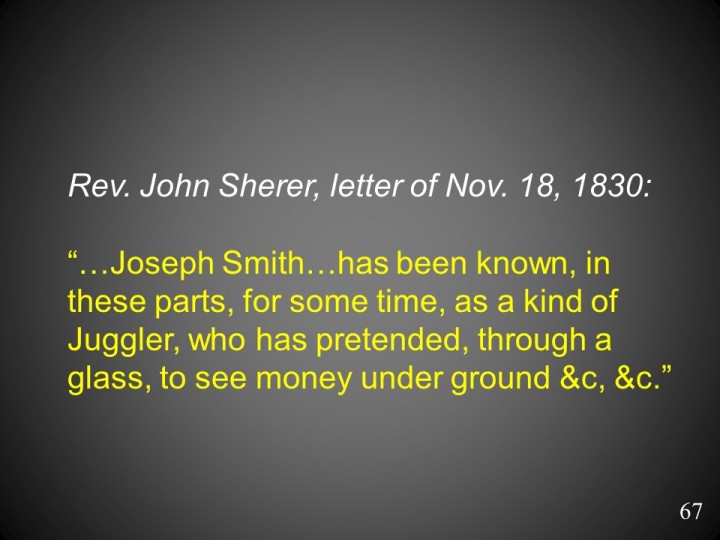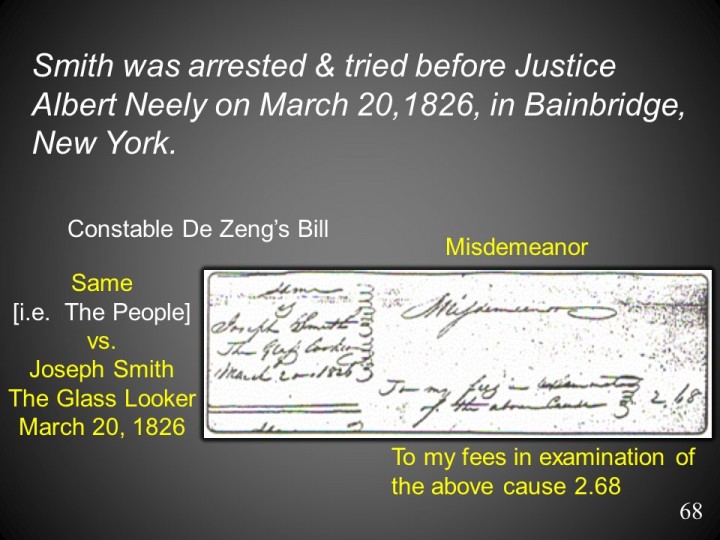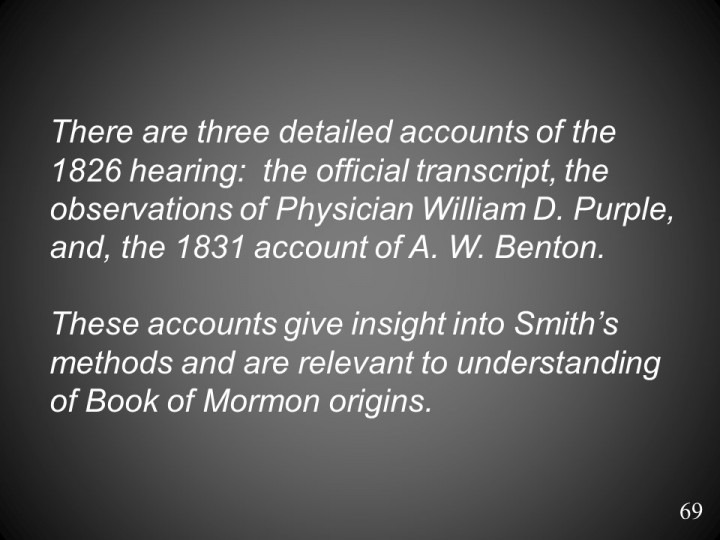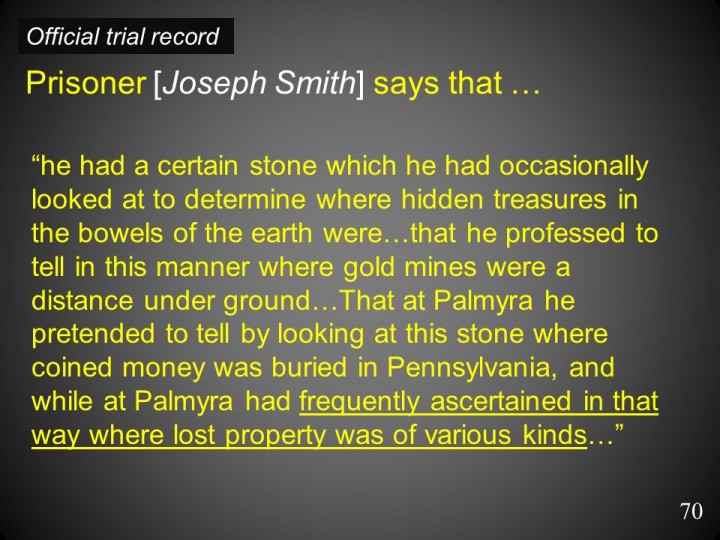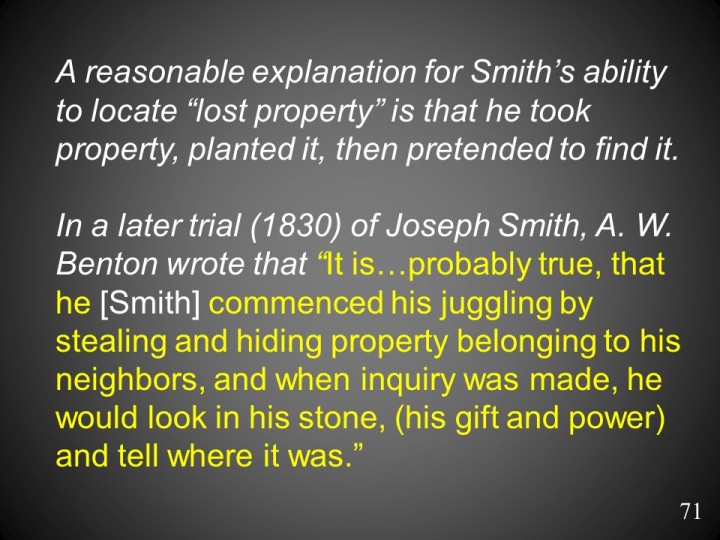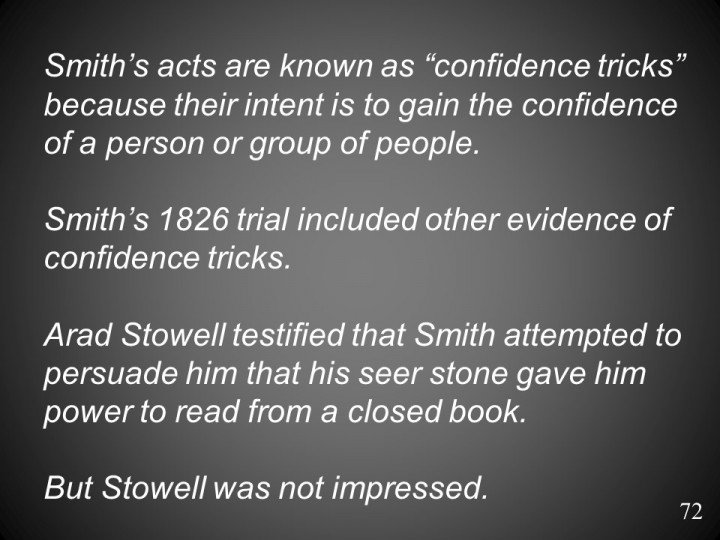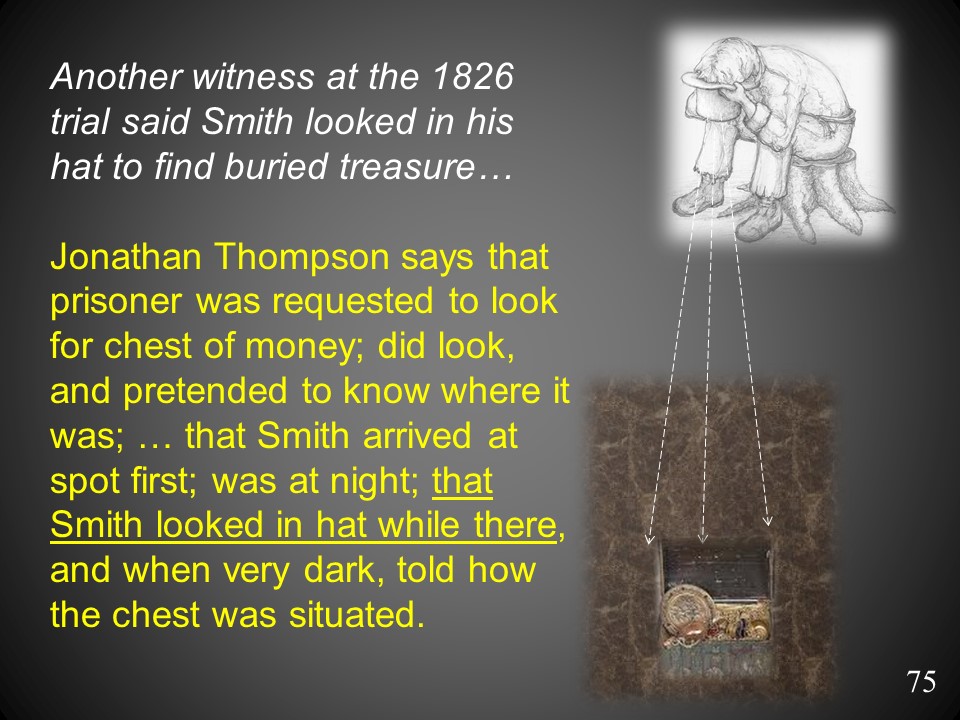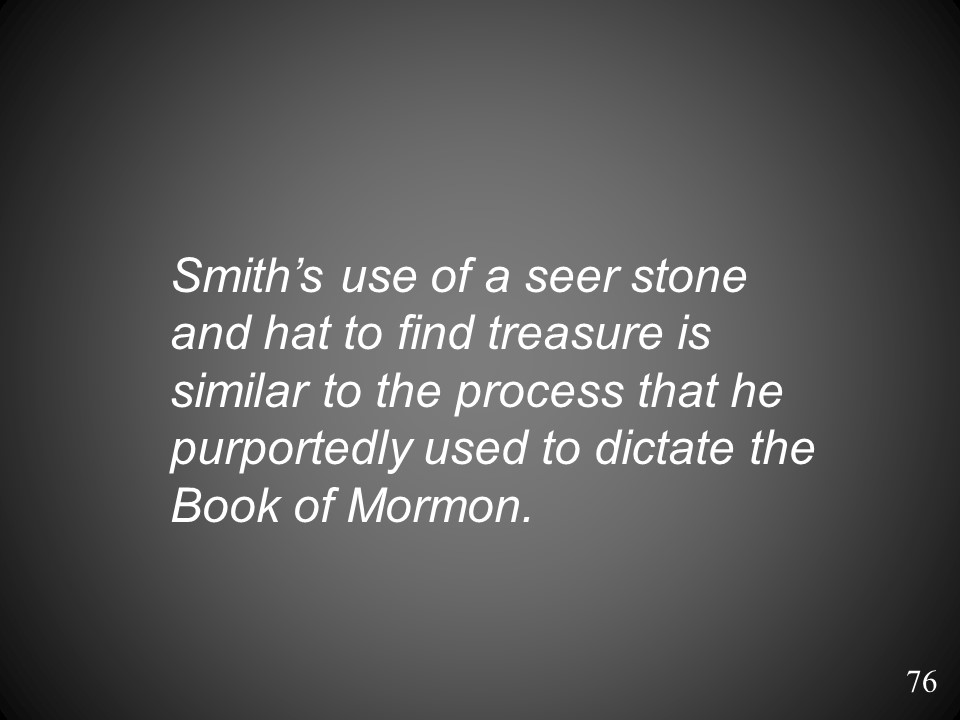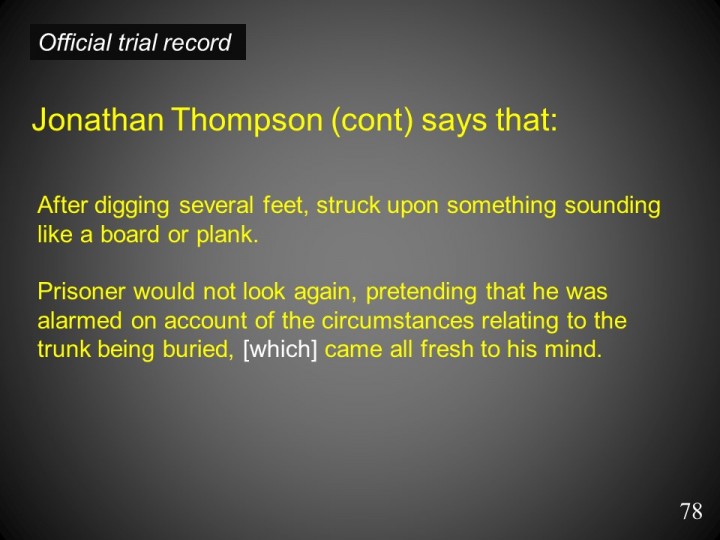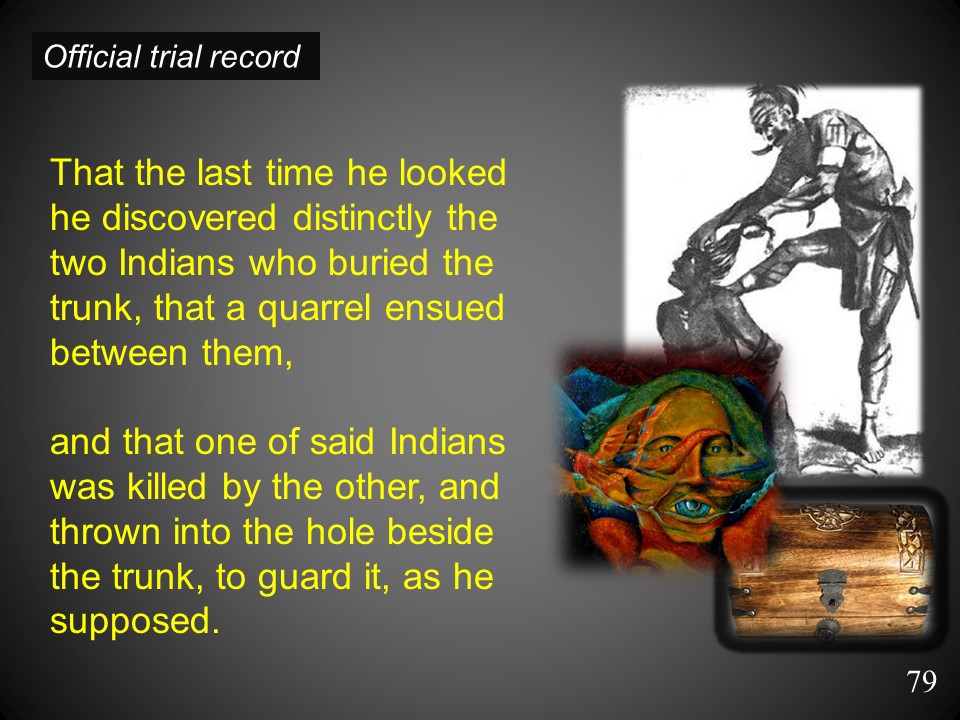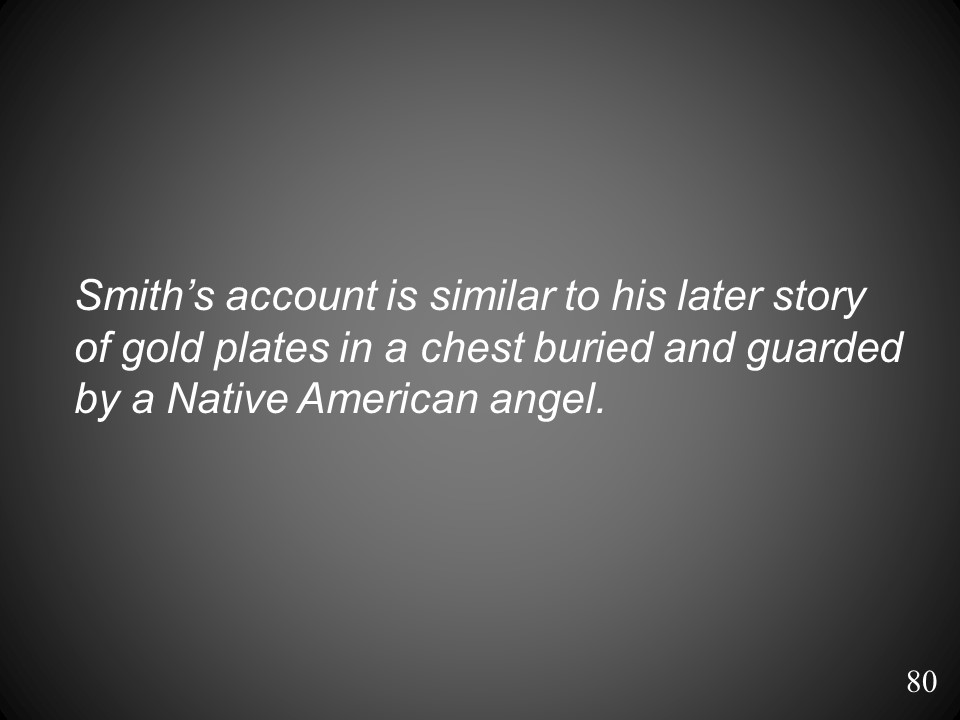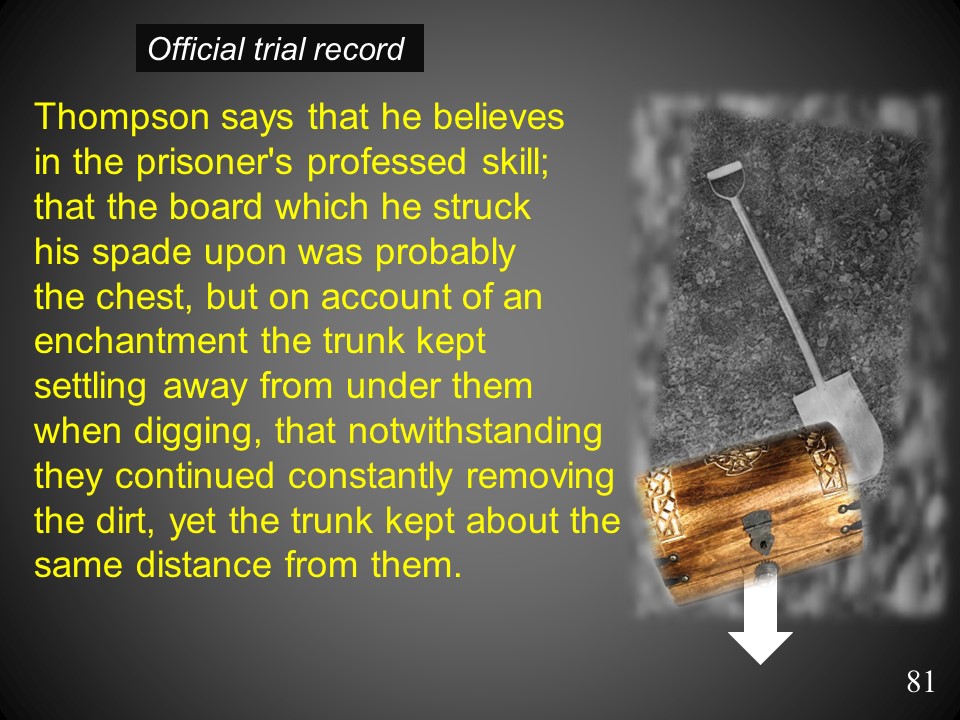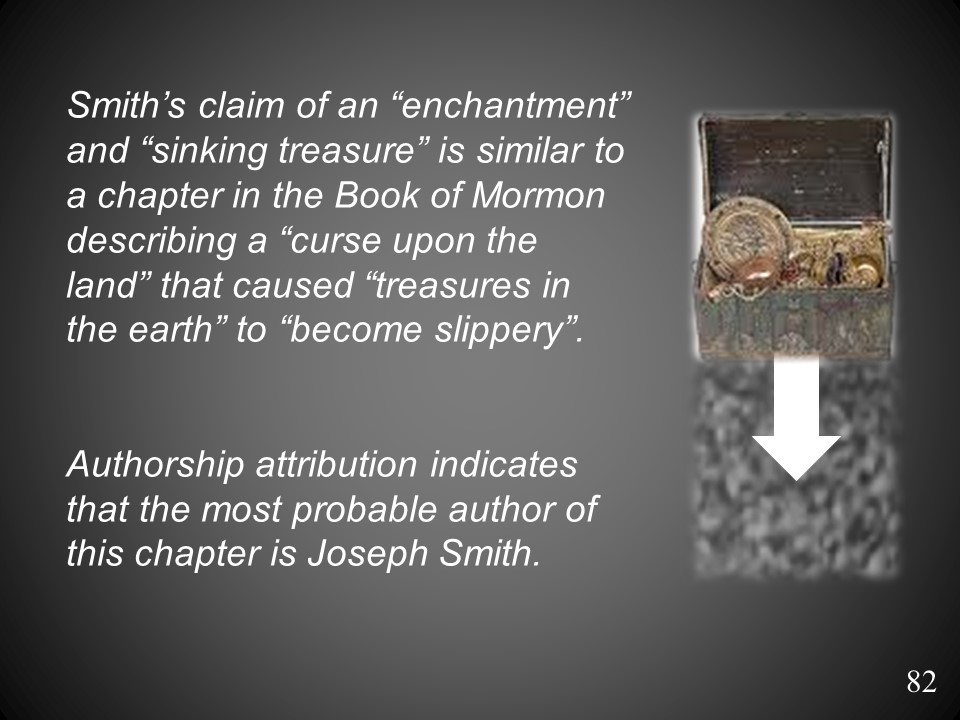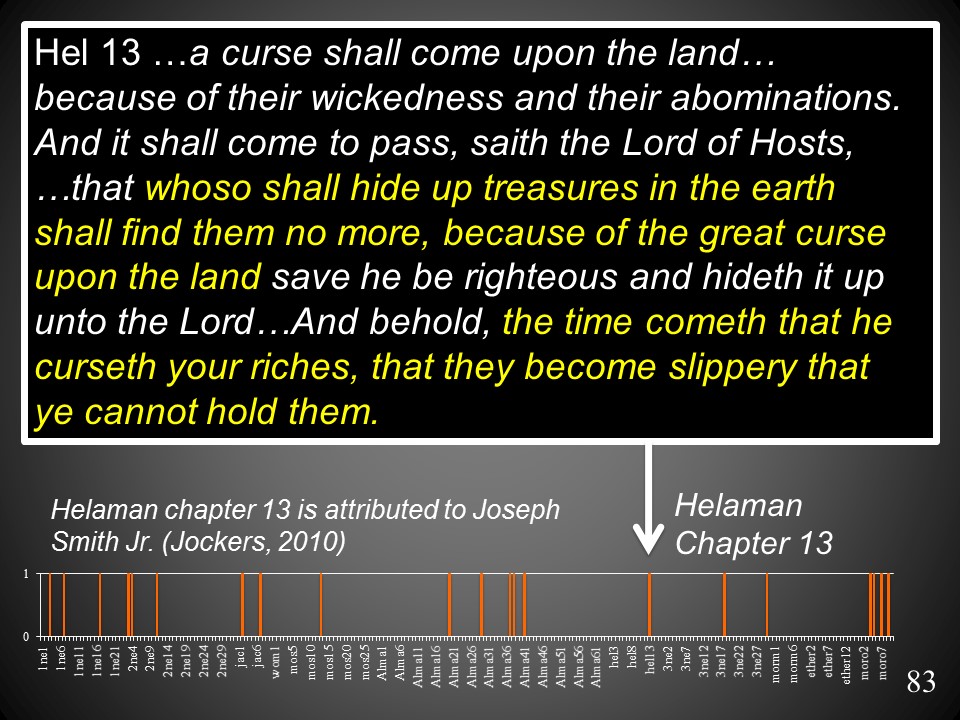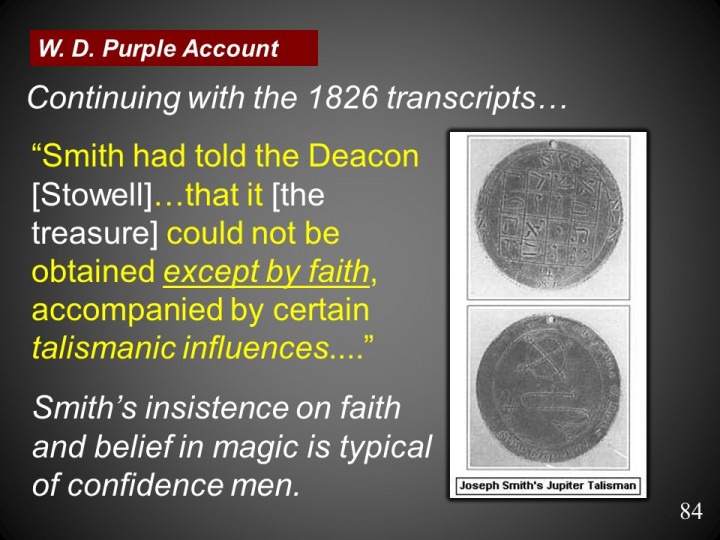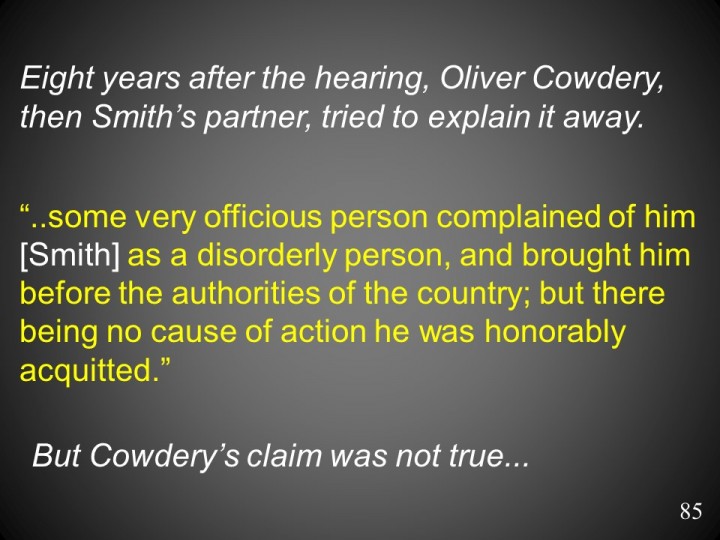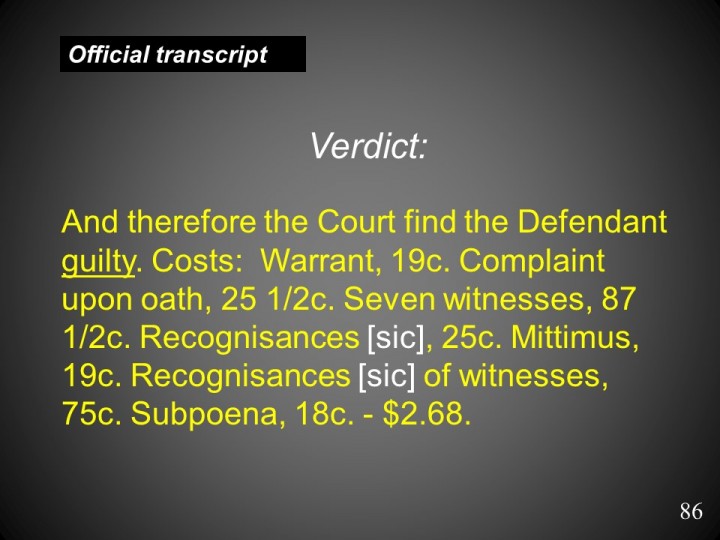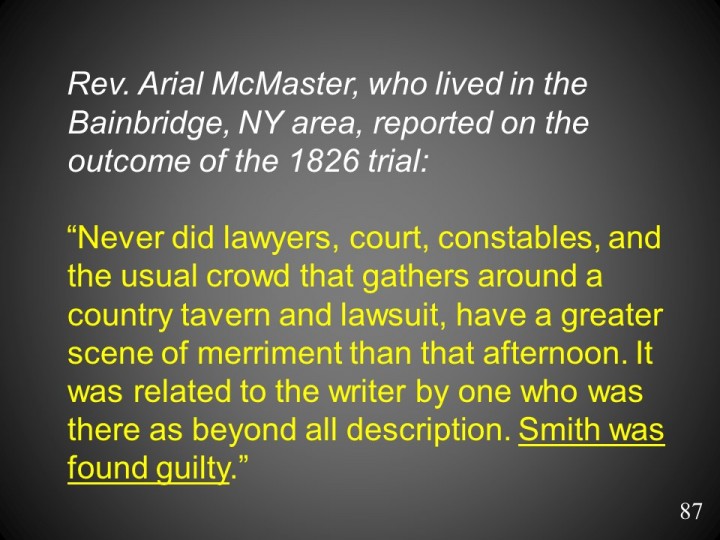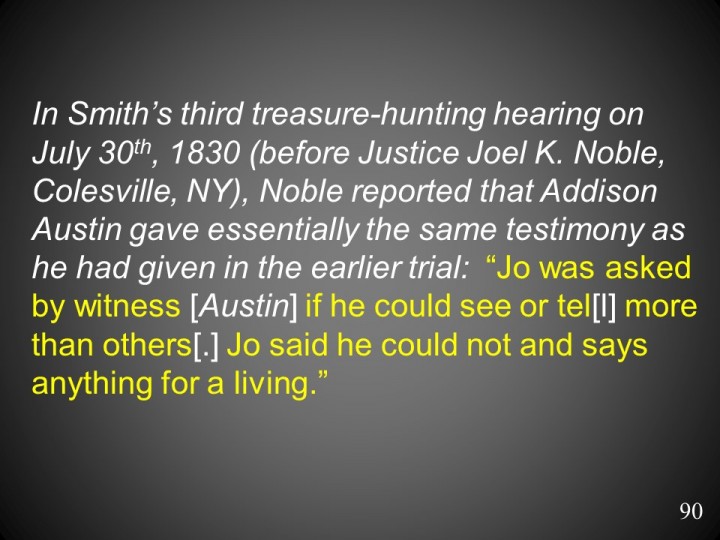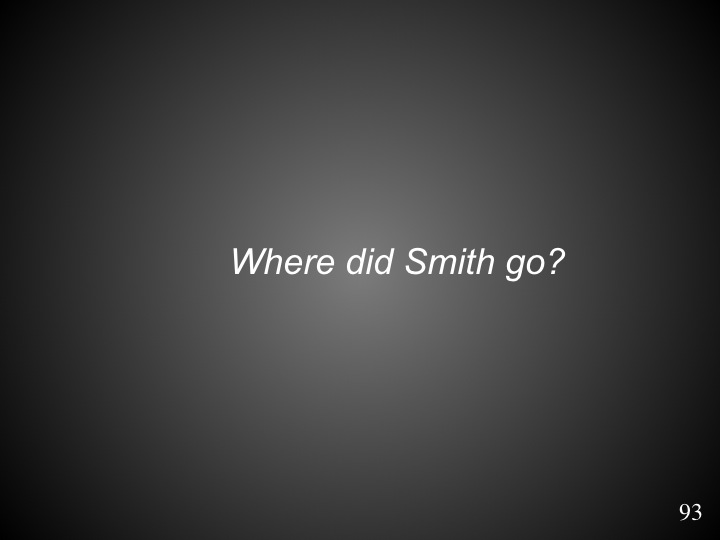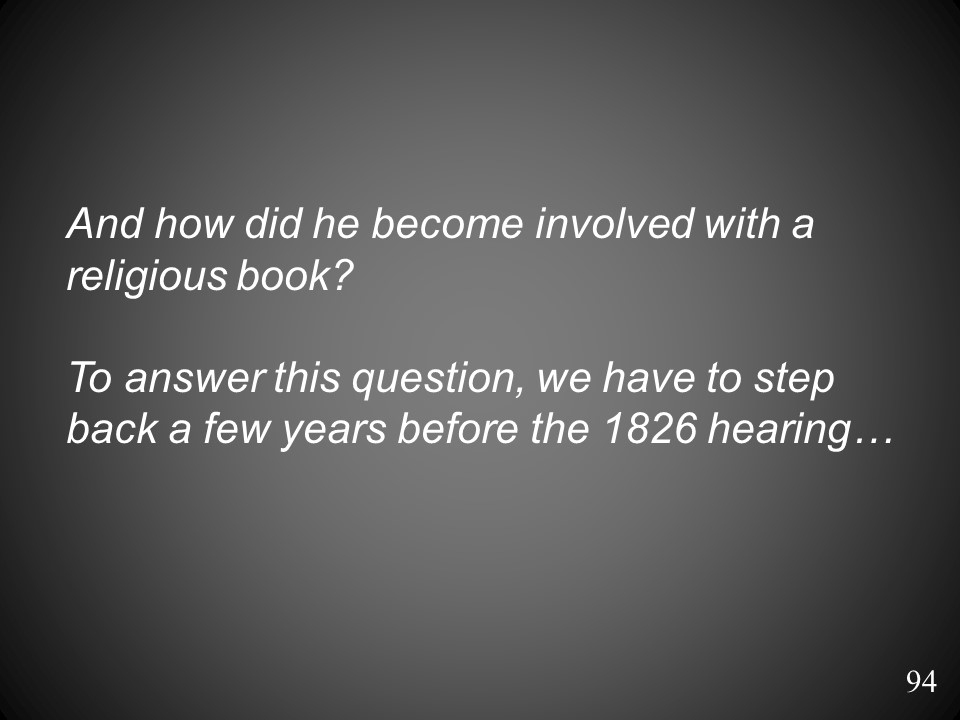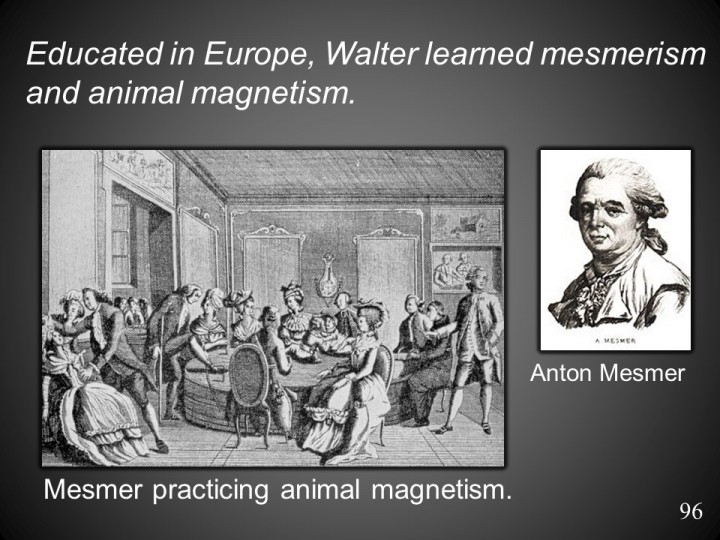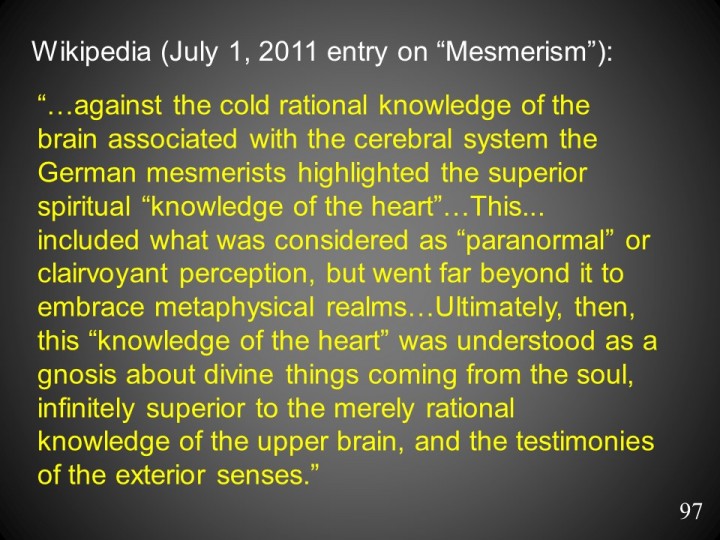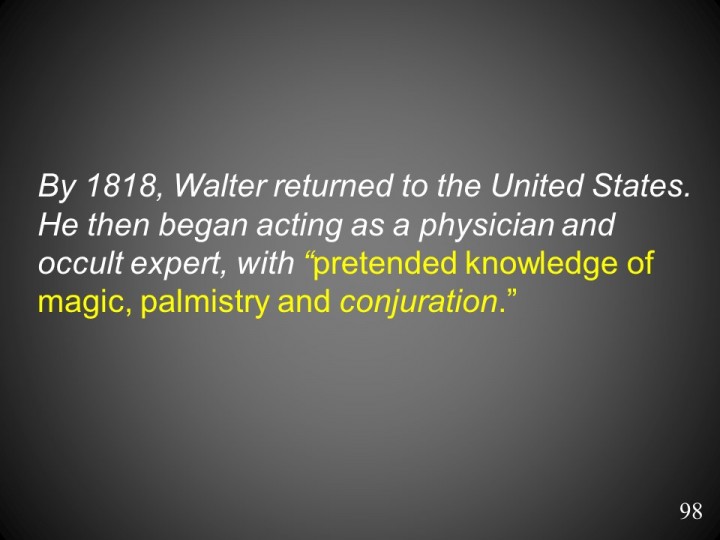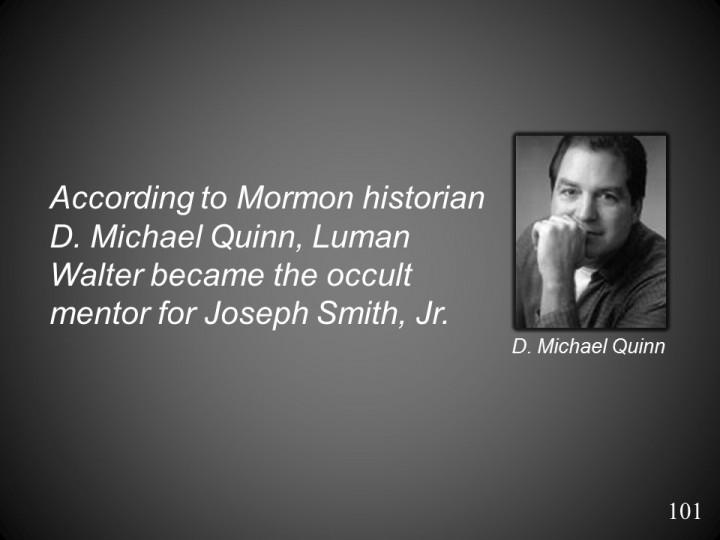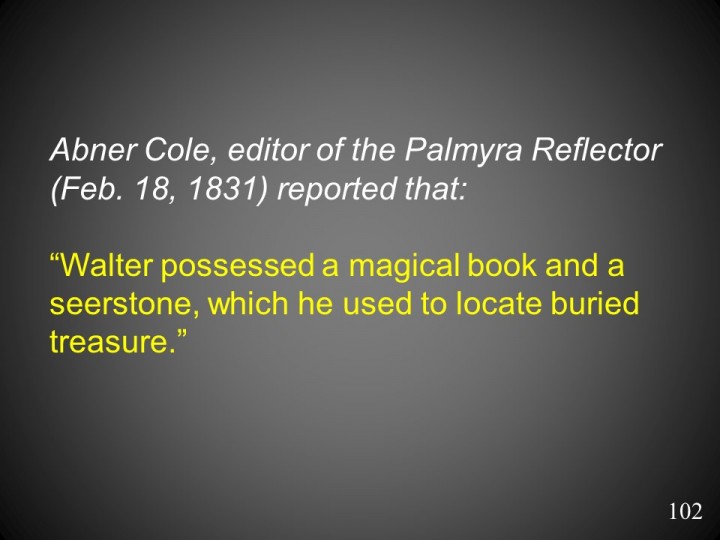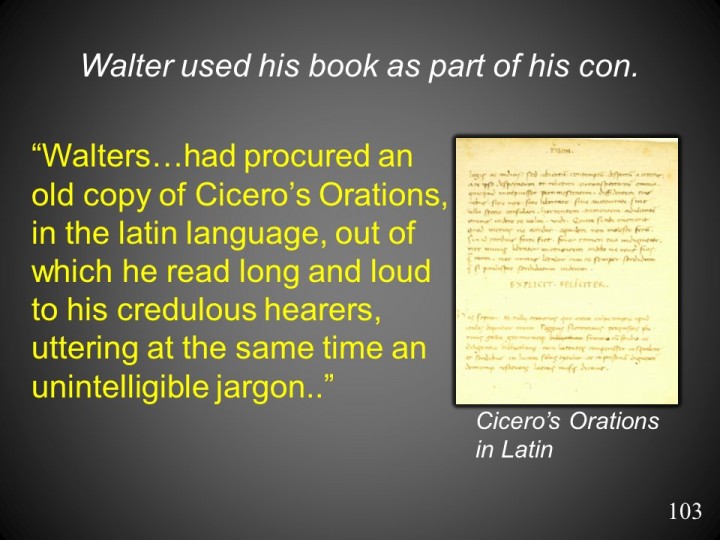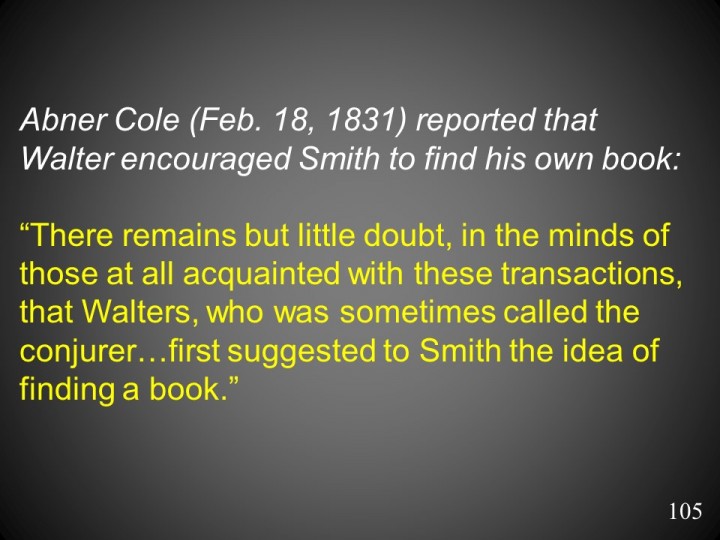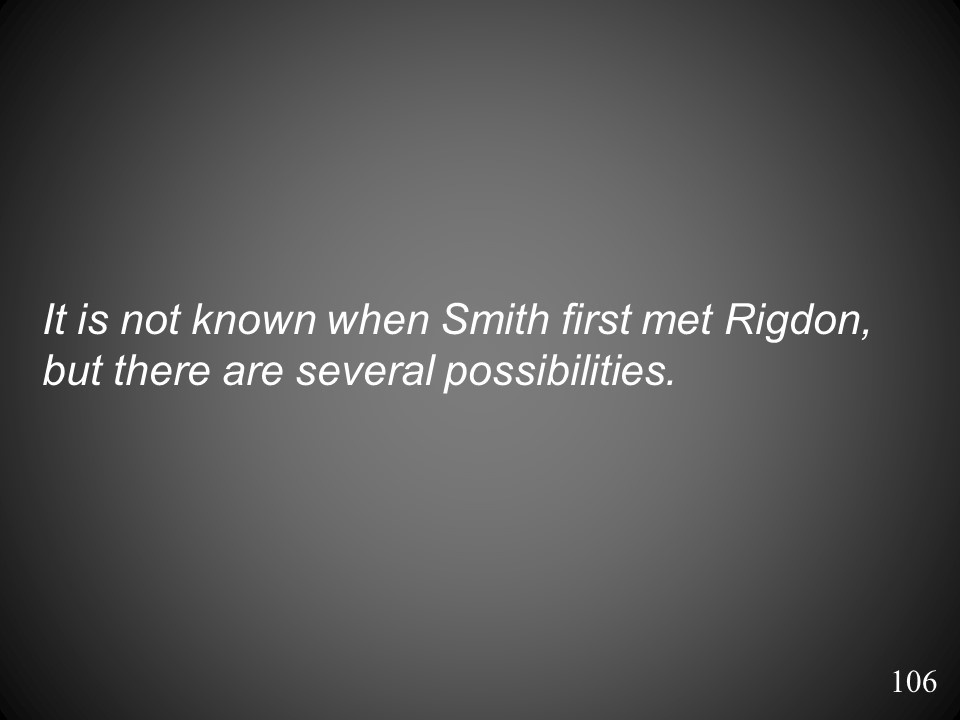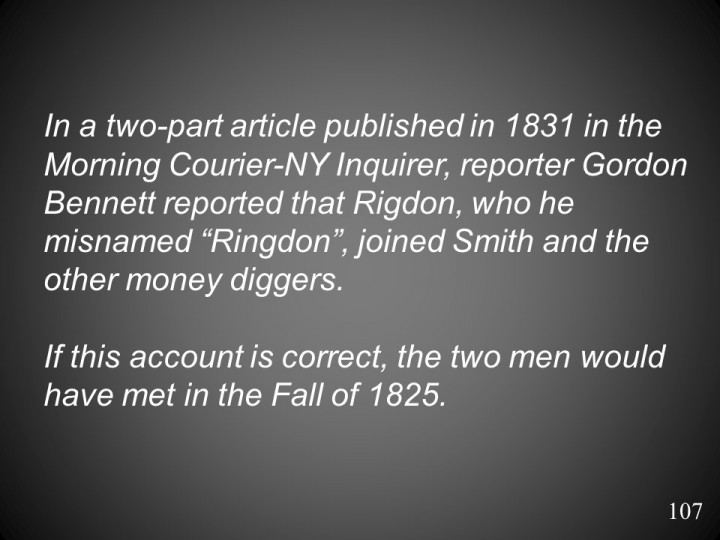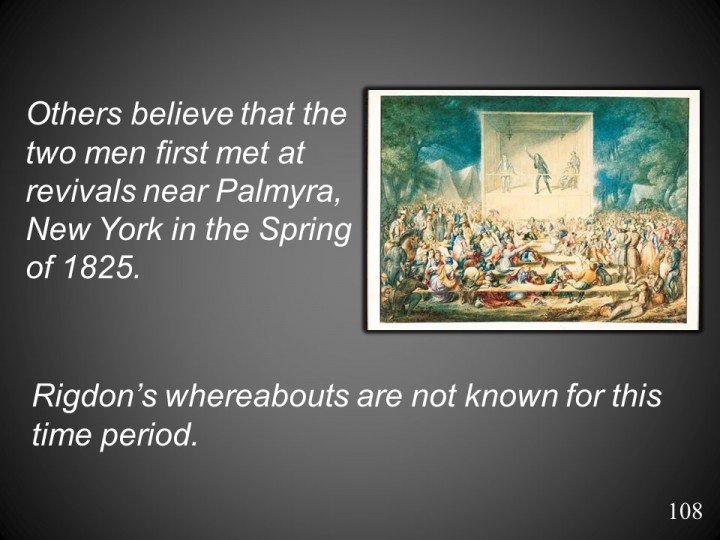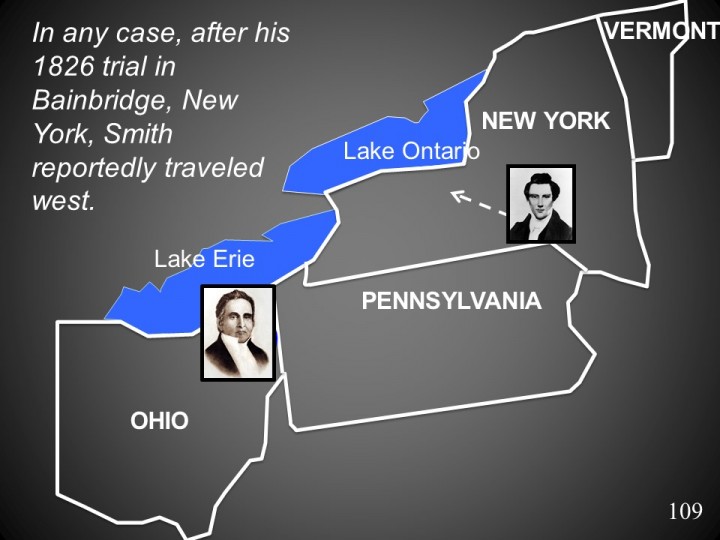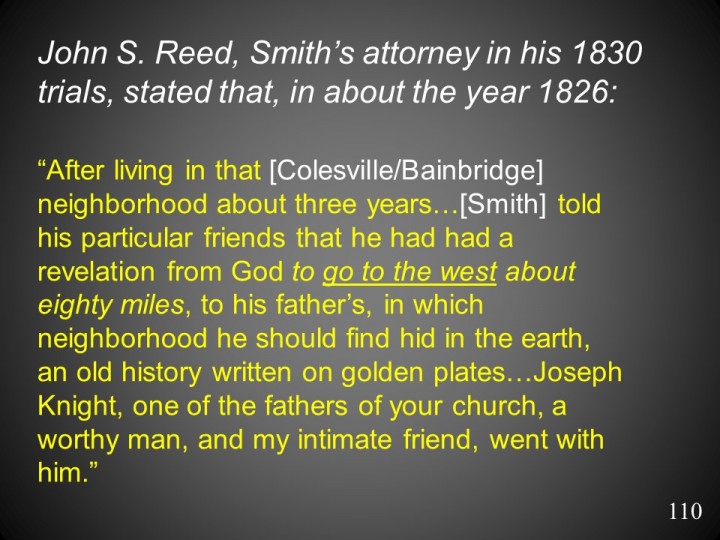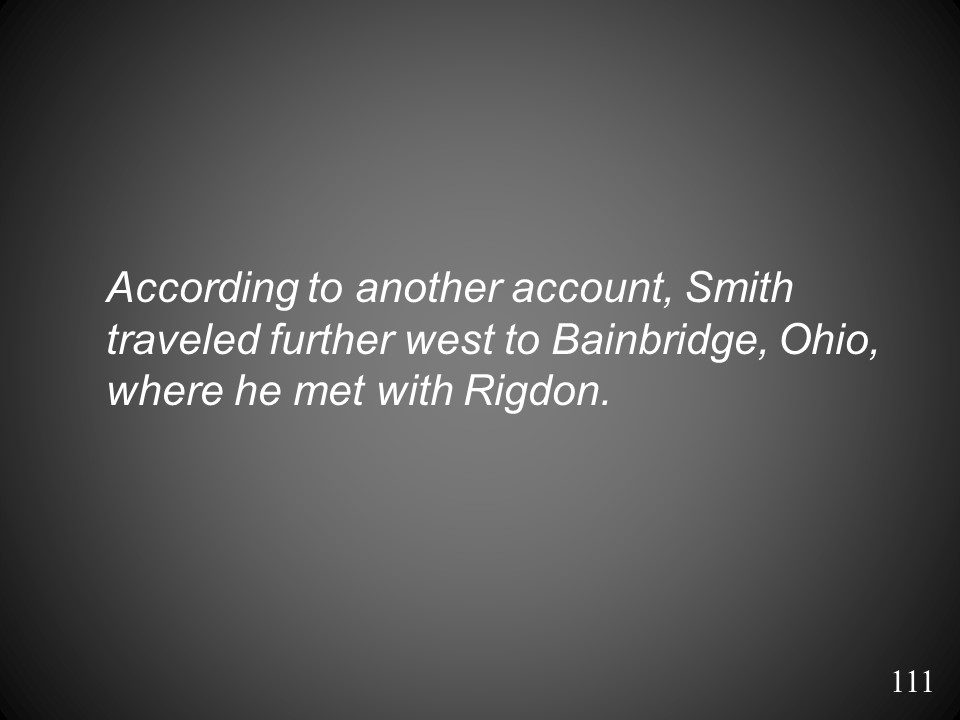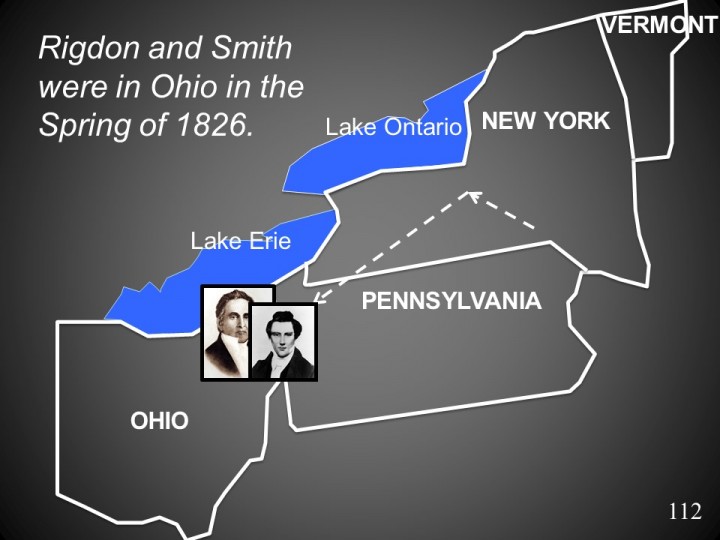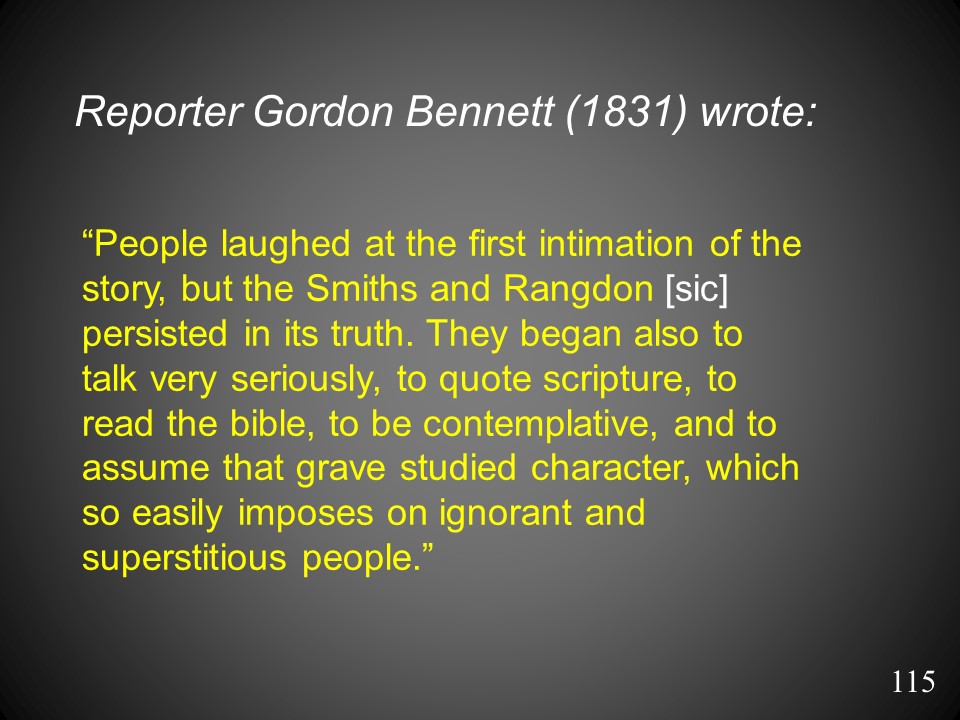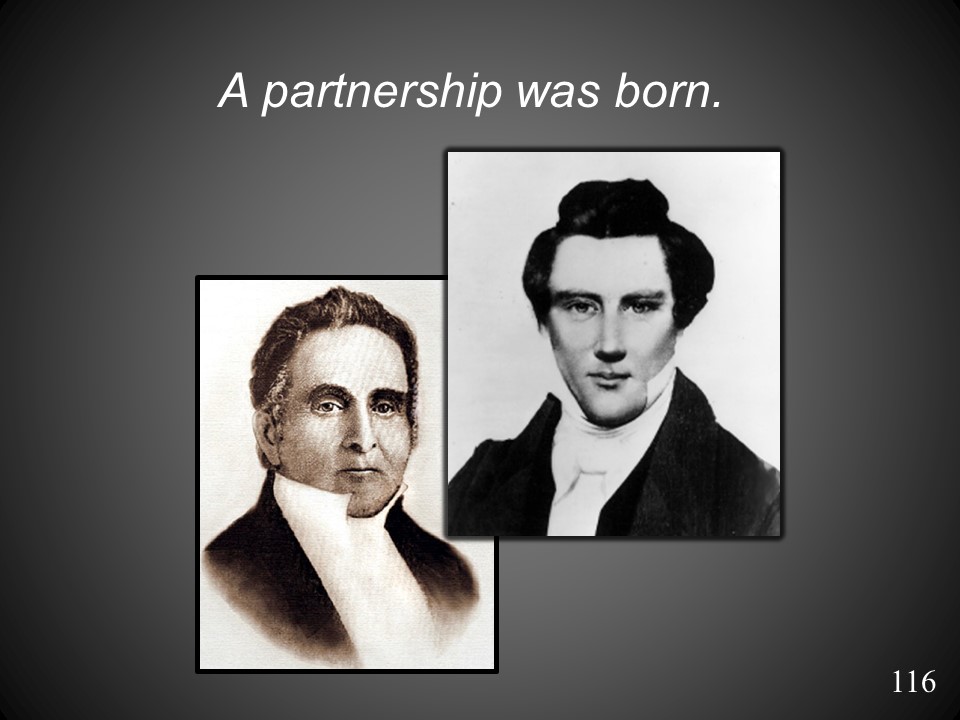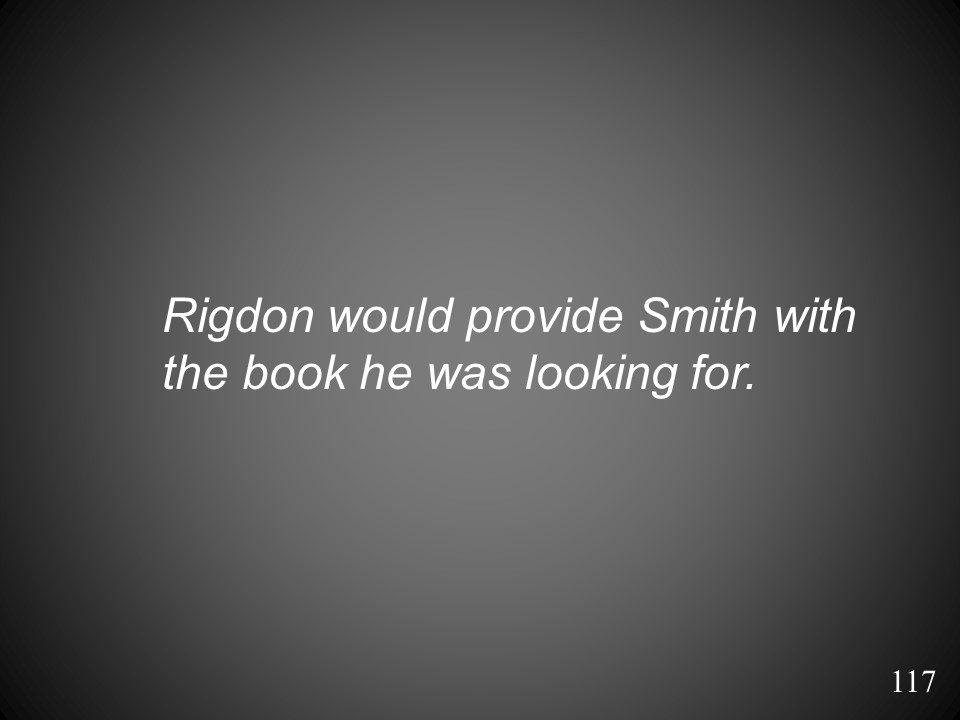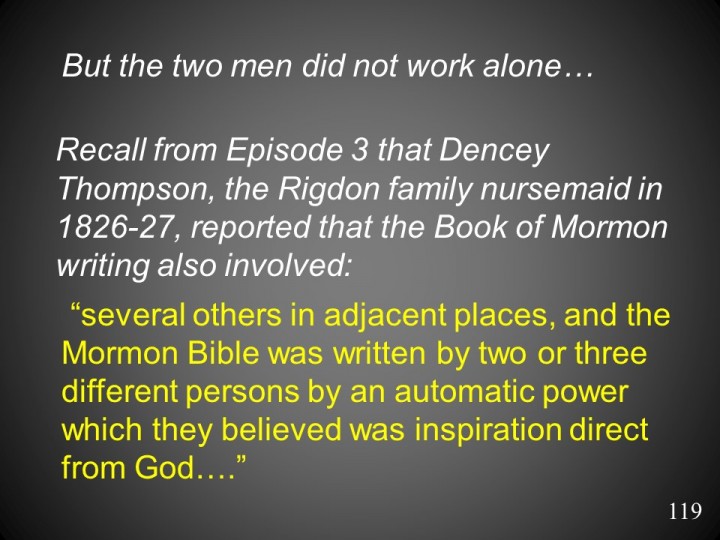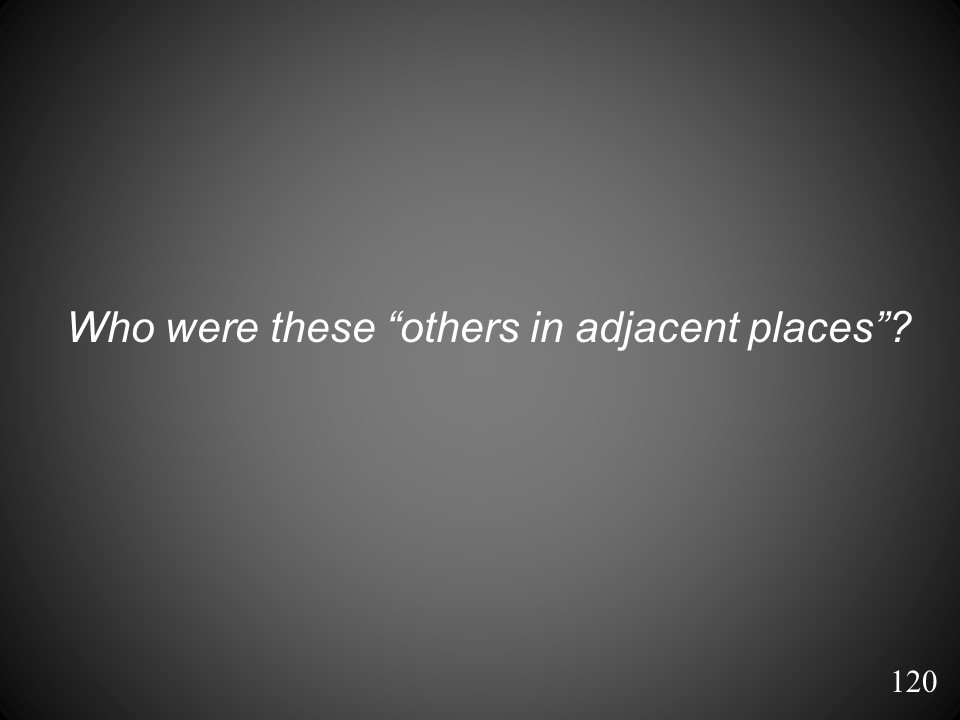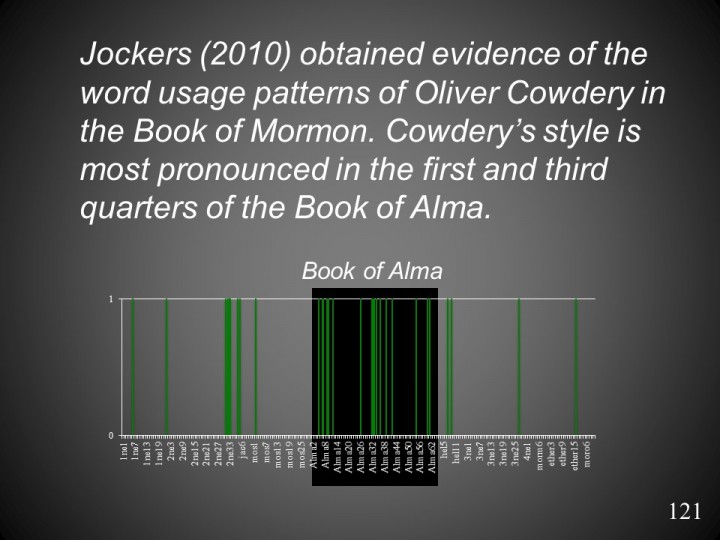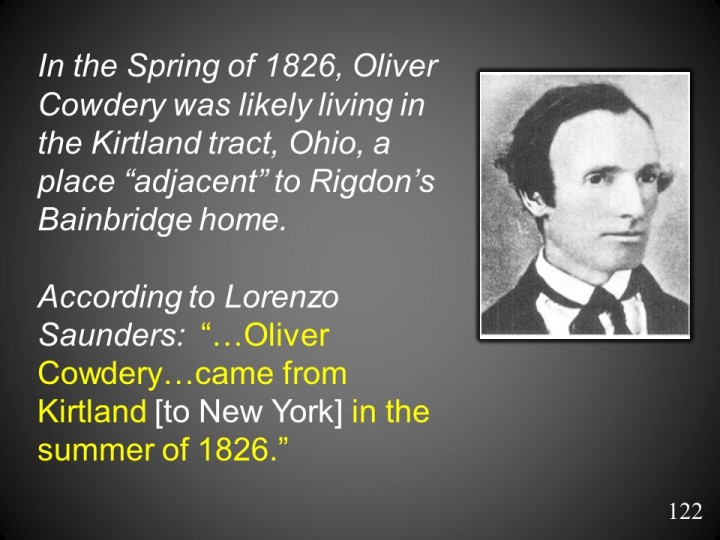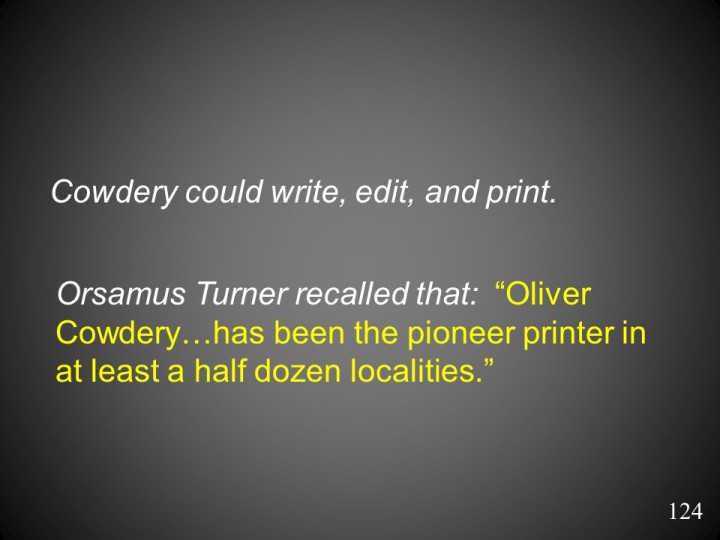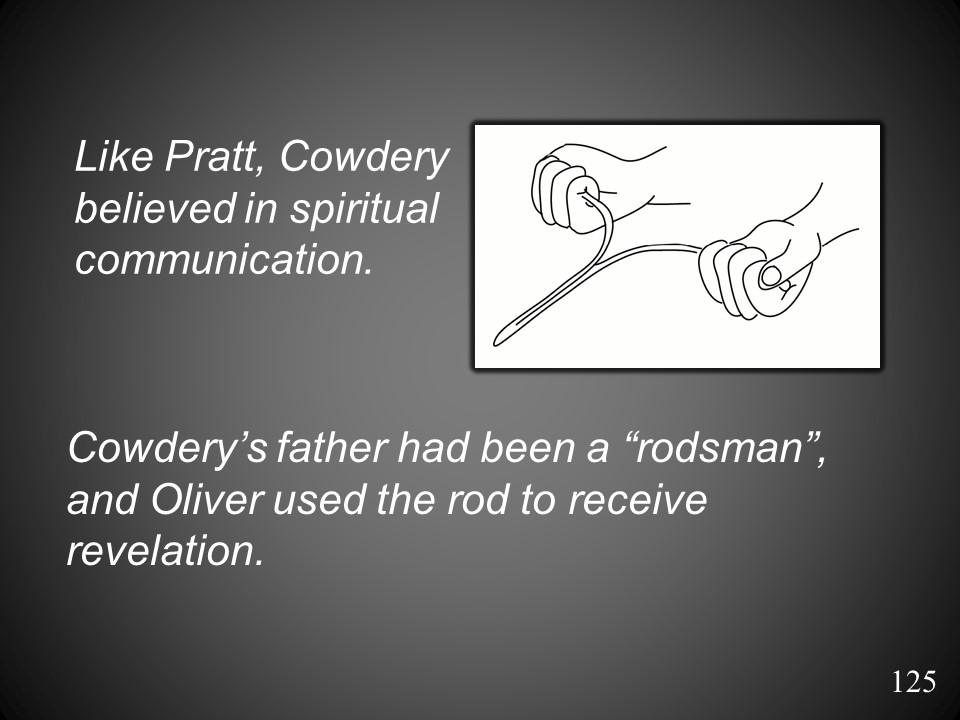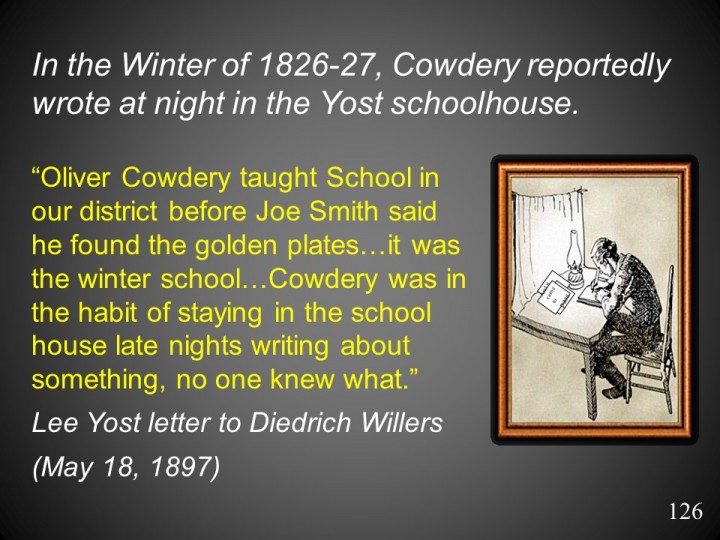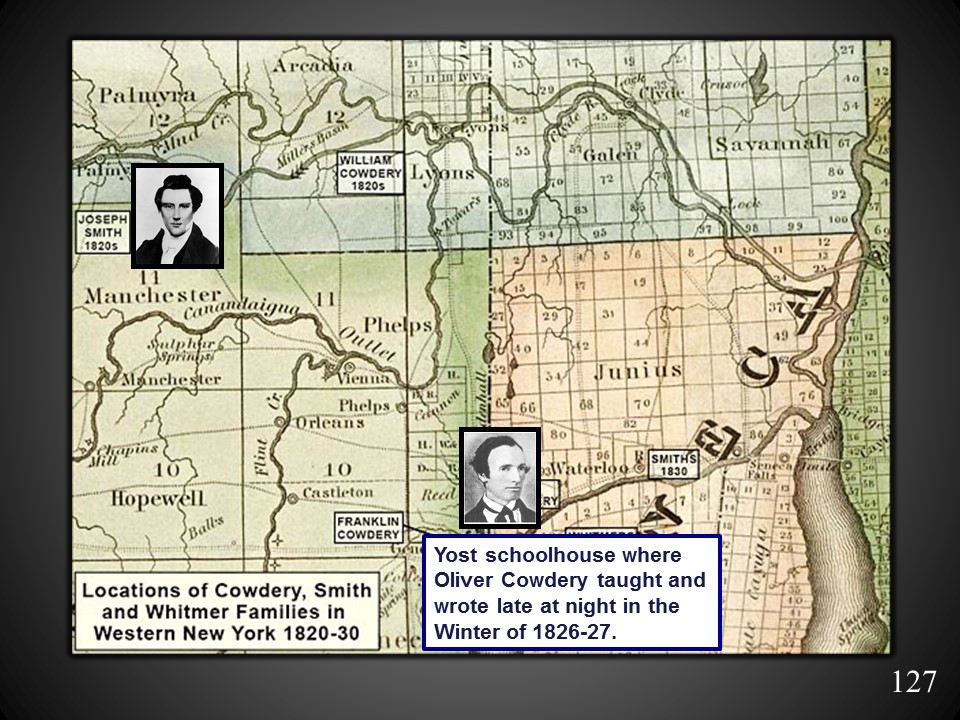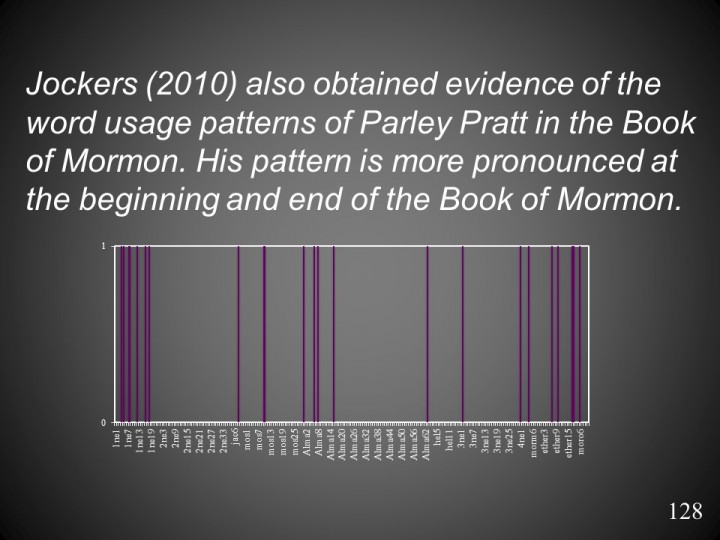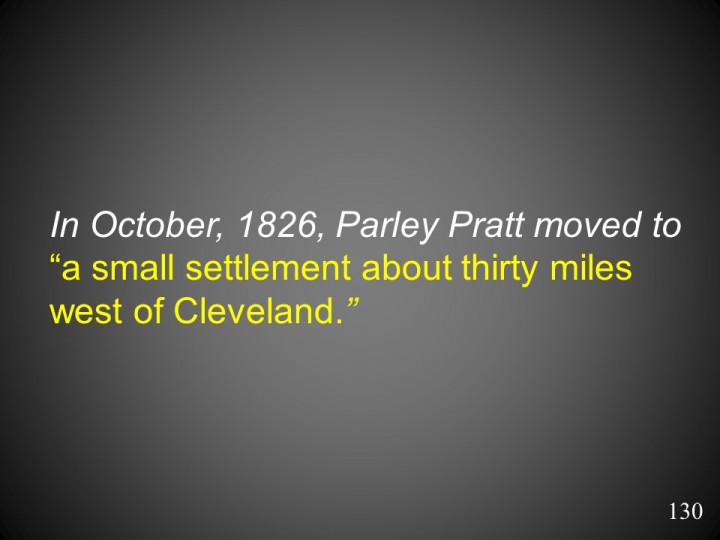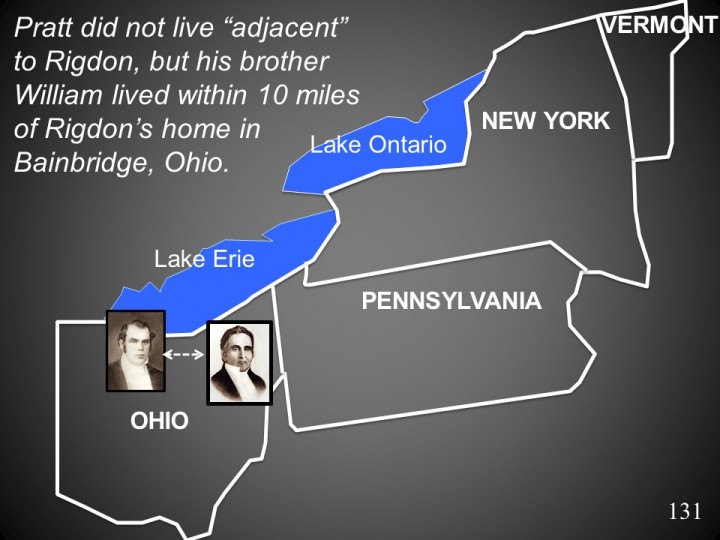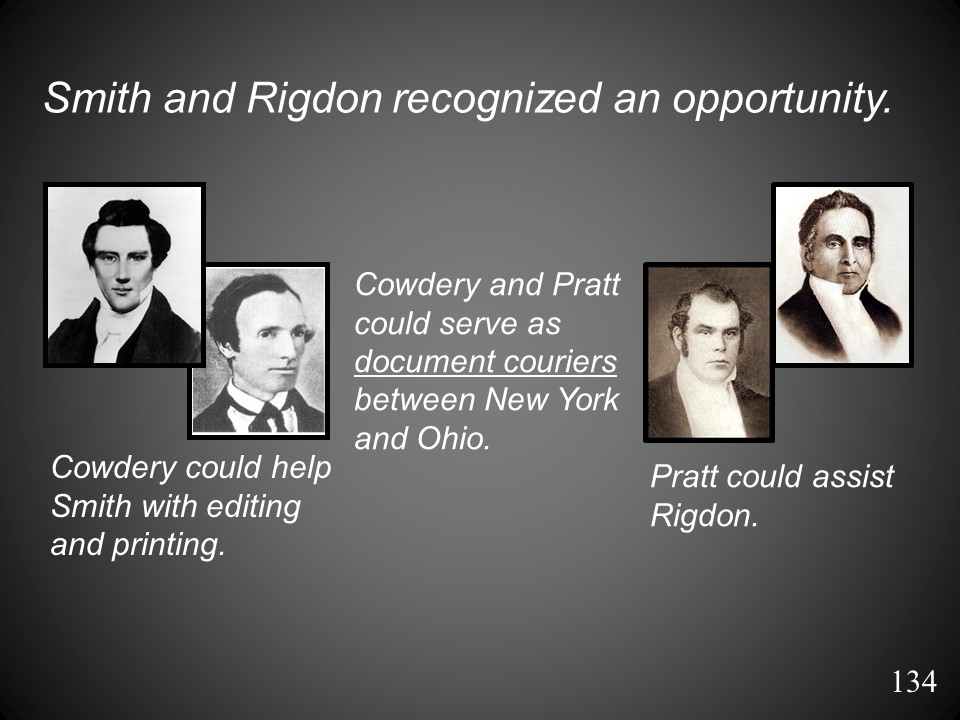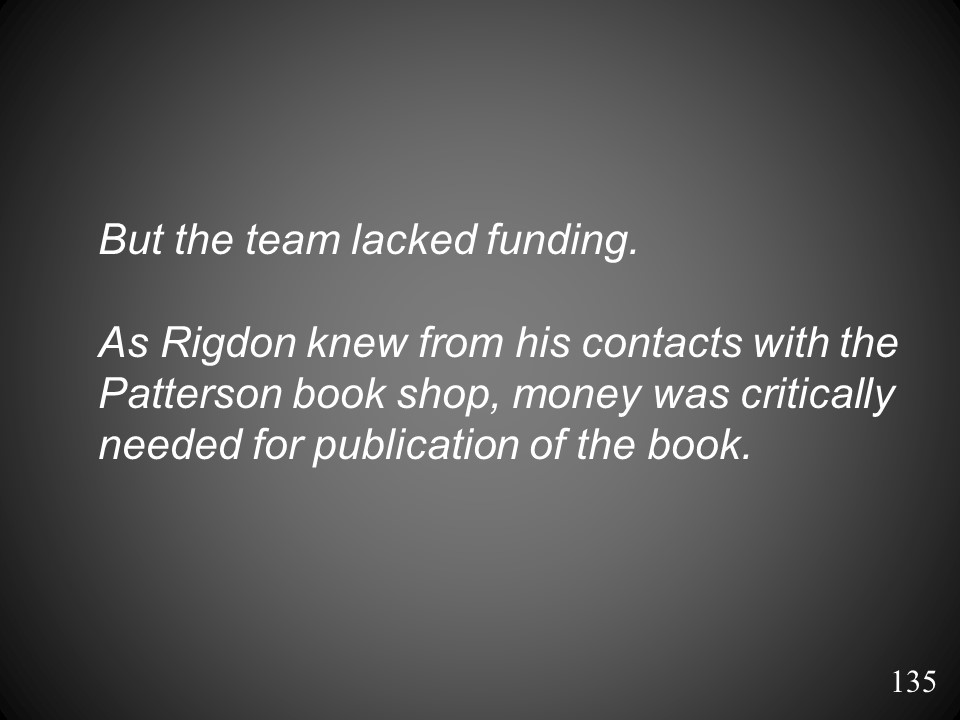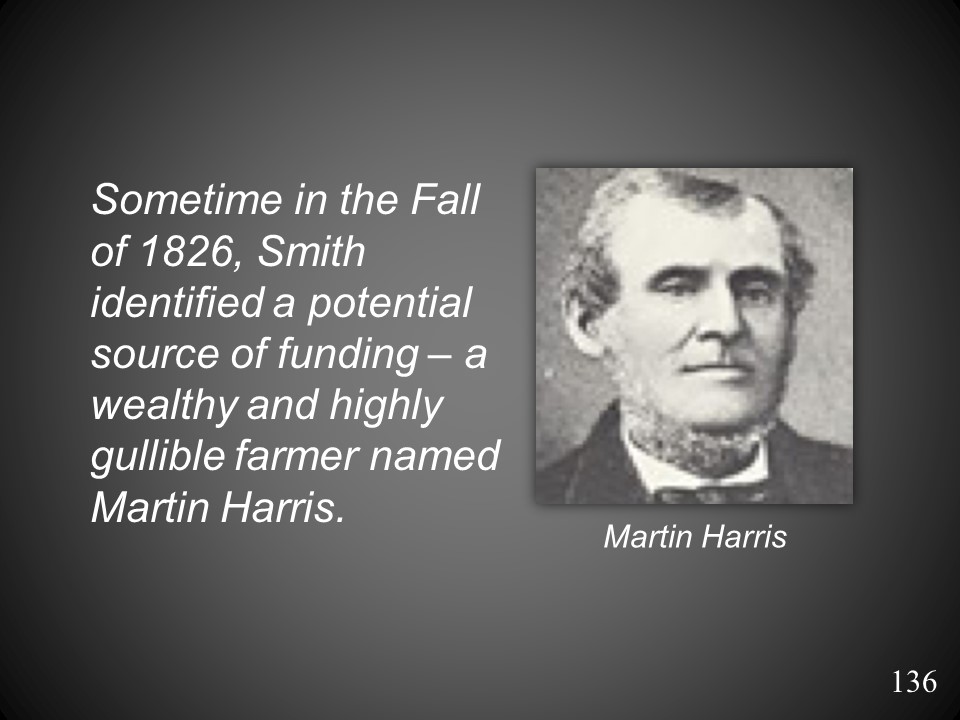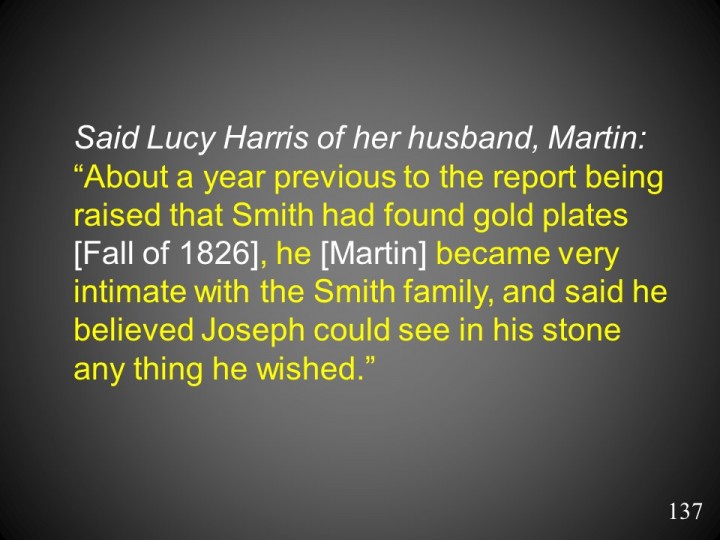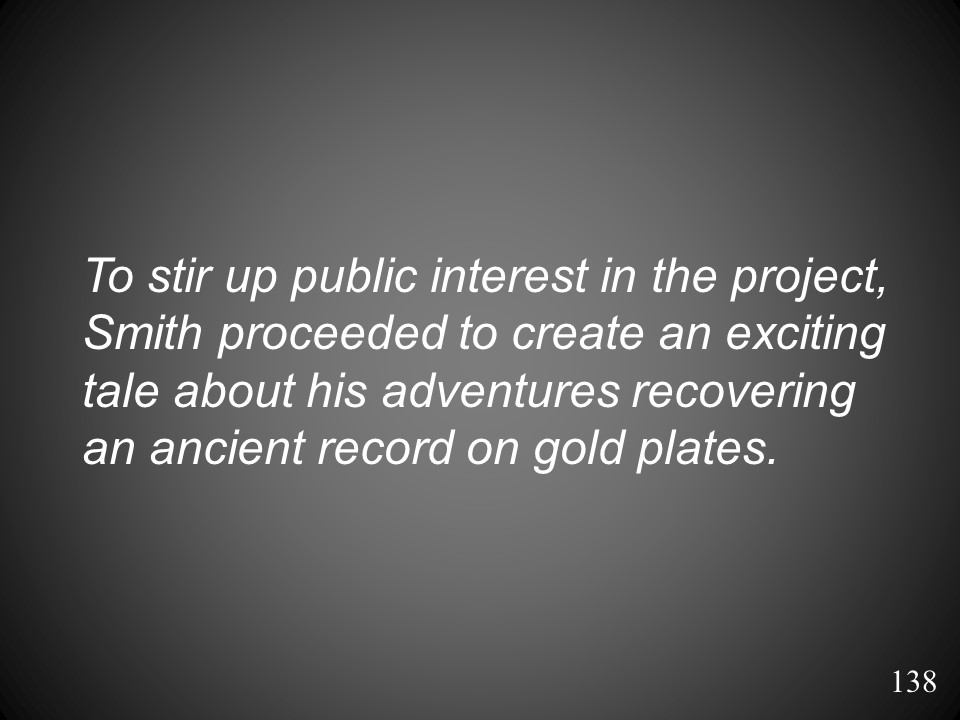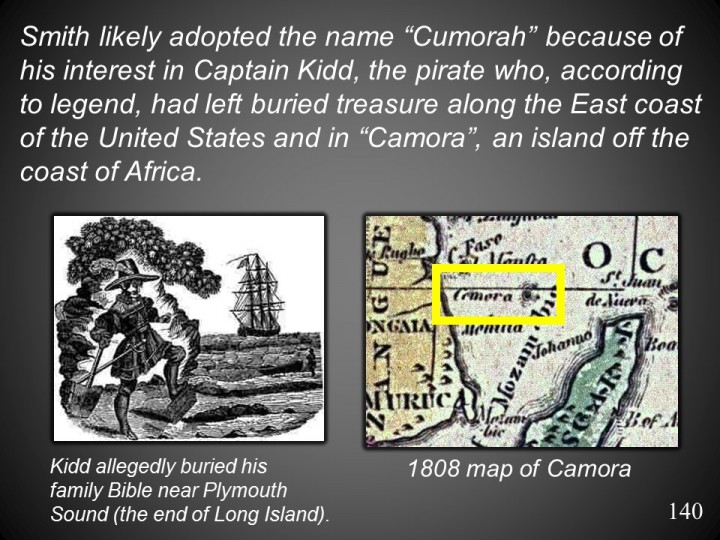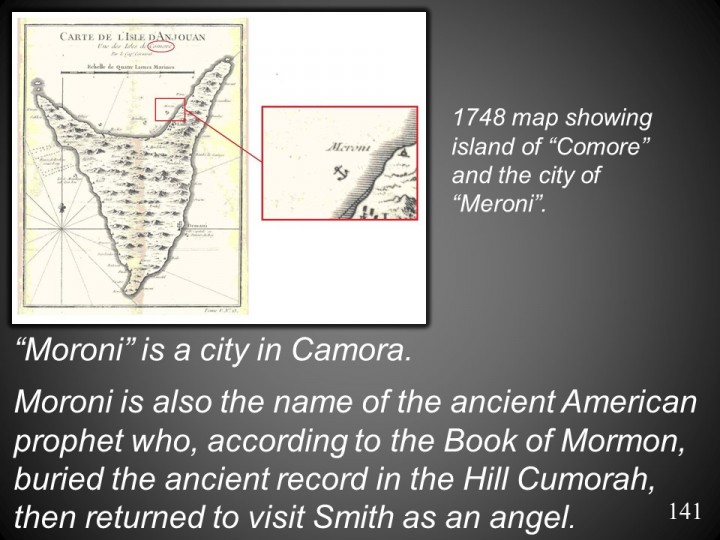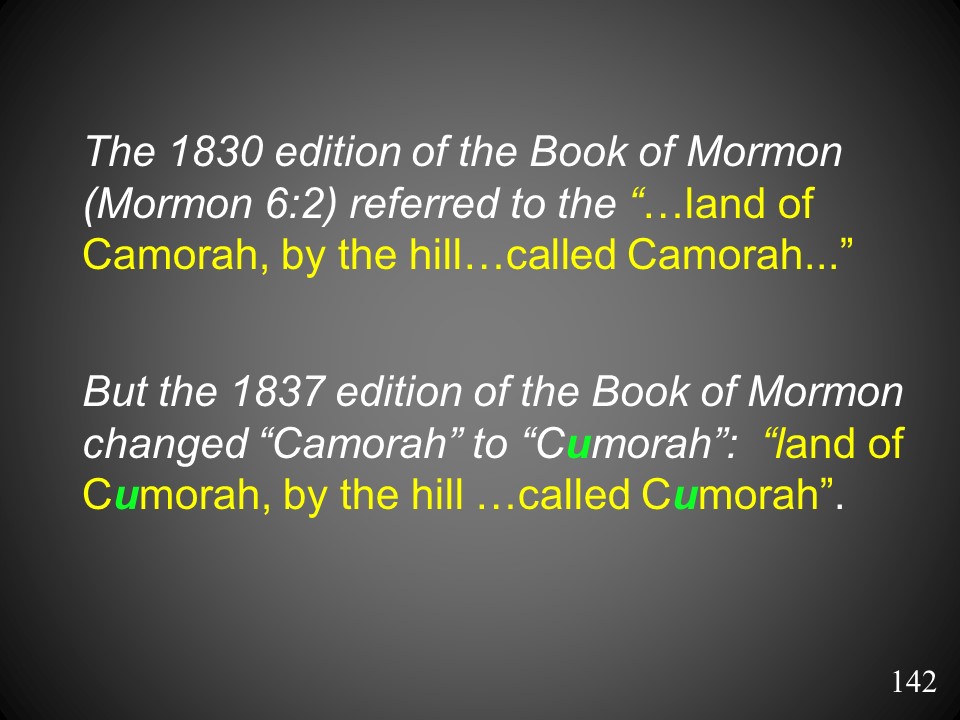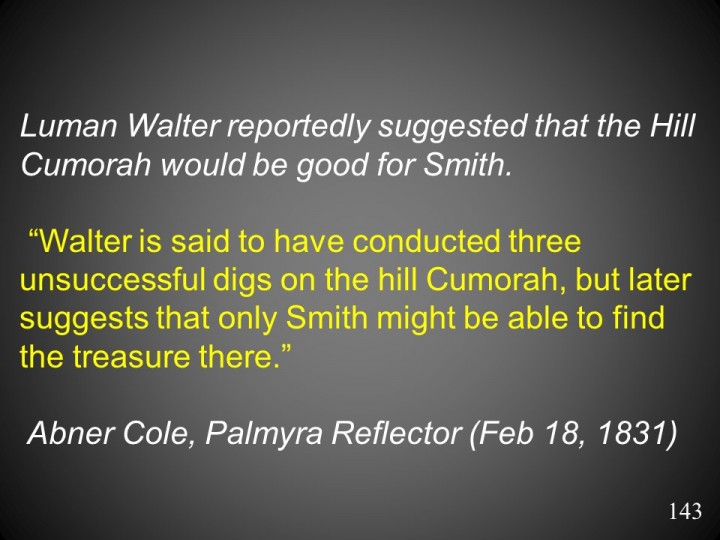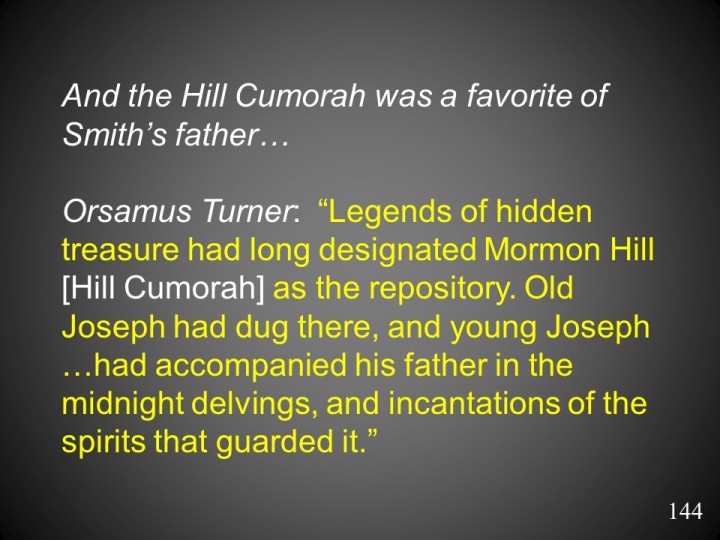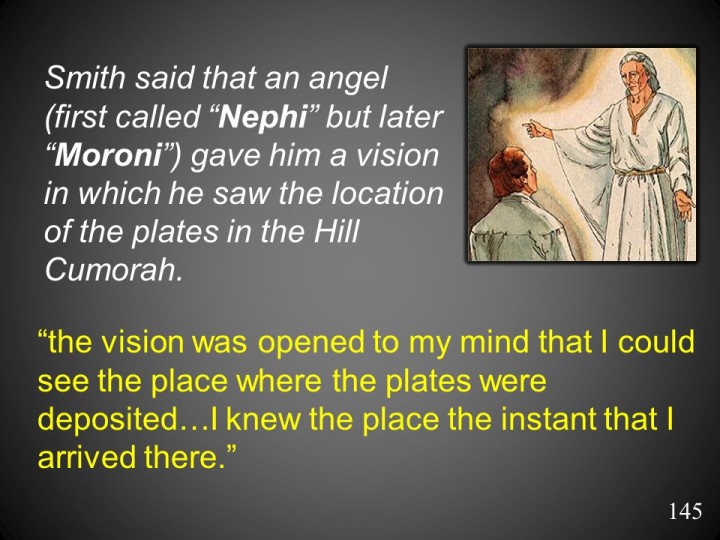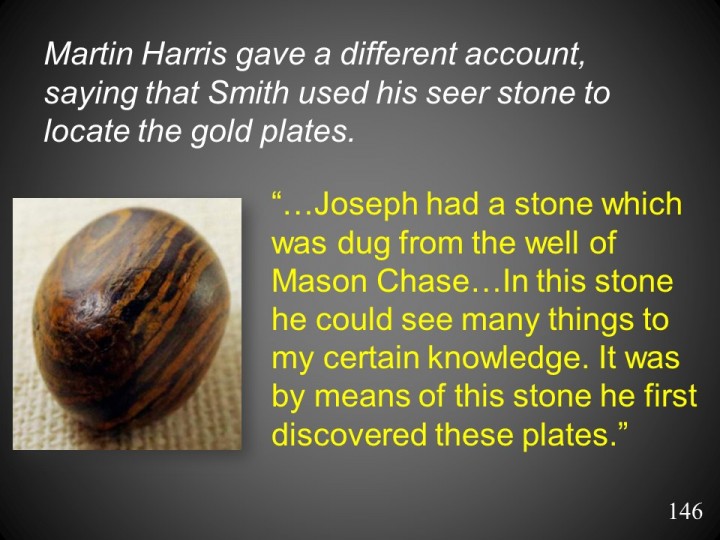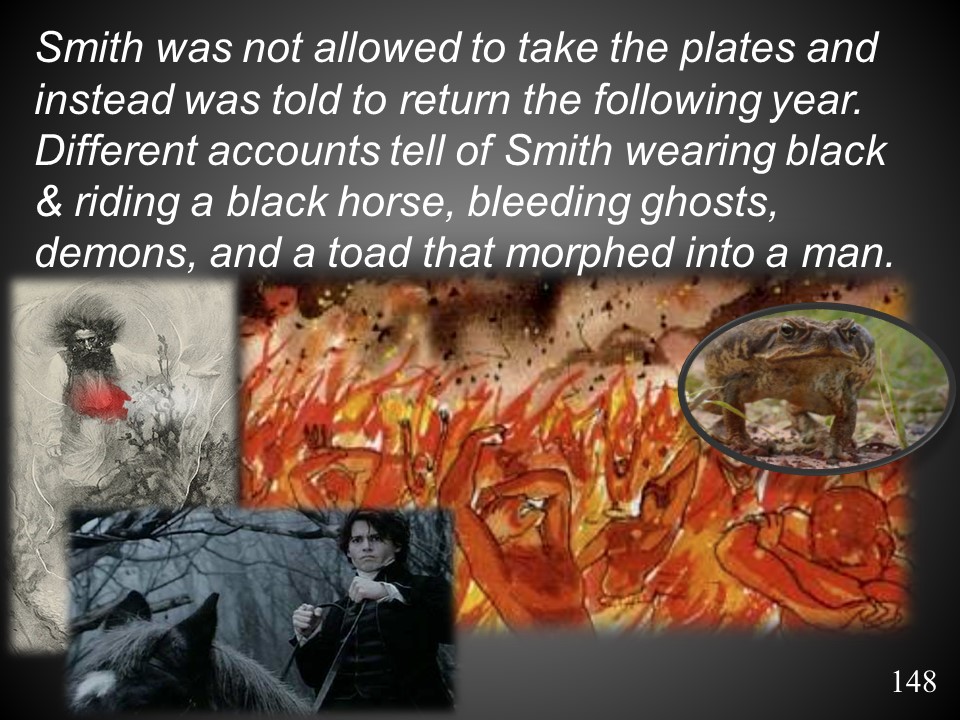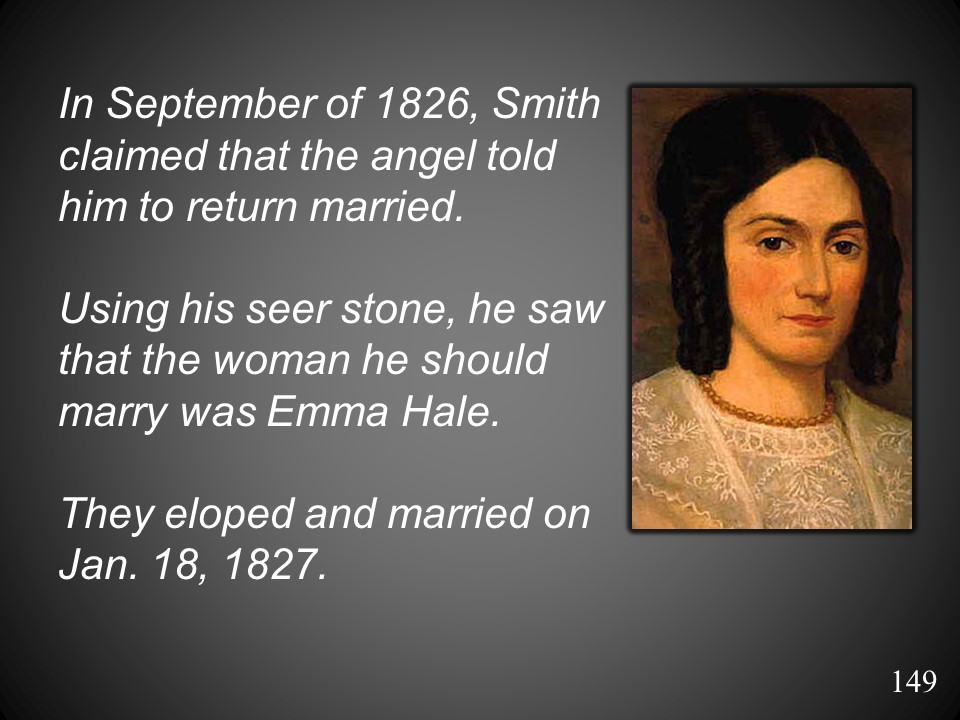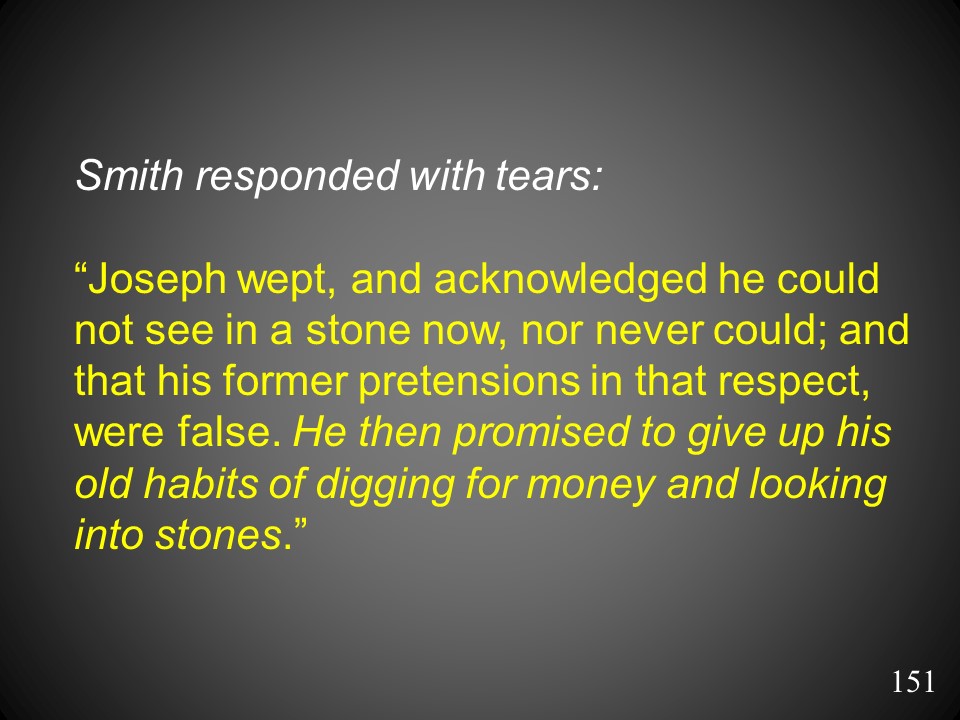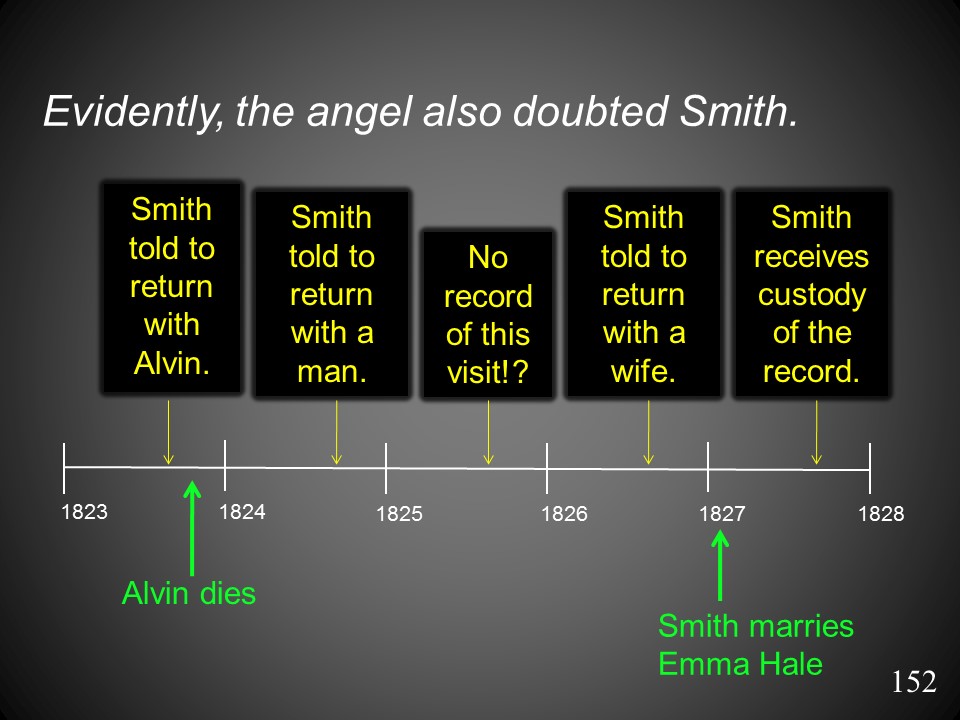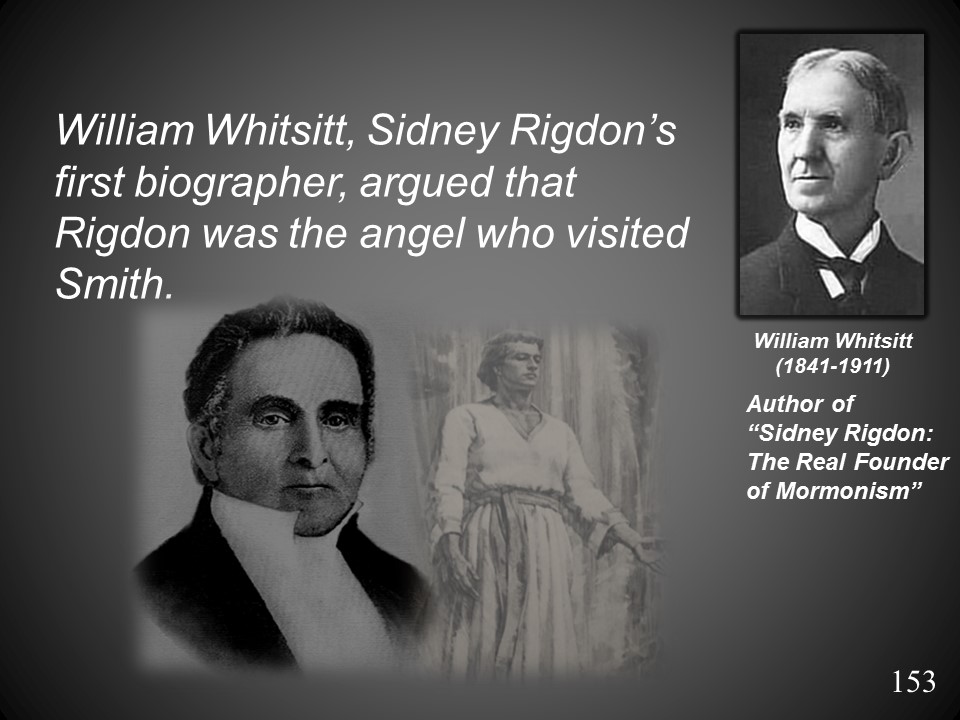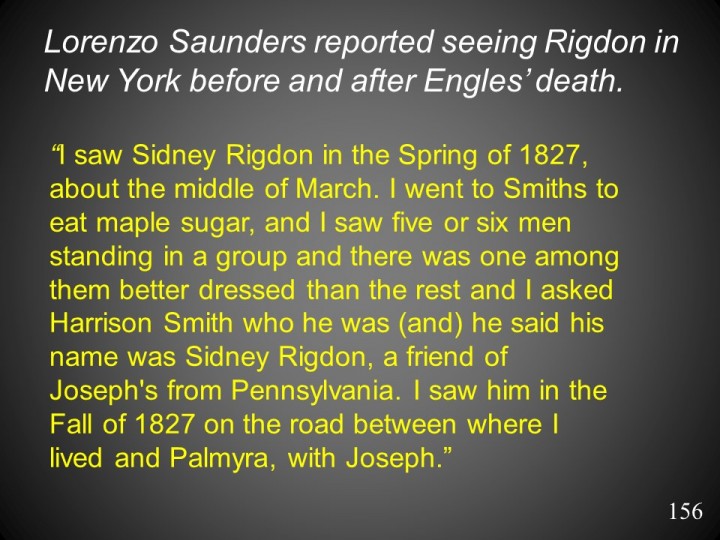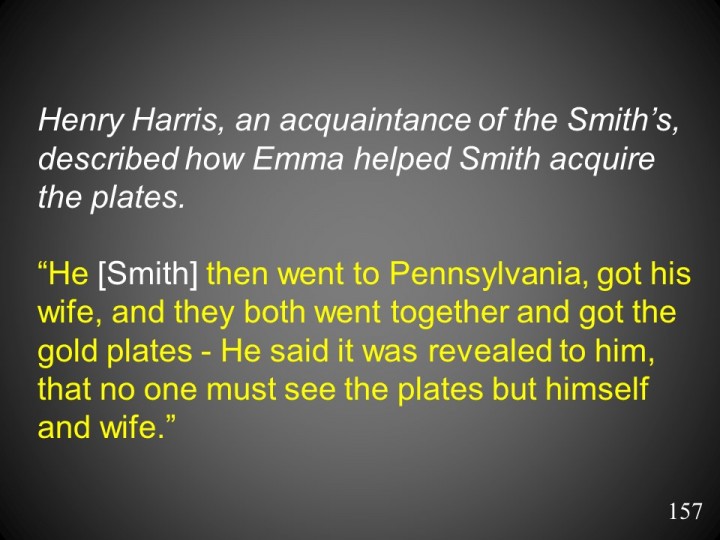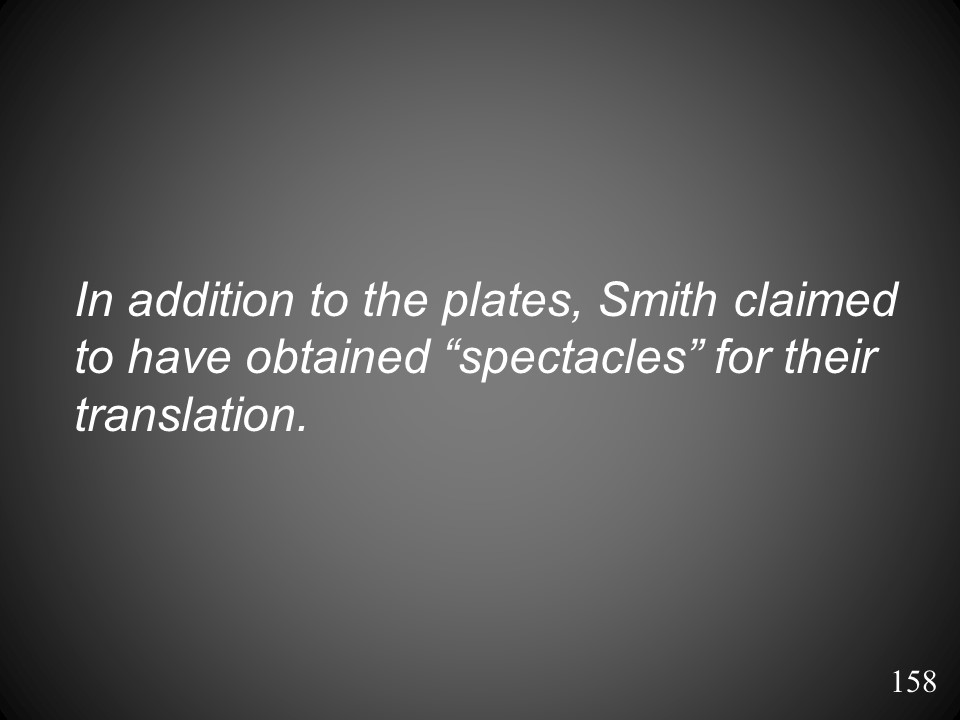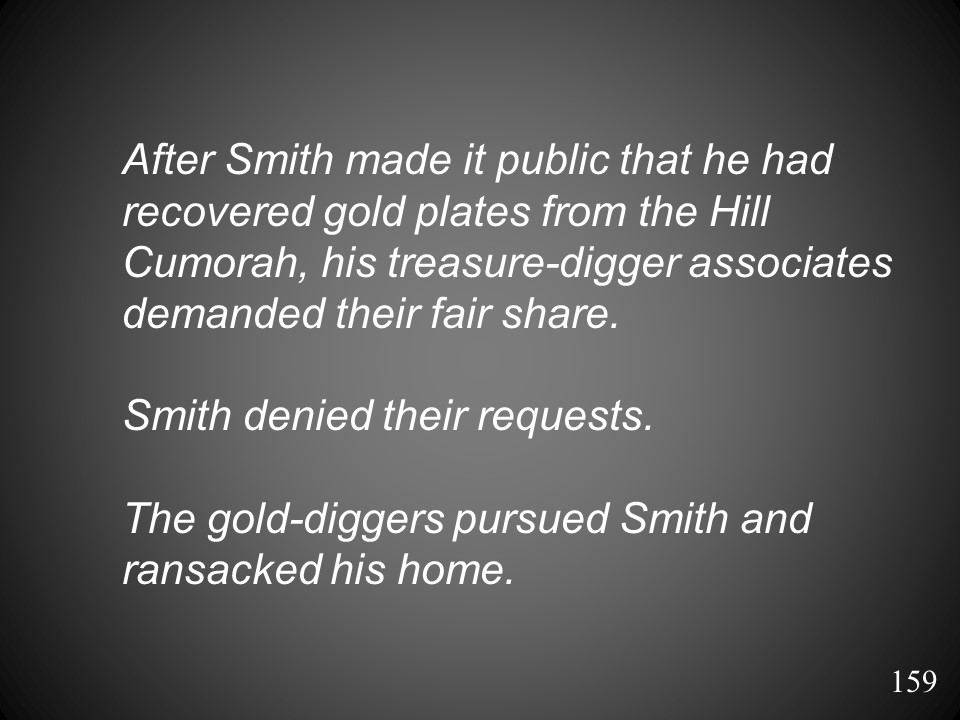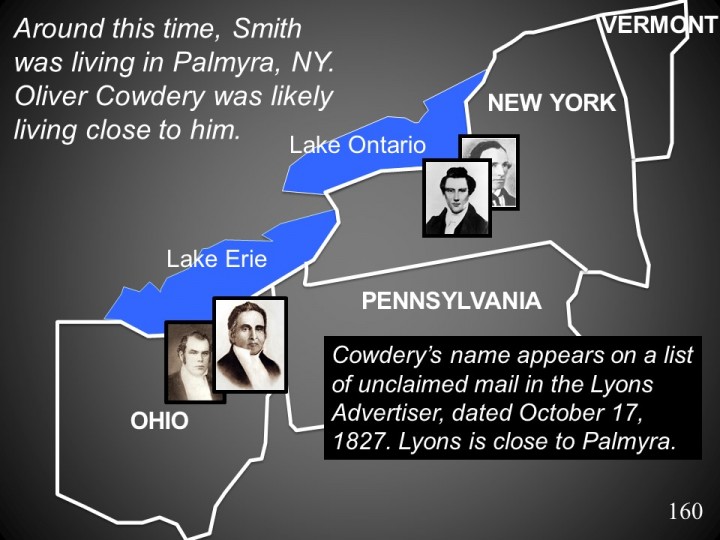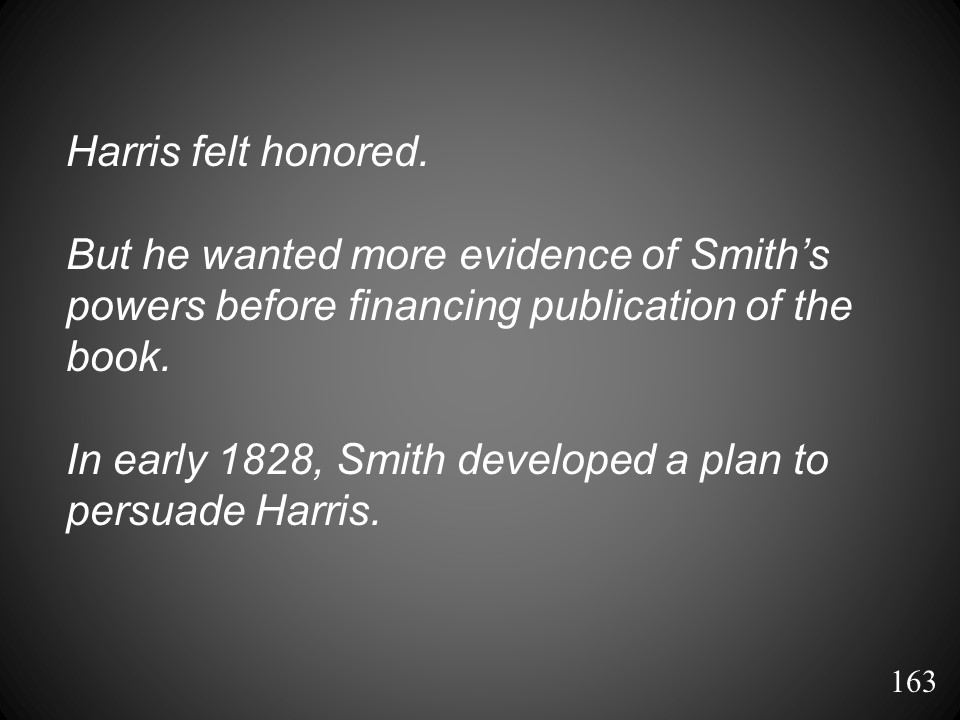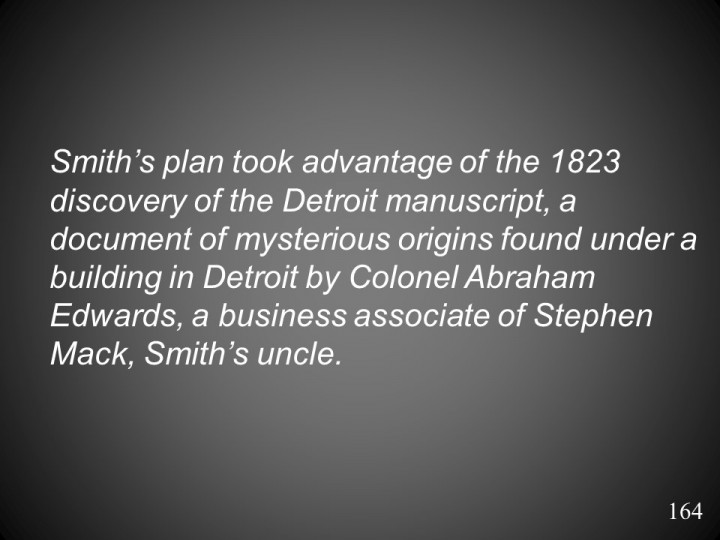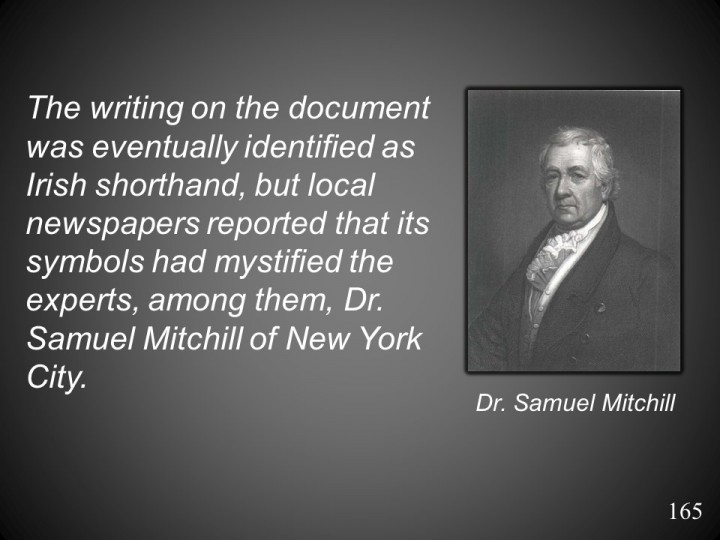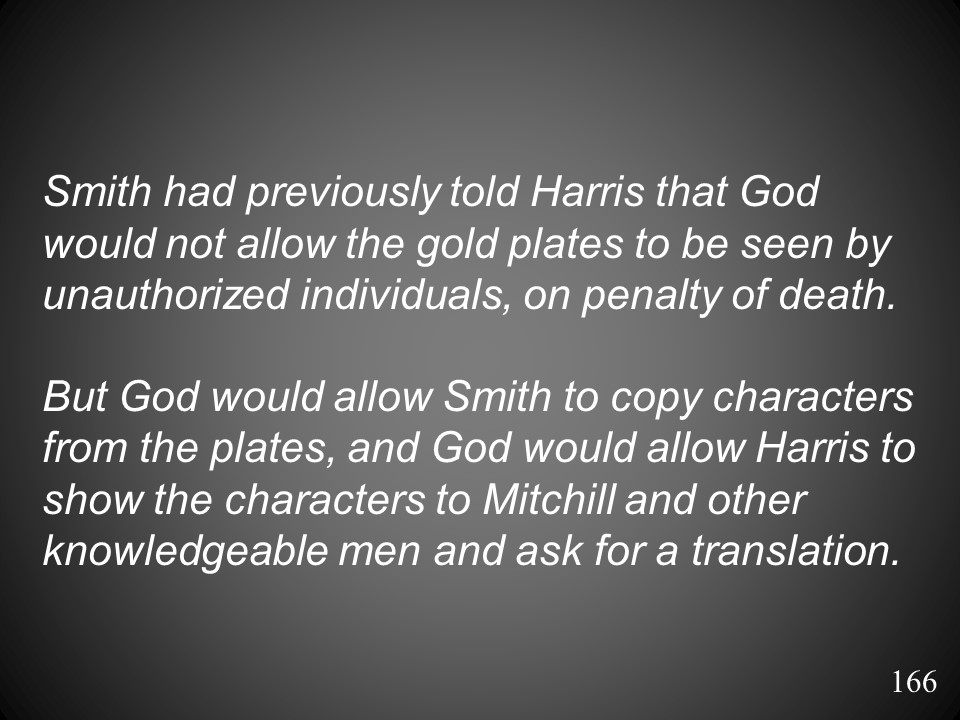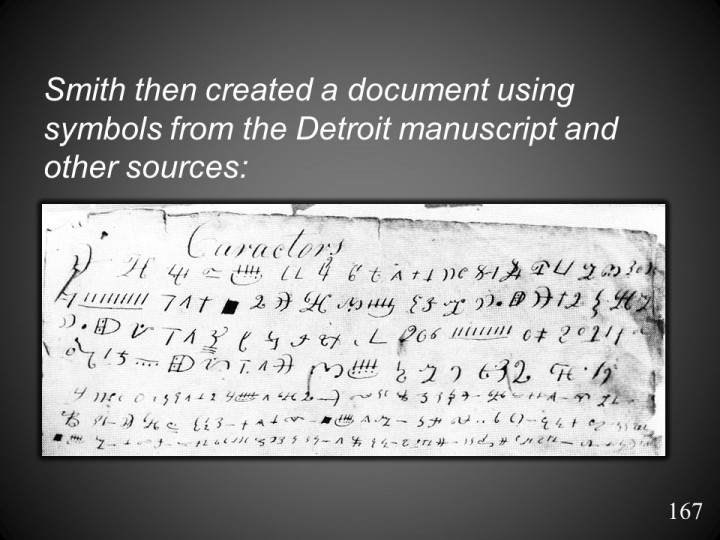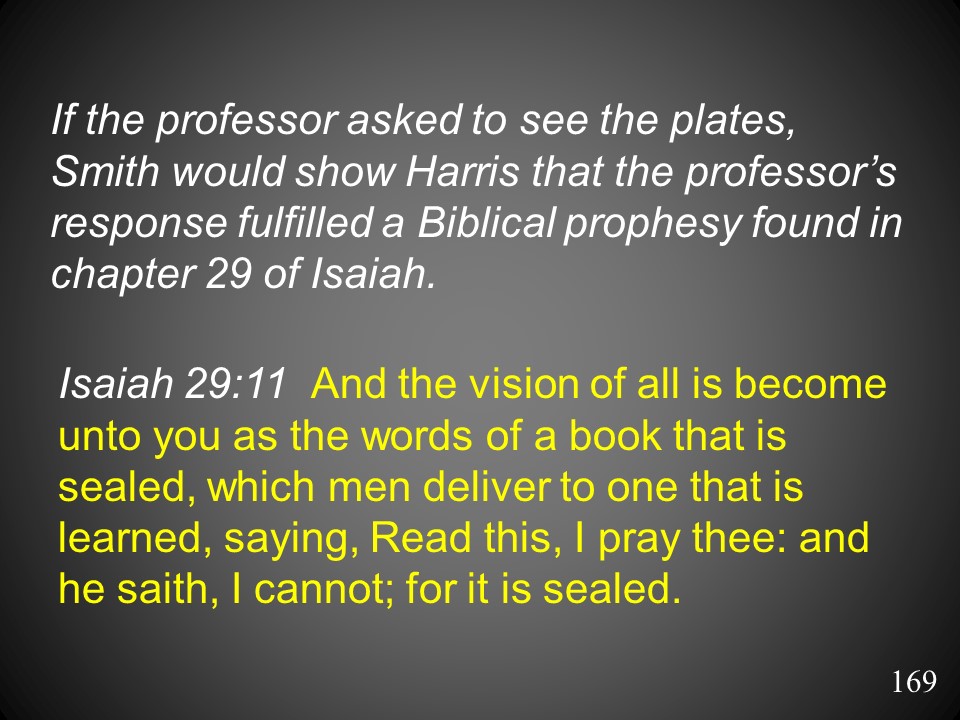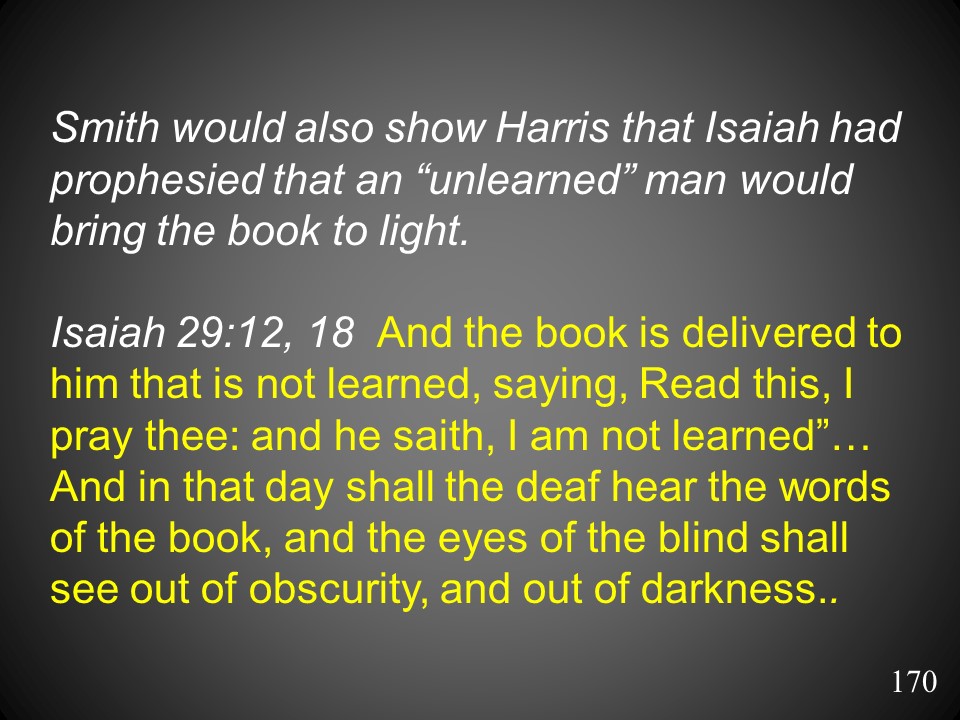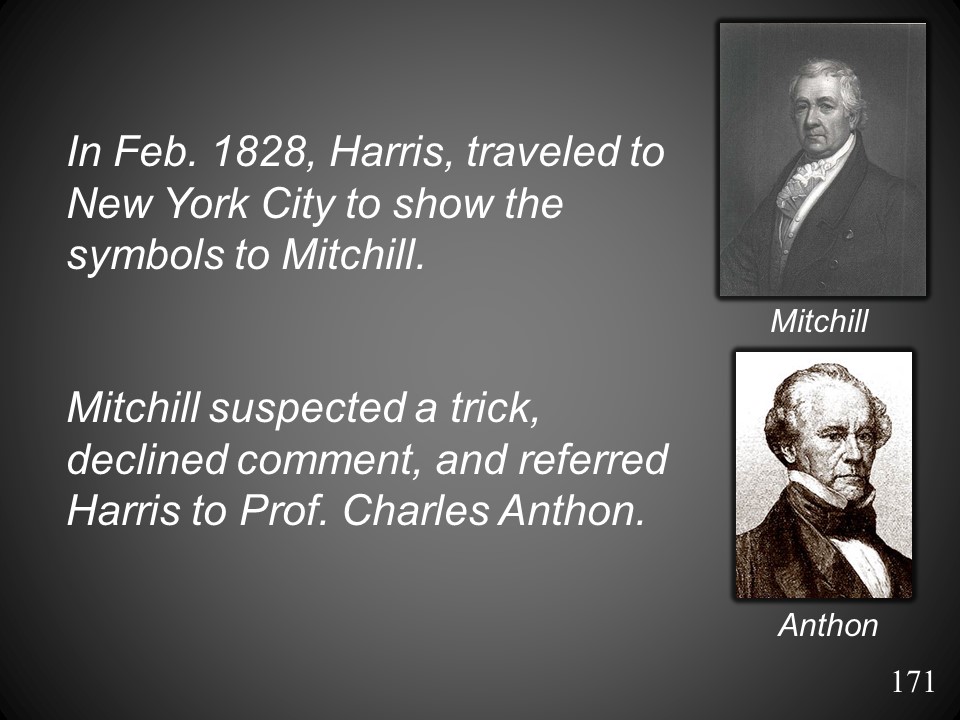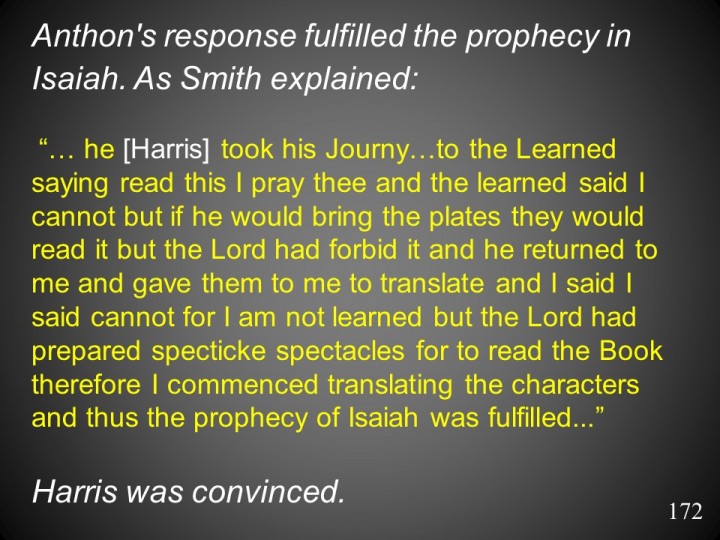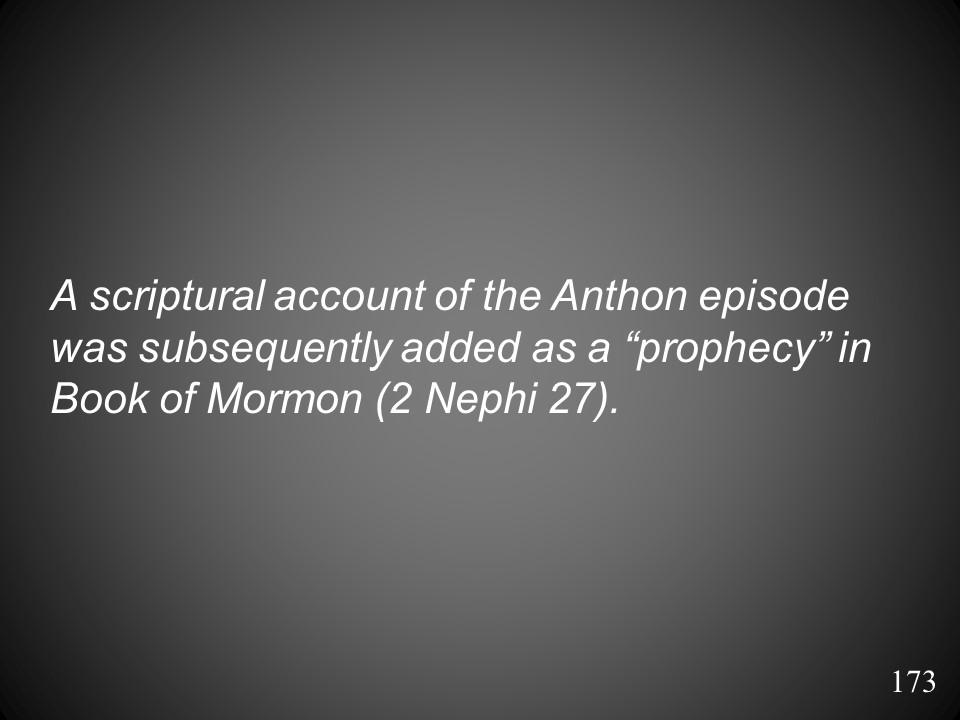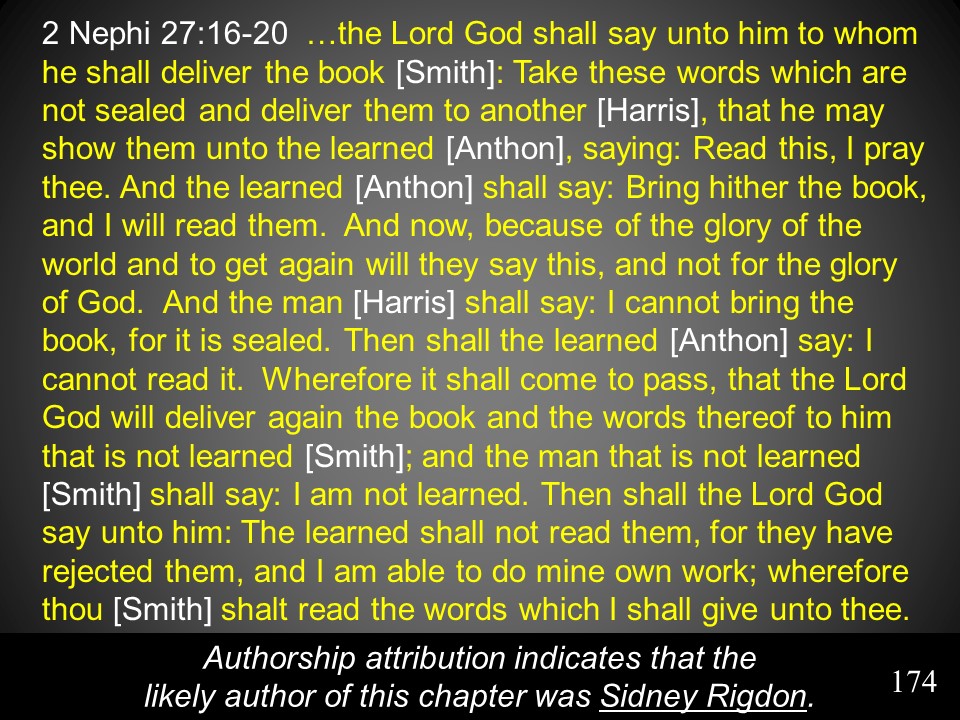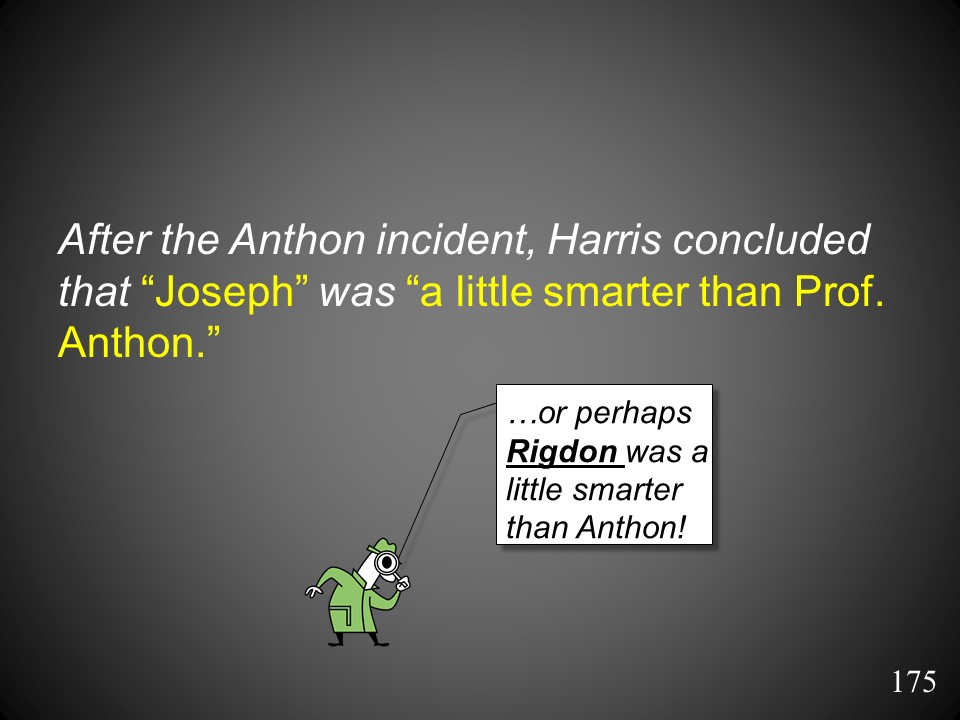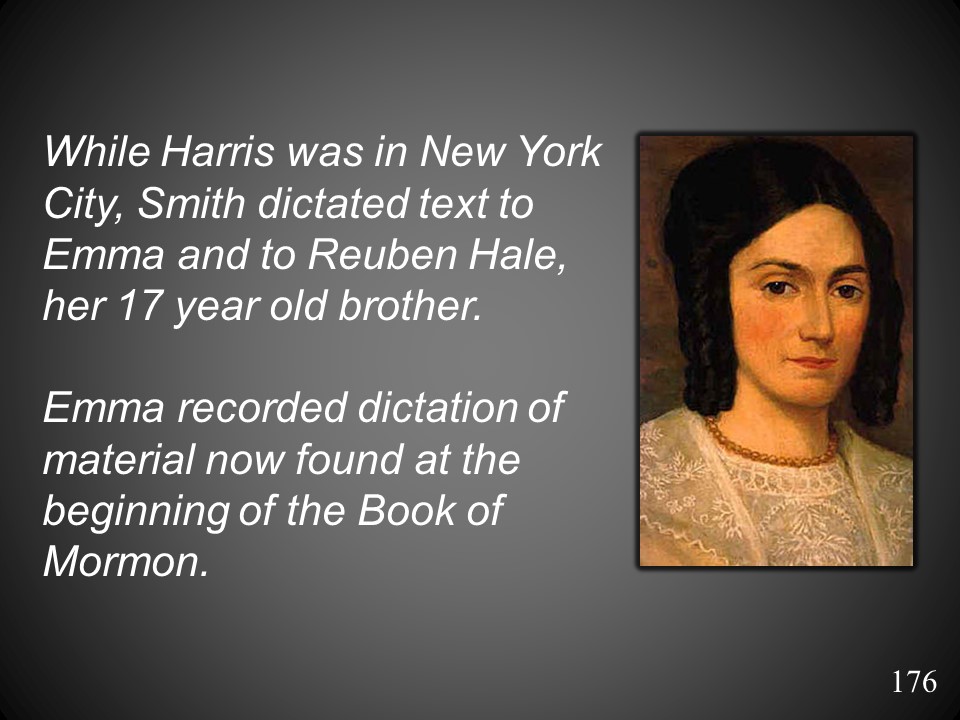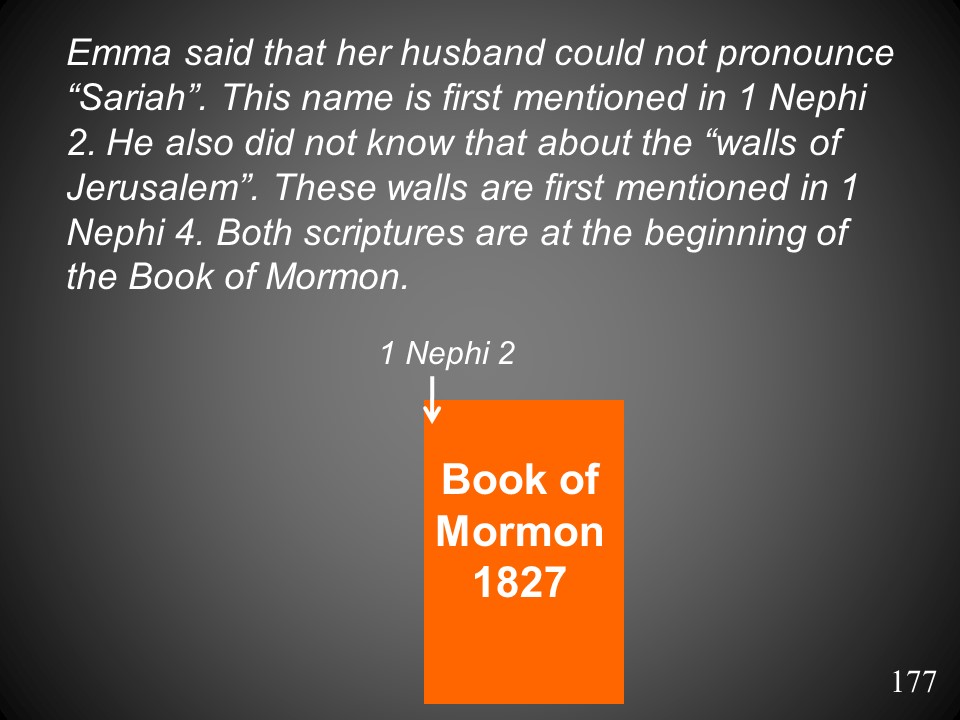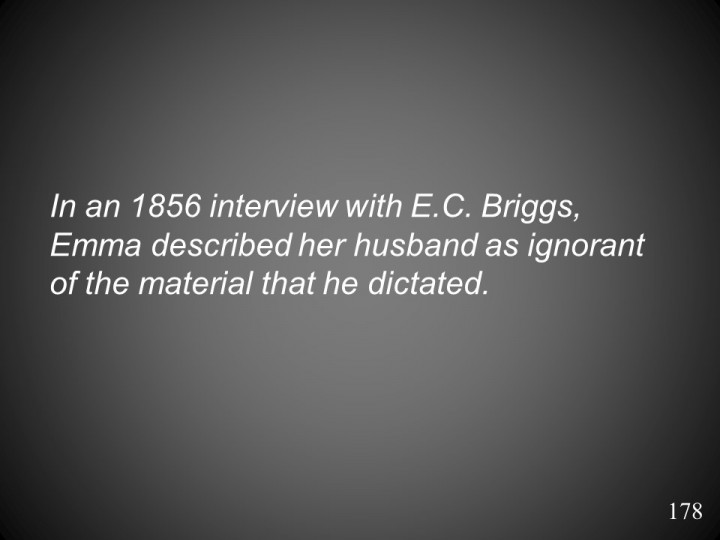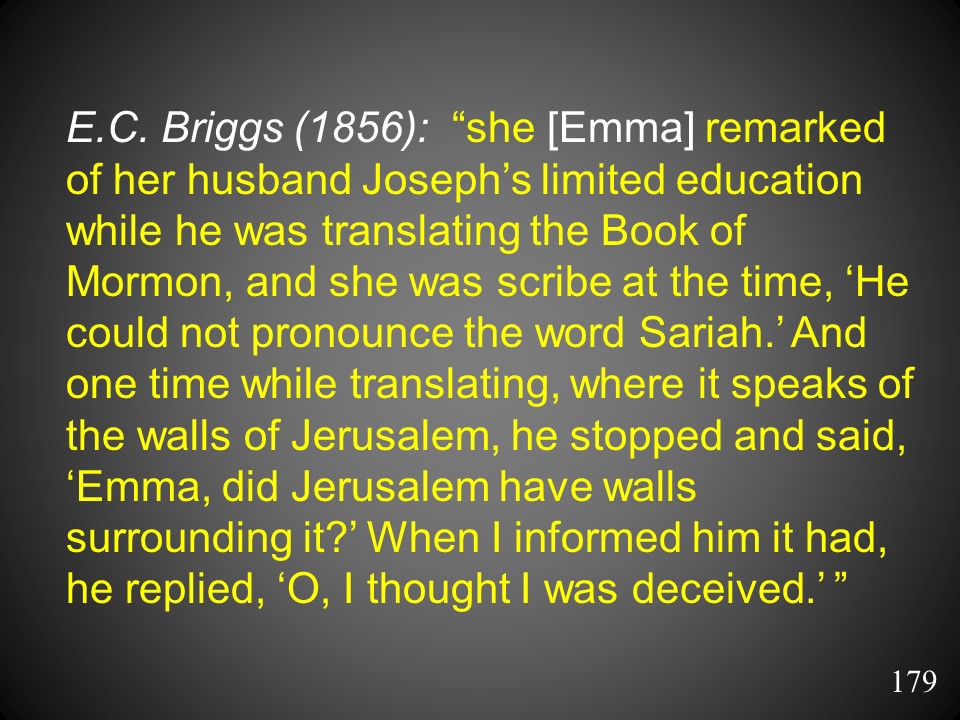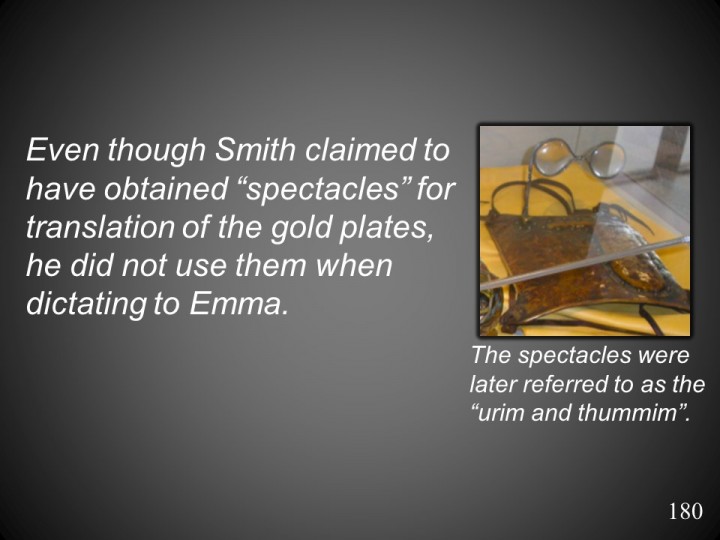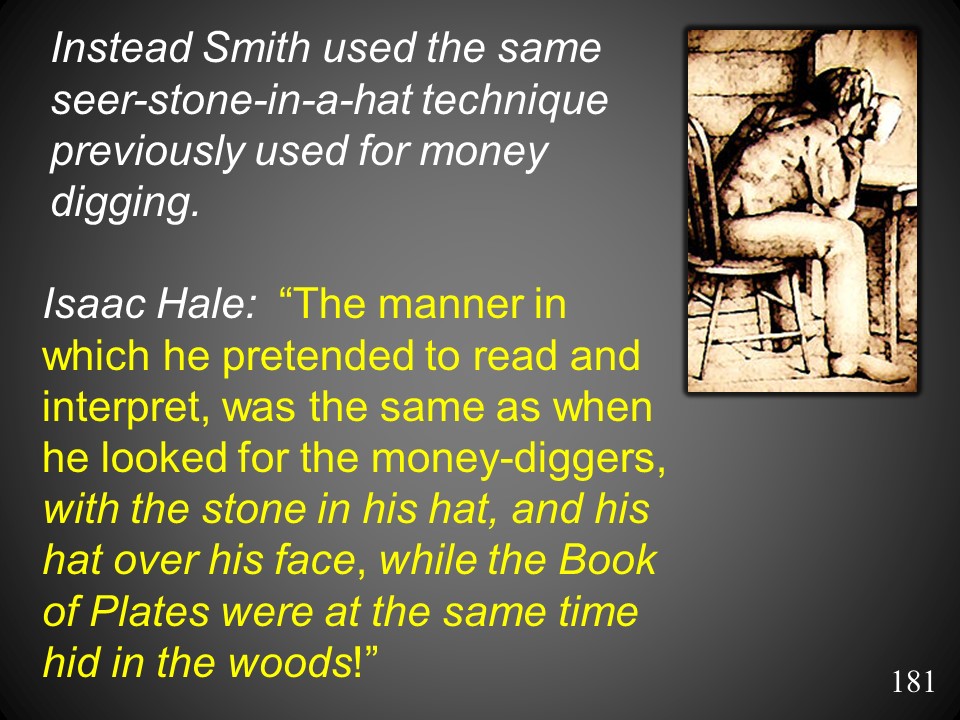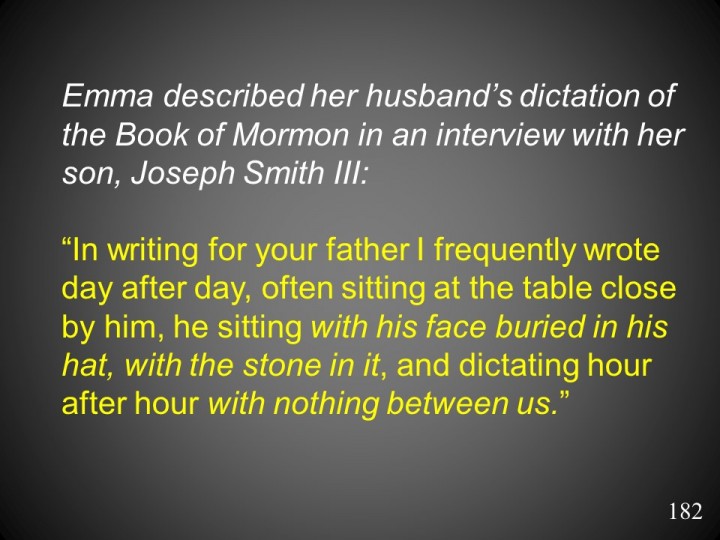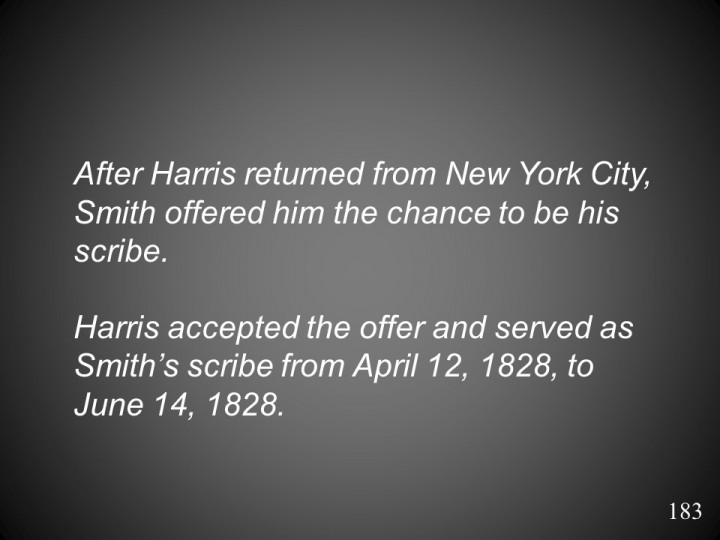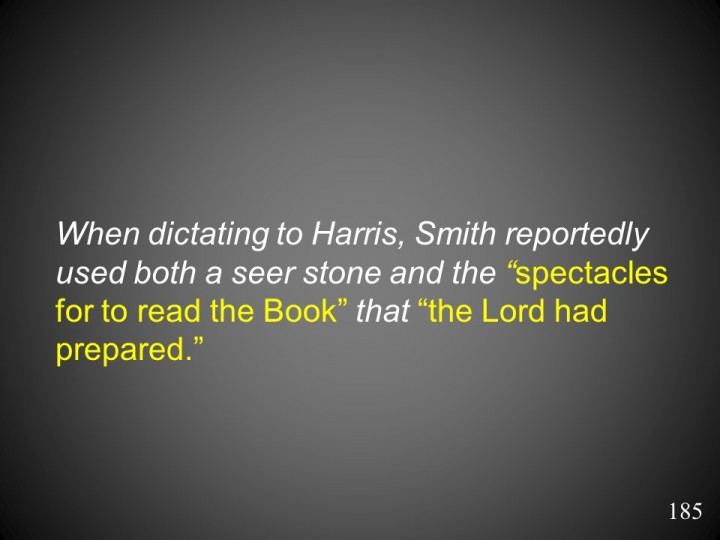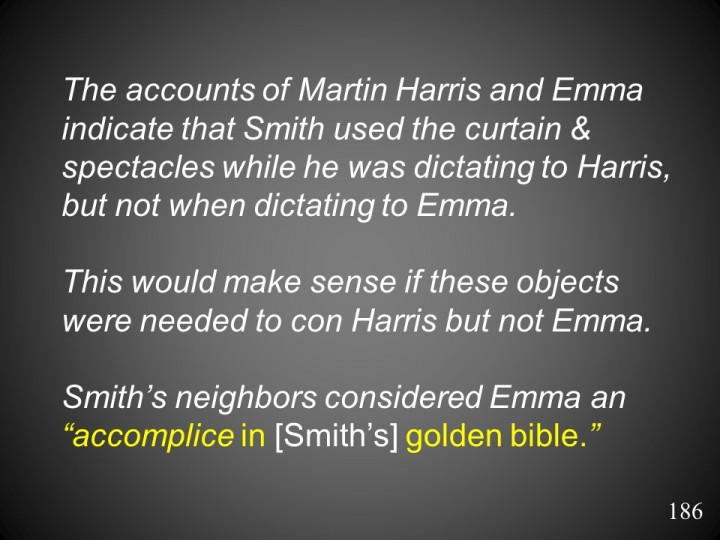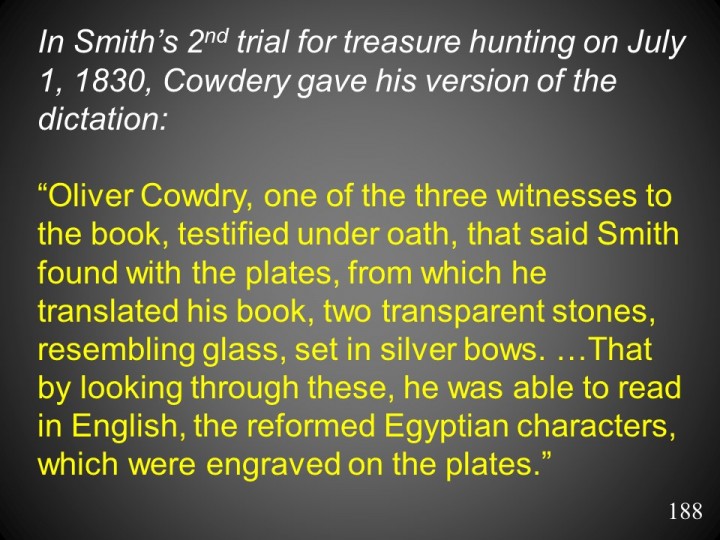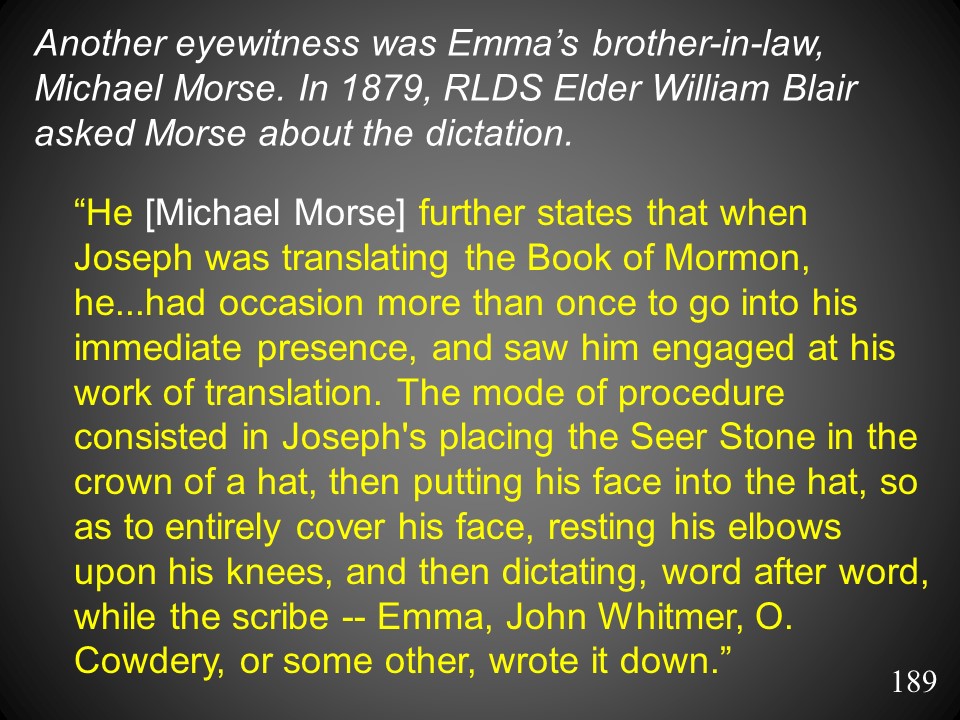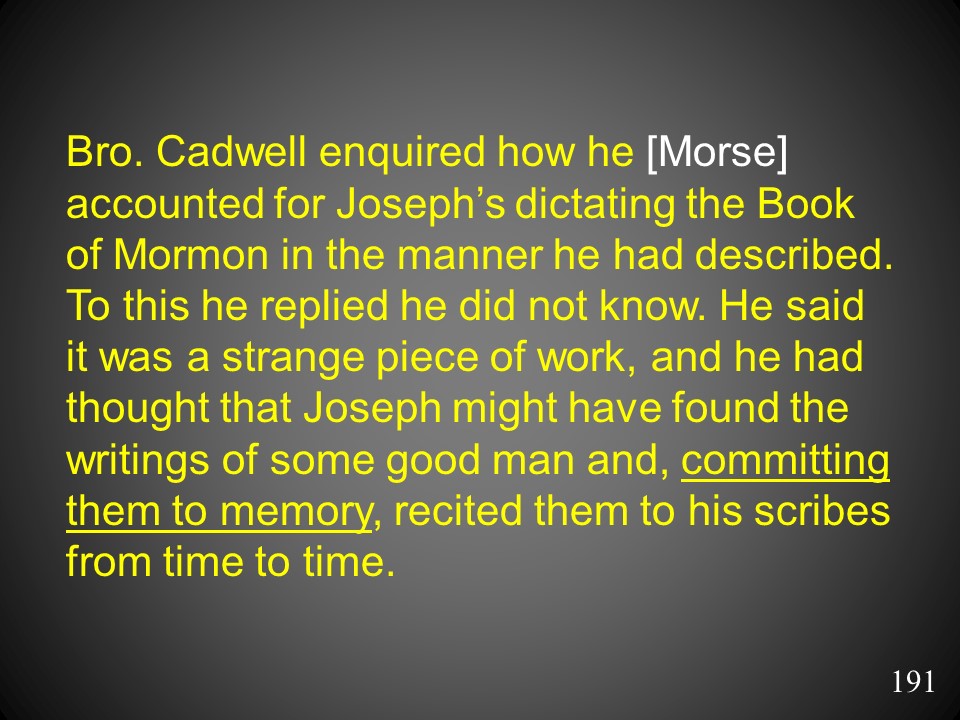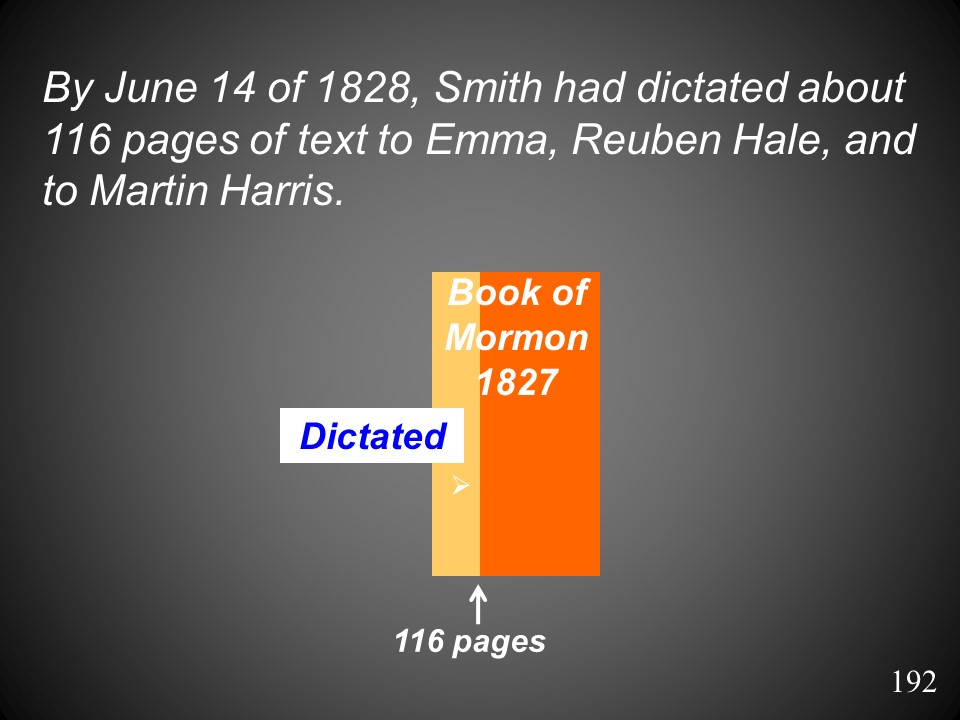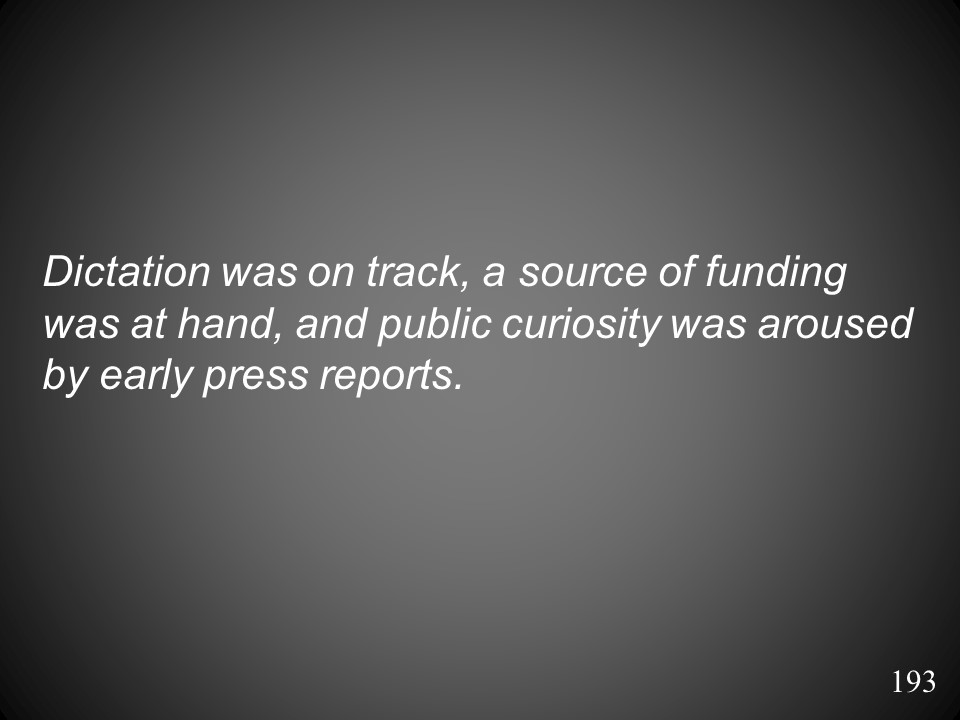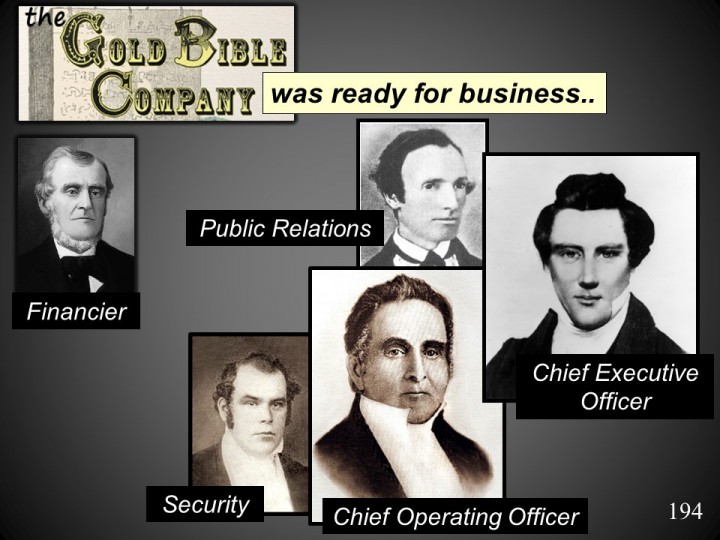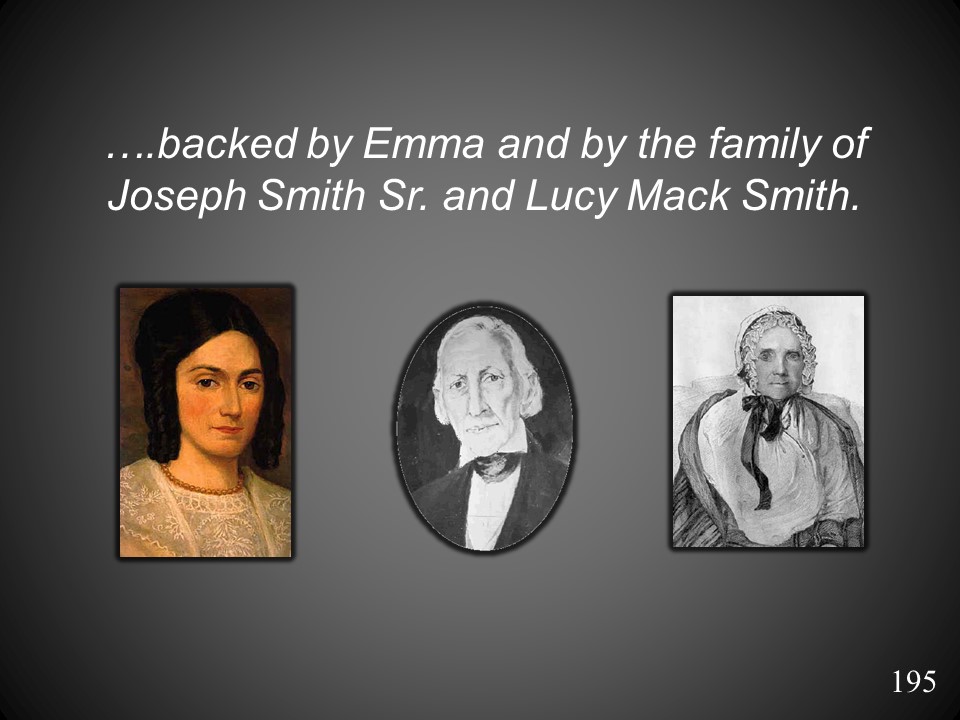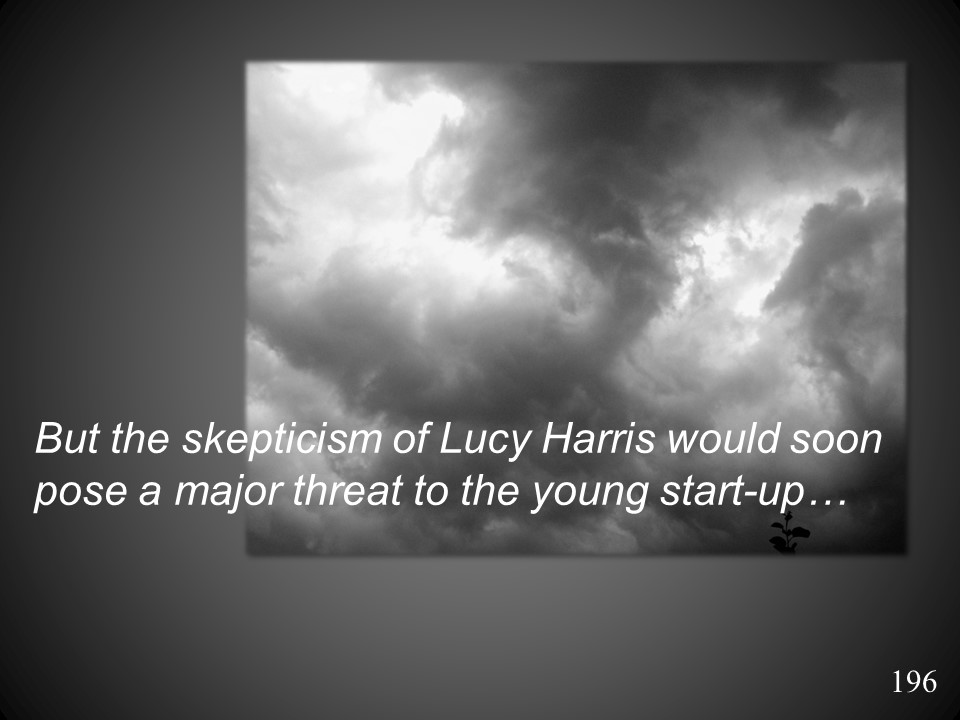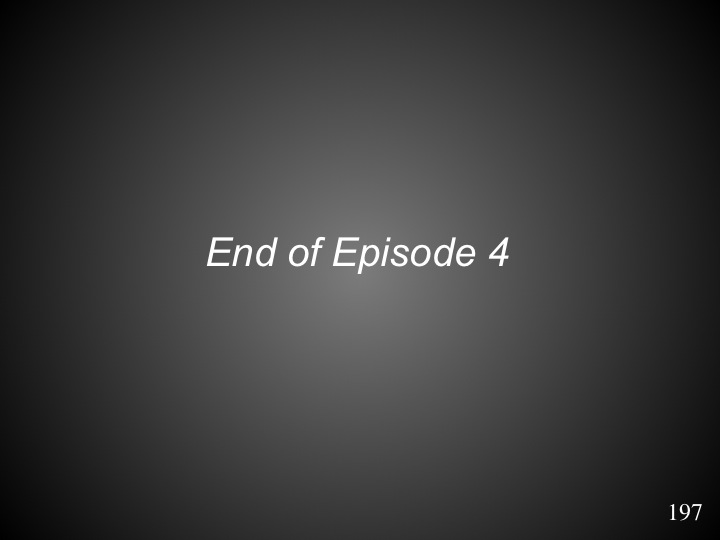Episode 4
Episode 04 – Slide 1
Episode 04 – Slide 3
Episode 04 – Slide 5
Nov. 12, 1878 Samuel Williams Letter Theodore Albert Schroeder Papers: Box 2, folder 1. Wisconsin State Historical Society Library, Madison, WI
Partial Catalog: Theodore A. Schroeder Papers.
http://solomonspalding.com/docs/Wil1878a.htm
“Parley Pratt was a tin Pedlar who passed from Conn. out to the West who brought about the acquaintance between Rigdon and Smith. And Martin Harris furnished the first money for the publication of the manuscript. Rigdon was naturally an orator but he had not the assurance to set himself up as a miracle worker.”
THE ORIGIN OF MORMONISM by MRS. DR. HORACE EATON, of Palmyra, N. Y. The following account was read by Mrs. Dr. Eaton at the Union Home Missionary Meeting, held at Buffalo, N. Y., May 27th, 1881, over which Mrs. J. L. Graham of New York presided. It is now published by the Woman’s Executive Committee of Home Missions:
“There was a ubiquitous tin peddler in those days by the name of Parley P. Pratt. He knew everybody in Western New York and Northern Ohio. He was a member of Rev. Sidney Rigdon’s church in Mentor, Ohio. Perhaps Pratt was the carrier-vulture who told Rigdon of the money digger, Smith.”
http://sidneyrigdon.com/1881Eatn.htm#pg03a
Pratt spent part of 1826 with an uncle in Wayne (formerly Ontario) County, NY, where Smith was operating as a money digger.
Episode 04 – Slide 15
(1) Ohio/Pennsylvania – Rigdon, Pratt and Spalding as a one major cluster, with essentially no Pratt links to Cowdery or Smith.
(2) New York – Smith and Cowdery.
Episode 04 – Slide 16
(1) Ohio/Pennsylvania – Rigdon, Pratt and Spalding as a one major cluster, with essentially no Pratt links to Cowdery or Smith.
(2) New York – Smith and Cowdery.
Episode 04 – Slide 17
(1) Ohio/Pennsylvania – Rigdon, Pratt and Spalding as a one major cluster, with essentially no Pratt links to Cowdery or Smith.
(2) New York – Smith and Cowdery.
Episode 04 – Slide 18
(1) Ohio/Pennsylvania – Rigdon, Pratt and Spalding as a one major cluster, with essentially no Pratt links to Cowdery or Smith.
(2) New York – Smith and Cowdery.
Episode 04 – Slide 25
“The elder Smith …was a great babbler, credulous, not especially industrious, a money-digger, prone to the marvellous; and, withal, a little given to difficulties with neighbors, and petty law-suits.”
Episode 04 – Slide 26
“Long before Joseph Smith’s neighbors alleged that he hunted for buried money by occult means, the art of magical treasure hunting was widespread in America. Accounts of men pursuing enchanted treasures with divining rods are especially prevalent throughout the eighteenth century and suggest that the practice had become ritualized very early on. The buried treasure was located by a divining rod and immobilized by charms, magic circles, or special steel rods driven into the ground. Incantations were recited to protect the diggers from “certain malicious Demons who are said to hunt and guard such Places.”
Episode 04 – Slide 29
…any “Mistake in the Procedure, some rash Word spoken, or some Rule of Art neglected, the Guardian Spirit had Power to sink it deeper into the Earth and convey it out of their reach.”
Benjamin Franklin:
“…Franklin noted “that through some mistake in the procedure, some rash word spoke, or some rule of art neglected, the guardian spirit had power to sink [the treasure] deeper into the earth and convey it out of their reach.”
Buried Treasure Tales in America
GERARD T. HURLEY
“The professional treasure seeker knows lots of things. He realizes, for instance, that a sleepwalker may lead one to treasure, that treasures sink into the earth when something is wrong, that slipping treasures can be tied with a white silk thread and saved, and that various times of the day and month are more auspicious for hunting than others. [22]
He understands the complicated business of divining rods, as well as other rituals for locating treasure sites (37, 40). He knows that the surest way to lose a treasure is to speak while digging, and could tell you that the purpose of many “land spirits” and “plat-eyes” is to frighten you into breaking the rule for silence (5, 11, 12, 13, 17, 27, 41). He knows, too, that speaking is allowed in only one case — when one reads from the Bible, the hymn book (3, 7, 51), or the Sixth and Seventh Books of Moses, a pamphlet of superstitions, black magic, and other ends.” That the Christian God and ritual is used to recover treasure seems logical in view of the fact that the origin of much treasure involved bloodshed and crime, as was explained by a South Carolina fisherman: “Tredger berrit fum spiteful, gredge an’ greedy killin’, robbin’ an’ murdah.” [24]
Wealth of such origin could well be viewed as devil’s goods. The spirits that guarded treasure were certainly creatures of evil as well. The area under the ground — where treasure usually was — had long been regarded as devil’s domain. It is not surprising, then, that the forces of good would be called upon to aid in the recovery of buried wealth. Some treasure hunters do enlist the help of the devil in locating treasure. In one case, when a pious Christian attempted to dig for treasure located with the help of the devil, demons and saucer-eyed birds came from the hole and mocked all the good men. [25]
In most tales, however, “conjuring” is done in the name of the Christian God and the precautions that are taken can be related without much difficulty to Christian ritual and belief. In addition to reading the Scriptures and the hymnal, and using a book attributed to Moses, the greatest of all conjurers, the spirit controller observes other practices.
He will not hunt treasure with anyone who has shed blood. [26] He may remain sexually continent for four days before going on the hunt. He cleans his pockets of tobacco. [27]”
Episode 04 – Slide 30
Episode 04 – Slide 32
http://connellodonovan.com/herald.html
More on William Smith-
http://olivercowdery.com/smithhome/BroBill/wmchron.htm
“And William Smith has asserted that I was the cause of the death of his brother Samuel, when brother Woodruff, who is here to day, knows that we were waiting at the depot in Boston to take passage east at the very time when Joseph and Hyrum were killed. Brother Taylor was nearly killed at the time, and Doctor Richards had his whiskers nearly singed off by the blaze from the guns. In a few weeks after, Samuel Smith died, and I am blamed as the cause of his death.” – Prophet Brigham Young, July 1857, Journal of Discourses, vol. 5, p.77A.
Check of church history sources reveals theses clues:
“Samuel Harrison Smith, born in Tunbridge, Vt., March 13, 1808. Died July 30, 1844, broken hearted, and worn out with persecution. Aged 36. The righteous are removed from the evils to come.” – Times and Seasons, Vol.5, No.24, p.760
“Hyrum & Joseph was Murdered Carthage Jail in Hancock Co[,] Illinois. Samuel Smith died in Nauvoo, supposed to have been the Subject of Conspiracy by Brigham Young.”- Joseph Smith Family Testimony, William Smith Notes Circa 1875, Vogel, Early Mormon Documents, p. 488.
Why would such an accusation be laid against Brigham Young? To understand the context, you have to remember that after Smith and Hyrum were killed, there was some conflict over who should be his successor. Brigham Young was not in Nauvoo when Smith was killed, but started to head back as soon as he heard the news. Meanwhile in Nauvoo, several potential leaders were positioning to take the reins of leadership. The most popular replacement was Samuel Smith, the brother of Joseph Smith. William Clayton had recorded Joseph declaring his brother William his successor if both he and Hyrum were killed. But Brigham Young’s first cousin and church apostle, William Richards insisted that nothing should be decided until Brigham Young could return to Nauvoo. However, many members did not want to wait, and more and more support was gathering behind Samuel Smith, Joseph Smith’s brother, to become the next Prophet and leader of the church. For a select few, this presented a problem because Samuel was violently against polygamy. It was looking like Samuel Smith would become the next prophet and promised to denounce the practice of plural marriage.
D. Michael Quinn, The Mormon Hierarchy: Origins of Power, p.152-153:
“Then Samuel Smith suddenly became violently ill and died on 30 July 1844. This added suspicion of murder to the escalating drama. Council of Fifty member and physician John M. Bernhisel told William Smith that anti-Mormons had somehow poisoned his brother. William learned from Samuel’s widow that Hosea Stout, a Missouri Danite and senior officer of Nauvoo’s police, had acted as his brother’s nurse. Stout had given him “white powder” medicine daily until his death. Samuel became ill within days of the discussion of his succession right, and by 24 July was “very sick.” There had been enough talk about Samuel’s succession claims that the newspaper in Springfield, Illinois, reported: “A son of Joe Smith [Sr.] it is said, had received the revelation that he was to be the successor of the prophet. “”William Smith eventually concluded that Apostle Willard Richards asked Stout to murder (his brother) Samuel H. Smith. The motive was to prevent Samuel from becoming church president before Brigham Young and the full Quorum of Twelve arrived (in Navuoo). William’s suspicions about Stout are believable since Brigham Young allowed William Clayton to go with the pioneer company to Utah three years later only because Stout threatened to murder Clayton as soon as the apostles left. Clayton regarded Hosea Stout as capable of homicide and recorded no attempt by Young to dispute that assessment concerning the former Danite.”” One could dismiss William Smith’s charge as a self-serving argument for his own succession claim, yet Samuel’s daughter also believed her father was murdered. “My father was undoubtedly poisoned,” she wrote. “Uncle Arthur Millikin was poisoned at the same time-the same doctors were treating my father and Uncle Arthur at the same time. Uncle Arthur discontinued the medicine-without letting them know that he was doing so. (Aunt Lucy [Smith Millikin] threw it in the fire). Father continued taking it until the last dose-he spit out and said he was poisoned. But it was too late-he died.” Nauvoo’s sexton recorded that Samuel Smith died of “bilious fever,” the cause of death listed for two children but no other adults that summer.” “This troubling allegation should not be ignored but cannot be verified. Nevertheless Clayton’s diary confirms the efforts of Richards to avoid the appointment of a successor before his first cousin Brigham Young arrived. Stout’s diary also describes several occasions when Brigham Young and the apostles seriously discussed having Hosea “rid ourselves” of various church members considered dangerous to the church and the apostles. Stout referred to this as “cut him off-behind the ears-according to the law of God in such cases.” Stout’s daily diary also makes no reference whatever to his threat to murder Clayton in 1847. When the Salt Lake “municipal high council” tried Hosea Stout for attempted murder, he protested that “it has been my duty to hunt out the rotten spots in the Kingdom.” He added that he had “tried not to handle a man’s case until it was right.” Evidence does not exist to prove if the prophet’s brother was such a “case” Stout handled.”
Episode 04 – Slide 33
Episode 04 – Slide 34
Don Carlos Smith married Agnes M. Coolbrith (1811-1928) from Saco, Maine.
Lucy Millikin married Arthur Millikin (1789-1882) from Saco, Maine.
Episode 04 – Slide 37
Episode 04 – Slide 38
“The dimensions of the circle is [sic] as follows: a piece of ground is usually chosen nine feet square, at the full extent of which parallel lines are drawn one within another, having sundry crosses and triangles described between them, close to which is formed the first or outer circle; then, about half a foot within the same, a second circle is described; and within that another square correspondent to the first, the centre of which is the seat or spot where the master and associate are to be placed. The vacancies formed by the various lines and angles of the figure, are filled up with all the holy names of God, having crosses and triangles described betwixt them agreeable to a sketch I have given in the annexed plate, where likewise I have projected the form of magic seals, pentacles, &c. &c. just to give the reader an idea of what is meant, whenever we have occasion to speak of them in the following discourse.” (p. 1103)
Episode 04 – Slide 40
Episode 04 – Slide 41
Saint Peter Bind Them contains the magic symbol for Pah-li-Pah, the second pf seven angels in ceremonial magic. If invoked properly, Pah-li-Pah helped find buried treasure for the parchment’s owner. The reverse side contains the inscription for Nalgah, the third angel in ceremonial magic, “devoted to the protection of those who are assaulted by evil spirits or witches, and those whose mind are sunk in fear and melancholy apprehensions of the assaults of the devil”. 53 pg. 90, One Nation Under Gods.
All these items, except the pouch, were inscribed with not only magical symbols, and incantations, but also with astrological markings. As it turns out the Smith, as well as many other early Mormon families were entrenched in astrology–so much so that Smith chose to organize his church on April 6,1830, a day known as the beneficial “DAY-FATALITY” in folk belief, which in 1830 coincided with a particularly positive alignment of Jupiter and the sun. pg. 90, One Nation Under Gods Oliver Cowdery, received a revelation about his gift. 47 pg. 89, One Nation Under Gods.
Episode 04 – Slide 42
“While the Smith family’s belief in astrology can be demonstrated only circumstantially and inferentially, the Smiths left direct evidence of their practice of ritual magic. In addition to the magic dagger, among Hyrum Smith’s possessions at his death were three parchments — lamens, in occult terms — inscribed with signs and names of ceremonial magic… Like the dagger, photographs of these magic parchments have been in print since 1982 (de Hoyos 1982, 4-22; Tanner and Tanner 1982a, 1-3; Tanner and Tanner 1983, 6-9; Salt Lake Tribune, 24 Aug. 1985, B-1)…The dagger may have belonged originally to Joseph Smith, Sr., and the parchments may be artifacts from the time of the coming forth of the Book of Mormon.”
Episode 04 – Slide 45
“During this period, I enjoyed in common with other boys of my age and circumstances, but limited opportunities for acquiring an education; and being like most youths, more fond of play than study, I made but little use of the opportunities I did have.”
Christopher Stafford stated:
“Jo was the laziest one of the family, and a dull scholar, as were all the Smiths except Harrison and Catherine. I attended school with them, also Bill and Carlos.”
Perry Benjamin Pierce reported:
“I talked with men who were contemporaries of the [Smith] boys, — ‘went to school’ with them, as they phrased it, always qualifying the statement by the additional one, as one old farmer put it: ‘None of them Smith boys ever went to school when they could get out of it.’” (See Vogel 1996, 1:457, 3:179, 1:296, 486, 496, 27, 494, 2:194, 3:389)
Episode 04 – Slide 46
Episode 04 – Slide 47
Episode 04 – Slide 48
“That he [Joseph] was illitterate to some extent is admitted but that he was enterly unlettered is a mistake. In Sintax, authography, Mathamatics, grammar, geography with other studies in the Common Schools of his day he was no novis and for writing he wrote a plain intelegable hand.”
From Ellen E. Dickinson’s 1885 New Light on Mormonism, Part 2:
“It is said that Joseph at an early age could read, but not write; and when quite young committed these lines to memory from the story of Captain Kidd, the notorious pirate, which seemed to give him great pleasure:
My name was Robert Kidd
As I sailed, as I sailed;
And most wickedly I did
As I sailed, as I sailed.”
Episode 04 – Slide 49
“…Joseph had a little ambition, and some very laudable aspirations; the mother’s intellect occasionally shone out in him feebly, especially when he used to help us to solve some portentous questions of moral or political ethics, in our juvenile debating club, which we moved down to the old red school-house on Durfee street, to get rid of the annoyance of critics that used to drop in upon us in the village; amid, subsequently, after catching a spark of Methodism in the camp-meeting, away down in the woods, on the Vienna road, he was a very passable exhorter in evening meetings.”
Episode 04 – Slide 52
Episode 04 – Slide 53
“When properly invoked, with Jupiter being very powerful and ruling in the heavens, these intelligences—by the power of ancient magic—guaranteed to the possessor of this talisman the gain of riches, and favor, and power, and love and peace; and to confirm honors, and dignities, and councils. “‘Talismatic magic further declared that any one who worked skillfully with this Jupiter Table would obtain the power of stimulating anyone to offer his love to the possessor of the talisman, whether from a friend, brother, relative, or even any female.”
Episode 04 – Slide 54
Samantha Payne manuscript affidavit, June 29, 1881, Ontario County Clerk’s Office, Canandaigua, New York, photocopy in fd. 31, box 149, Marquardt papers, Marriott Library.
Episode 04 – Slide 55
“I became acquainted with, the family of Joseph Smith, Sen. about the year 1820, in the town of Manchester, N. York. They were a family that labored vary little–the chief they did, was to dig for money. Joseph Smith, Jr. the pretended Prophet, used to pretend to tell fortunes; he had a stone which he used to put in his hat, by means of which he professed to tell people’s fortunes. Joseph Smith, Jr., Martin Harris and others, used to meet together in private, a while before the gold plates were found, and were familiarly known by the name of the “Gold Bible Company”. Personally appeared before me, Henry Harris, and made oath in due form of law, that the foregoing statements subscribed by him are true. JONATHAN LAPHAM, Justice of the Peace.”
Episode 04 – Slide 56
Arthur B. Demings’ 1885 solicited statement describing Smith’s fondness for stories about Captain Kidd:
“Jo Smith claimed to be a seer. He had a very clear stone about the size and shape of a duck’s egg, and claimed that he could see lost or hidden things through it. He said he saw Captain Kidd sailing on the Susquehanna River during a freshet, and that he buried two pots of gold and silver. He claimed he saw writing cut on the rocks in an unknown language telling where Kidd buried it, and he translated it through his peep-stone.”
Washington Irving was author of “Kidd The Pirate” (Tales of a Traveler, New York, 1825). Irving was also popular with Sidney Rigdon.
According to Charlotte Haven:
“I have heard it stated that he [Rigdon] was Smith’s chief aid in getting up the Book of Mormon and creed. He is so far above Smith in intellect; education, and secretiveness, that there is scarcely a doubt that he is at the head in compiling it. I looked over his library — on some bookshelves in the kitchen. It was a very good student’s collection, — Hebrew, Greek, and Latin lexicons and readers, stray volumes of Shakespeare, Scott, Irving’s works, and a number of other valuable books. He studied for the ministry in his youth, then was employed in a newspaper office.”
http://olivercowdery.com/smithhome/1880s-1890s/havn1890.htm#Charl
Episode 04 – Slide 57
Henry Harris recalled:
“After he [Smith] pretended to have found the gold plates, I had a conversation with him, and asked him where he found them and how he come to know where they were. He said he had a revelation from God that told him they were hid in a certain hill and he looked in his stone and saw them in the place of deposit…”
Martin Harris confirmed that Smith used the Chase seer stone to find the gold plates:
“…Joseph had a stone which was dug from the well of Mason Chase…In this stone he could see many things to my certain knowledge. It was by means of this stone he first discovered these plates.”
Comprehensive History of the Church Vol. 6, p. 230:
Dedication of the Manti Temple with the Seer Stone on the Altar. One item mentioned by President Woodruff about the private dedicatory services at Manti is of more than passing interest. “Before leaving,” he writes, “I consecrate upon the altar the Seer Stone that Joseph Smith found by revelation some thirty feet under the earth (ground), and carried by him through life.” This is the very Seer Stone that the Prophet Joseph Smith used part of the time when translating the Book of Mormon; the one he took from the well he was digging with his brother Hyrum, near Palmyra, for Mr. Clark Chase,…”
Richard S. Van Wagoner, Sidney Rigdon:
A Portrait of Religious Excess, Signature Books, SLC, 1994, p. 57: “This stone, still retained by the First Presidency of the LDS Church, was the vehicle through which the golden plates were discovered and the medium through which their interpretation came.”
Early Mormonism and the Magic World View, by D. Michael Quinn, Signature Books, Revised ed. 1998, pp.242-243:
“About 1982 one of Brigham Young’s descendants was allowed to see this seer stone in the First Presidency’s office. Mary Brown Firmage Woodward afterwards stated: “The stone was not chocolate brown but rather the color of brown sugar. It was 3-4 inches long, 2 inches wide, and had a hump in the middle which made it perhaps 2 inches thick at the thickest point. It was flat on the bottom and had three black, concentric circles on the top 1/2 inch. Below the circles were many small black circles. The stone was not transparent.” The First Presidency’s secretary told her that the presidency’s vault contained two additional seer stones.”
David Whitmer, one of the three witnesses and a scribe for Smith, stated in his testimony to J. L. Traughber (Saints’ Herald 26 (November 15, 1879): 341):
With the sanction of David Whitmer, and by his authority, I now state that he does not say that Joseph Smith ever translated in his presence by aid of Urim and Thummim; but by means of one dark colored, opaque stone, called a “Seer Stone,” which was placed in the crown of a hat, into which Joseph put his face so as to exclude the external light. Then, a spiritual light would shine forth, and parchment would appear before Joseph, upon which was a line of characters from the plates, and, under it, the translation in English; at least, so Joseph said. [16]
In 1881 David Whitmer made a statement to the Kansas City Journal:
“on June 5, I, as well as all of my father’s family, Smith’s wife, Oliver Cowdery, and Martin Harris were present during the translation. The translation was by Smith, and the manner as follows: He had two small stones of a chocolate color, nearly egg shaped and perfectly smooth, but not transparent, called interpreters, which were given him with the plates. He did not use the plates in the translation, but would hold the interpreters to his eyes and cover his face with a hat, excluding all light.”
From Mormonism Unvailed (1834), p. 241-248:
TESTIMONY OF WILLARD CHASE Manchester, Ontario Co. N. Y. 1833. I became acquainted with the Smith family, known as the authors of the Mormon Bible, in the year 1820. At that time, they were engaged in the money digging business, which they followed until the latter part of the season of 1827. In the year 1822, I was engaged in digging a well. I employed Alvin and Joseph Smith to assist me; the latter of whom is now known as the Mormon prophet. After digging about twenty feet below the surface of the earth, we discovered a singularly appearing stone, which excited my curiosity. I brought it to the top of the well, and as we were examining it, Joseph put it into his hat, and then his face into the top of his hat. It has been said by Smith, that he brought the stone from the well; but this is false. There was no one in the well but myself. The next morning he came to me, and wished to obtain the stone, alledging that he could see in it; but I told him I did not wish to part with it on account of its being a curiosity, but would lend it. After obtaining the stone, he began to publish abroad what wonders he could discover by looking in it, and made so much disturbance among the credulous part of community, that I ordered the stone to be returned to me again. He had it in his possession about two years. –I believe, some time in 1825, Hiram Smith (brother of Joseph Smith) came to me, and wished to borrow the same stone, alledging that they wanted to accomplish some business of importance, which could not very well be done without the aid of the stone. I told him it was of no particular worth to me, but merely wished to keep it as a curiosity, and if he would pledge me his word and honor, that I should have it when called for, he might take it; which he did and took the stone. I thought I could rely on his word at this time, as he had made a profession of religion. But in this I was disappointed, for he disregarded both his word and honor. In the fall of 1826, a friend called upon me and wished to see that stone, about which so much had been said; and I told him if he would go with me to Smith’s, (a distance of about half a mile) he might see it. But to my surprize, on going to Smith’s, and asking him for the stone, he said, “you cannot have it;” I told him it belonged to me, repeated to him the promise he made me, at the time of obtaining the stone: upon which he faced me with a malignant look and said, “I don’t care who in the Devil it belongs to, you shall not have it.”
Episode 04 – Slide 58
Episode 04 – Slide 59
See: http://dialoguejournal.com/wp-content/uploads/sbi/articles/Dialogue_V27N03_211.pdf
Michael Quinn has provided evidence of Smith’s treasure-digging near the Susquehanna River in 1822.
Episode 04 – Slide 60
http://www.dialoguejournal.com/wp-content/uploads/sbi/articles/Dialogue_V27N03_211.pdf
Michael Quinn has provided evidence of Smith’s treasure-digging near the Susquehanna River in 1822.
Episode 04 – Slide 61
Dale Morgan on Early Mormonism: Correspondence and a New History
John Phillip Walker, Editor
Appendix A[p.324-26] Joseph Smith on Trial in 1826.
Episode 04 – Slide 62
http://signaturebookslibrary.org/?p=13275
Susquehanna Journal of March 20, 1880, was discovered by Stanley S. Ivins in the Salt Lake City Daily Tribune of April 23, 1880.
The article was forwarded to the SL Tribune by B. Wade.
Episode 04 – Slide 63
Harper’s grave:
http://www.findagrave.com/cgi-bin/fg.cgi?page=pv&GRid=81875000&PIpi=53081612
http://www.sidneyrigdon.com/dbroadhu/PA/penn1820.htm
Montrose, May 14. Robbery and Murder! We are informed that the lifeless body of Oliver Harper, son of Judge Harper, of Windsor, Broome County, N. Y. was picked up in the road, in Harmony Township, in this county on the evening of Tuesday last. The deceased has been down the river with lumber, and was on his return home, with money to a considerable amount, as is supposed, when this horrid act was committed. It is evident that the villain was fully determined upon accomplishing his hellish design, as two bullets were discharged at the unfortunate victim, one of which entered his head, the other passed through his hat just above it. It is to be hoped that prompt measures will be taken to detect the perpetrator of this attrocious deed. Republican.
Episode 04 – Slide 64
The following agreement, the original of which is in the possession of a citizen of Thompson township, was discovered by our correspondent, and forwarded to us as a matter of local interest. The existence of the “buried treasures” referred to was “revealed” to Joe Smith, Jr., who with his father the prophet, at that time resided on what is now known as the McCune Farm, about two miles down the river from this place, and upon the strength of which revelation a stock company was organized to dig for the aforesaid treasure. After the company was organized, a second communication was received by Joseph Jr., from the “other world” advising the treasure seekers to suspend operations, as it was necessary for one of the company to die before the treasure could he secured. Harper, the peddler, who was murdered soon after, near the place where the Catholic cemetery in this borough is now located, was one of the original members of the company, and his death was regarded by the remainder of the band as a Providential occurrence, which the powers had brought about for their special benefit. The death of Harper having removed the only obstacle in the way of success, the surviving members, recommenced operations, and signed an agreement giving the widow Harper the half of one-third of all the treasures secured. The following is the agreement, written by the old humbug, Joseph Smith, himself:
We, the undersigned, do firmly agree, and by these present bind ourselves, to fulfill and abide by the hereafter specified articles: First: That if anything of value should he obtained at a certain place in Pennsylvania near a William Hales, supposed to be a valuable mine of either gold or silver and also to contain coined money and bars or ingots of gold or silver, and at which several hands have been at work during a considerable part of the past summer, we do agree to have it divided in the following manner, viz: Josiah Stowell, Calvin Stowell and Wm. Hale to take two-thirds, and Charles Newton, Wm. I. Wiley, and the widow Harper to take the other third. And we further agree that Joseph Smith, Sen. and Joseph Smith Jr. shall be considered as having two shares, two elevenths of all the property that may be obtained, and shares to be taken equally from each third.Second: And we further agree, that in consideration of the expense and labor to which the following named persons have been at (Johs F. Shepherd, Elijah Stowell and John Grant) to consider them as equal sharers in the mine after all the coined money and bars or ingot are obtained by the undersigned. Their shares to be taken out from each share; and we further agree to remunerate all the three above named persons in a handsome manner for all their time, expense, and labor which they have been or may be at, until the mine is opened, if anything should be obtained; otherwise they are to lose their time, expense and labor. Third: And we further agree that all the expense which has or may accrue until the mine is opened, shall be equally borne by the proprietors of each third and that after the mine is opened the expense shall be equally borne by each of the shares. Township of Harmony, Pennsylvania, November 1, 1825 In presence of:
Isaac Hale Joseph Smith Sen. David Hale Isaiah Stowell P. Newton Calvin Stowell Charles A. Newton, Joseph Smith Jr. Wm. I. Wiley
The place where treasure was supposed to lie buried was on the place now owned by J. M. Tillman, near the McCune Farm, then the property of William Hale. Excavations were also made on Jacob Skinner’s Farm, some of which remain well marked today. It was while pursuing this unsuccessful search for treasures, that the Prophet Smith pretended that he unearthed his famous “tablets.”(Brother Wade may have made a mistake in directing his letter to the proper church journal. If he has, Granny has our permission to copy the above by giving the Tribune proper credit.)
The Daily Tribune, Salt Lake, Friday morning, April 23, 1880.
Episode 04 – Slide 66
“At length, Joseph pretended to find the gold plates. This scheme, he believed, would relieve the family from all pecuniary embarrassment. His father told me that when the book was published they would be enabled, from the profits of the work, to carry into successful operation the money-digging business. He gave me no intimation, at that time, that the book was to be of a religious character, or that it had anything to do with revelation. He declared it to be a speculation, and said he: ‘When it is completed, my family will be placed on a level above the generality of mankind.’”
http://solomonspalding.com/docs/1834howf.htm
June & July, 1830. Parody of the Book of Mormon (“Book of Pukei”) published by Dogberry:
“Walters the Magician, who has strange books, and deals with familiar spirits; peradventure he will inform us where the Nephites, hid their treasure… Walters, the Magician [heeds]… the summons of the idle and slothful, and produced an old book in an unknown tongue… from whence he read … strange stories of hidden treasures and of the spirit who had custody thereof. And the prophet answered and said, — “Behold! hath not the mantle of Walters the magician fallen upon me, and I am not able to… shew you… where the Nephites hid their treasures?… Knowest thou not… that this same Mormon wrote a book on plates of gold… chosen to interpret the book, which Mormon has written, to wit, the gold Bible?… I will send thee an assistant, even Oliver, the pedagogue…”
From Mormonism Unvailed (1834), p. 251-252:
I, Henry Harris, do state that I became acquainted with the family of Joseph Smith, Sen. about the year 1820, in the town of Manchester, N. York. They were a family that labored very little — the chief they did, was to dig for money. Joseph Smith, Jr. the pretended Prophet, used to pretend to tell fortunes; he had a stone which he used to put in his hat, by means of which he professed to tell people’s fortunes. Joseph Smith, Jr. Martin Harris and others, used to meet together in private, a while before the gold plates were found, and were familiarly known by the name of the “Gold Bible Company.” They were regarded by the community in which they lived, as a lying and indolent set of men and no confidence could be placed in them. The character of Joseph Smith, Jr. for truth and veracity was such, that I would not believe him under oath. I was once on a jury before a Justice’s Court and the Jury could not, and did not, believe his testimony to be true. After he pretended to have found the gold plates, I had a conversation with him, and asked him where he found them and how he come to know where they were. He said he had a revelation from God that told him they were hid in a certain hill and he looked in his stone and saw them in the place of deposit; that an angel appeared, and told him he could not get the plates until he was married, and that when he saw the woman that was to be his wife, he should know her, and she would know him. He then went to Pennsylvania, got his wife, and they both went together and got the gold plates — he said it was revealed to him, that no one must see the plates but himself and wife. I then asked him what letters were engraved on them, he said italic letters written in an unknown language, and that he had copied some of the words and sent them to Dr. Mitchell and Professor Anthon of New York. By looking on the plates he said he could not understand the words, but it was made known to him that he was the person that must translate them, and on looking through the stone was enabled to translate. After the Book was published, I frequently bantered him for a copy. He asked fourteen shillings a piece for them; I told him I would not give so much; he told me had had [sic] a revelation that they must be sold at that price. Sometime afterwards I talked with Martin Harris about buying one of the Books and he told me they had had a new revelation, that they might be sold at ten shillings a piece. State of Ohio, Cuyahoga County, ss: Personally appeared before me, Henry Harris, and made oath in due form of law, that the foregoing statements subscribed by him are true. JONATHAN LAPHAM, Justice of the Peace.
BYU historian Marvin S. Hill:
“Now most historians, Mormon or not, who work with the sources, accept as fact Joseph Smith’s career as village magician.”
Quinn, Early Mormonism and the Magic World View (1998), p. 59.
Episode 04 – Slide 67
Episode 04 – Slide 68
http://www.irr.org/mit/divination.html
http://www.utlm.org/images/changingworld/chwp68glasslooker.jpg
http://www.omninerd.com/articles/The_1826_Trial_of_Joseph_Smith_Jr/print_friendly contains an apologetic summary of the Bainbridge trial evidence.
1826 Bainbridge trial proceedings source: Emily Pearsall from Bainbridge, NY. She is said to have brought with her from Bainbridge a record of the “examination” that she tore from her uncle,60 Judge Neely’s docket book. 61. After her death on November 5, 187262 Tuttle inherited the record. He later gave the record to the Methodists, after which it was lost. The account was published four times.) This is the account published in Fraser’s Magazine. It was published as part of the text of an article entitled, “The Original Prophet,” which was signed with the initials “C. M.” The author is presumably Charles Marshall, who had published other articles in the same magazine previously based on his 1871 visit to Utah. Mr. Marshall claimed in the publication, “The original papers were lent me by a lady of well-known position, in whose family they had been preserved since the date of the transactions.” This woman is assumed to be Ms. Pearsall.
The account reads as follows:
People of State of New York vs. Joseph Smith. Warrant issued upon oath of Peter G. Bridgman, who informed that one Joseph Smith of Bainbridge was a disorderly person and an impostor. Prisoner examined. Says that he came from town of Palmyra, and had been at the house of Josiah Stowel in Bainbridge most of time since; had small part of time been employed in looking for mines, but the major part had been employed by said Stowel on his farm, and going to school; that he had a certain stone, which he had occasionally looked at to determine where hidden treasures in the bowels of the earth were; that he professed to tell in this manner where gold-mines were a distance under ground, and had looked for Mr. Stowel several times, and informed him where he could find those treasures, and Mr. Stowel had been engaged in digging for them; that at Palmyra he pretended to tell, by looking at this stone, where coined money was buried in Pennsylvania, and while at Palmyra he had frequently ascertained in that way where lost property was, of various kinds; that he had occasionally been in the habit of looking through this stone to find lost property for three years, but of late had pretty much given it up on account its injuring his health, especially his eyes — made them sore; that he did not solicit business of this, kind, and had always rather declined having any thing to do with this business. “‘Josiah Stowel sworn. Says that prisoner had been at his house something like five months. Had been employed by him to work on farm part of time; that he pretended to have skill of telling where hidden treasures in the earth were, by means of looking through a certain stone; that prisoner had looked for him sometimes, — once to tell him about money buried on Bend Mountain in Pennsylvania, once for gold on Monument Hill, and once for a salt-spring, — and that he positively knew that the prisoner could tell, and professed the art of seeing those valuable treasures through the medium of said stone: that he found the digging part at Bend and Monument Hill as prisoner represented it; that prisoner had looked through said stone for Deacon Attelon, for a mine — did not exactly find it, but got a piece of ore, which resembled gold, he thinks; that prisoner had told by means of this stone where a Mr. Bacon had buried money; that he and prisoner had been in search of it; that prisoner said that it was in a certain root of a stump five feet from surface of the earth, and with it would be found a tail-feather; that said Stowel and prisoner thereupon commenced digging, found a tail-feather, but money was gone; that he supposed that money moved down; that prisoner did offer his services; that he never deceived him; that prisoner looked through stone, and described Josiah Stowel’s house and out-houses while at Palmyra, at Simpson Stowel’s, correctly; that he had told about a painted tree with a man’s hand painted upon it, by means of said stone; that he had been in company with prisoner digging for gold, and had the most implicit faith in prisoner’s skill. “‘Horace Stowel sworn. Says he [seen] prisoner look into hat through stone, pretending to tell where a chest of dollars were buried in Windsor, a number of miles distant; marked out size of chest in the leaves on round. “‘Arad Stowel sworn. Says that he went to see whether prisoner could convince him that he possessed the skill that he professed to have, upon which prisoner laid a book open upon a white cloth, and proposed looking through another stone which was white and transparent; hold the stone to the candle, turn his back to book, and read. The deception appeared so palpable, that went off disgusted. “‘McMaster sworn. Says he went with Arad Stowel to be convinced of prisoner’s skill, and likewise came away disgusted, finding the deception so palpable. Prisoner pretended to him that he could discern objects at a distance by holding this white stone to the sun or candle; that prisoner rather declined looking into a hat at his dark-colored stone, as he said that it hurt his eyes. “‘Jonathan Thompson says that prisoner was requested to look Yeomans for chest of money; did look, and pretended to know where it was, and that prisoner, Thompson, and Yeomans went in search of it; that Smith arrived at spot first (was in night); that Smith looked in hat while there, and when very dark, and told how the chest was situated. After digging several feet, struck upon something sounding like a board or plank. Prisoner would not look again, pretending that he was alarmed the last time that he looked, on account of the circumstances relating to the trunk being buried came all fresh to his mind; that the last time that he looked, he discovered distinctly the two Indians who buried the trunk; that a quarrel ensued between them, and that one of said Indians was killed by the other, and thrown into the hole beside of the trunk, to guard it, as he supposed. Thompson says that he believes in the prisoner’s professed skill; that the board which he struck his spade upon was probably the chest, but, on account of an enchantment, the trunk kept settling away from under them while digging; that, notwithstanding they continued constantly removing the dirt, yet the trunk kept about the same distance from them. Says prisoner said that it appeared to him that salt might be found at Bainbridge; and that he is certain that prisoner can divine things by means of said stone and hat; that, as evidence of fact, prisoner looked into his hat to tell him about some money witness lost sixteen years ago, and that he described the man that witness supposed had taken it, and disposition of money. “‘And thereupon the Court finds the defendant guilty.”
(New Schaff-Herzog Encyclopedia of Religious Knowledge, New York, 1883, Vol. 2, page 1576)
http://richkelsey.org/1826_trial_testimonies.htm
Episode 04 – Slide 69
Account of A. W. Benton:
“Messrs. Editors — In the sixth number of your paper I saw a notice of a sect of people called Mormonites; and thinking that a fuller history of their founder, Joseph Smith, jr., might be interesting to community, and particularly to your correspondent in Ohio, where, perhaps, the truth concerning him may be hard to come at, I will take the trouble to make a few remarks on the character of that infamous impostor. For several years preceding the appearance of his book, he was about the country in the character of a glass-looker: pretending, by means of a certain stone, or glass, which he put into a hat, to be able to discover lost goods, hidden treasures, mines of gold and silver &c. Although he constantly failed in his pretensions, still he had his dupes who put implicit confidence in all his words. In this town, a wealthy farmer, named Josiah Stowell, together with others, spent large sums of money in digging for hidden money, which this Smith pretended he could see, and told them where to dig; but they never found their treasure.”
“At length the public, becoming wearied with the base imposition which he was palming upon the credulity of the ignorant, for the purpose of sponging his living from their earnings, had him arrested as a disorderly person, tried and condemned before a court of justice.. But considering his youth, (he then being a minor,) and thinking he might reform his conduct, he was designedly allowed to escape. This was four or five years ago. From this time he absented himself from this place, returning only privately, and holding clandestine intercourse with his credulous dupes, for two or three years.”
“This trial led to an investigation of his character and conduct, which clearly evinced to the unprejudiced, whence the spirit came which dictated his inspirations. During the trial it was shown that the Book of Mormon was brought to light by the same manic power by which he pretended to tell fortunes, discover hidden treasures, &c. Oliver Cowdry, one of the three witnesses to the book, testified under oath, that said Smith found with the plates, from which he translated his book, two transparent stones, resembling glass, set in silver bows. That by looking through these, he was able to read in English, the reformed Egyptian characters, which were engraved on the plates.
“So much for the gift and power of God, by which Smith says he translated his book. Two transparent stones, undoubtedly of the same properties, and the gift of the same spirit as the one in which he looked to find his neighbor’s goods. — It is reported, and probably true, that he commenced his juggling by stealing and hiding property belonging to his neighbors, and when inquiry was made, he would look in his stone, (his gift and power) and tell where it was. Josiah Stowell, a Mormonite, being sworn, testified that he positively knew that said Smith never had lied to, or deceived him, and did not believe he ever tried to deceive any body else. The following questions were then asked him, to which he made the replies annexed.
“Did Smith ever tell you there was money hid in a certain place which he mentioned? Yes. Did he tell you, you could find it by digging? Yes. Did you dig? Yes. Did you find any money? No. Did he not lie to you then, and deceive you? No! the money was there, but we did not get quite to it! How do you know it was there? Smith said it was! Addison Austin was next called upon, who testified, that at the very same time that Stowell was digging for money, he, Austin, was in company with said Smith alone, and asked him to tell him honestly whether he could see this money or not. Smith hesitated some time, but finally replied, ‘to be candid, between you and me, I cannot, any more than you or any body else; but any way to get a living.’ Here, then, we have his own confession, that he was a vile, dishonest impostor. As regards the testimony of Josiah Stowell, it needs no comment. He swears positively that Smith did not lie to him. So much for a Mormon witness.”
(Evangelical Magazine and Gospel Advocate, April 9, 1831, page 120)
Statutory law of the State of New York (1813):
“ Disorderly persons” defined as: “all persons who not having wherewith to maintain themselves, live idle without employment, and also all persons who go about from door to door, or place themselves in the streets, highways or passages, to beg in the cities or towns where they respectively dwell, and all jugglers, and all persons pretending to have skill in physiognomy, palmistry, or like crafty science, or pretending to tell fortunes, or to discover where lost goods may be found.”
Episode 04 – Slide 70
“Says that he came from town of Palmyra, and had been at the house of Josiah Stowel in Bainbridge most of time since; had small part of time been employed in looking for mines, but the major part had been employed by said Stowel on his farm, and going to school; that he had a certain stone, which he had occasionally looked at to determine where hidden treasures in the bowels of the earth were; that he professed to tell in this manner where gold-mines were a distance under ground, and had looked for Mr. Stowel several times, and informed him where he could find those treasures, and Mr. Stowel had been engaged in digging for them; that at Palmyra he pretended to tell, by looking at this stone, where coined money was buried in Pennsylvania, and while at Palmyra he had frequently ascertained in that way where lost property was, of various kinds; that he had occasionally been in the habit of looking through this stone to find lost property for three years, but of late had pretty much given it up on account its injuring his health, especially his eyes – made them sore; that he did not solicit business of this kind, and had always rather declined having any thing to do with this business.”
Episode 04 – Slide 72
Wikipedia (July 15, 2012)
Episode 04 – Slide 73
https://books.google.com/books?id=xBfkAAAAMAAJ&pg=PA1576#v=onepage&q&f=false
Episode 04 – Slide 77
Episode 04 – Slide 78
Palmyra Reflector, Feb. 18, 1831.
Episode 04 – Slide 83
Hel 13:17-20 –
And behold, a curse• shall come upon the land, saith the Lord of Hosts, because of the peoples’ sake who are upon the land, yea, because of their wickedness and their abominations. And it shall come to pass, saith the Lord of Hosts, yea, our great and true God, that whoso shall hide• up treasures in the earth shall find them again no more, because of the great curse of the land, save he be a righteous man and shall hide it up unto the Lord. For I will, saith the Lord, that they shall hide up their treasures• unto me; and cursed be they who hide not up their treasures unto me; for none hideth up their treasures unto me save it be the righteous; and he that hideth not up his treasures unto me, cursed is he, and also the treasure, and none shall redeem it because of the curse of the land. And the day shall come that they shall hide up their treasures, because they have set their hearts upon riches; and because they have set their hearts upon their riches, and will hide up their treasures when they shall flee before their enemies; because they will not hide them up unto me, cursed be they and also their treasures; and in that day shall they be smitten, saith the Lord.
Episode 04 – Slide 84
Hel 13:17-20 –
And behold, a curse• shall come upon the land, saith the Lord of Hosts, because of the peoples’ sake who are upon the land, yea, because of their wickedness and their abominations. And it shall come to pass, saith the Lord of Hosts, yea, our great and true God, that whoso shall hide• up treasures in the earth shall find them again no more, because of the great curse of the land, save he be a righteous man and shall hide it up unto the Lord. For I will, saith the Lord, that they shall hide up their treasures• unto me; and cursed be they who hide not up their treasures unto me; for none hideth up their treasures unto me save it be the righteous; and he that hideth not up his treasures unto me, cursed is he, and also the treasure, and none shall redeem it because of the curse of the land. And the day shall come that they shall hide up their treasures, because they have set their hearts upon riches; and because they have set their hearts upon their riches, and will hide up their treasures when they shall flee before their enemies; because they will not hide them up unto me, cursed be they and also their treasures; and in that day shall they be smitten, saith the Lord.
Episode 04 – Slide 85
Latter Day Saints’ Messenger and Advocate (Letter VIII), published 1834-37:
“On the private character of our brother I need and nothing further, at present, previous to his obtaining the records of the Nephites, only that while in that country [Bainbridge, NY], some very officious person complained of him as a disorderly person, and brought him before the authorities of the country; but there being no cause of action he was honorably acquitted.”
Episode 04 – Slide 86
From Dan Vogel:
Bainbridge resident Abram W. Benton claimed in 1831 that Smith was “condemned”, but “considering his youth, (he then being a minor) and thinking he might reform his conduct, he was designedly allowed to escape”.[40] It is unclear if Benton had attended the 1826 proceedings, but in bringing a warrant against Smith on the same charge in July 1830 Benton demonstrated that he was familiar with issues of the first prosecution.[41] In an 1842 statement, Joel K. Noble, the Colesville justice before whom Smith would appear in 1830, also said Smith had been “condemned” in 1826 but that “whisper came to Jo. off off” and so he “took Leg Bail.”[42] In other words, someone suggested to Smith that he jump bail and leave town. If so, this would explain why a Court of Special Sessions was called but not held in Smith’s case. However, Smith’s subsequent return to South Bainbridge, first about November 1826 seeking employment with Stowell and again in January 1827 to be married by Justice Tarble, suggests that there was more involved than Smith’s escaping custody. If Smith had escaped custody, it is unlikely that he would have returned to South Bainbridge.[43] I suggest the following scenario:¶14 At the conclusion of the examination, Neely released Smith on his own recognizance to appear at the forthcoming trial. But when he learned that Smith had unlawfully crossed the county line into Colesville, presumably to the home of Joseph Knight, Neely issued a Mittimus to have Smith taken into custody and brought back to South Bainbridge. Constable DeZeng then traveled “10 miles…with Mittimus to take him”.[44] Upon being returned to South Bainbridge, Smith managed to work out an off-the-record agreement with Neely. Smith had good reason to negotiate since it was becoming increasingly clear that his defense had no legal basis and that a formal trial could result in his conviction and imprisonment. Smith’s youth (being nine months short of his twenty-first birthday), and Smith’s seeming willingness, although unrepentant, to abandon his treasure-seeking career may have inclined Neely toward leniency.¶15 In addition to quitting scrying for treasure and lost objects in South Bainbridge, Smith may have agreed to leave town for a specified length of time. In misdemeanor cases, justices had power “to impose a fine not exceeding twenty-five dollars, or imprisonment in the common gaol of the county not exceeding six months, or both, as the case may require.”[45] In misdemeanor cases involving nonresidents of the county, the same statute stipulated that upon payment of the fine and/or release from prison, the “offender shall be immediately ordered or transported out of the said county to his last place of settlement or abode if known; and if any person so ordered or transported shall remain in the said county for forty-eight hours, or return thereto within six callender months after such order or transportation, he shall be again fined as aforesaid, or confined as aforesaid …”[46] Neely could have insisted that his nonresident defendant leave town for the stipulated time. So when Smith returned to South Bainbridge eight months later, there was no worry of arrest as long as he did not engage in scrying. Unaware of the off-the-record agreement, many of the townspeople probably assumed Smith had escaped custody.¶16 Although the documents leave some things to conjecture, they uncover evidence enough to render Oliver Cowdery’s 1835 claim that Smith had been “honorably acquitted”[47] indefensible. Ultimately, however, conclusions about innocence or guilt are not as enlightening to historians as descriptions from reliable witnesses who have recounted Smith’s early methods of operation as a treasure seer. As Dale Morgan concluded: From the point of view of Mormon history, it is immaterial what the finding of the court was on the technical charge of being ‘a disorderly person and an imposter’; what is important is the evidence adduced, and its bearing on the life of Joseph Smith before he announced his claim to be a prophet of God.[48]
Episode 04 – Slide 87
Episode 04 – Slide 88
Episode 04 – Slide 89
Episode 04 – Slide 90
“Mormonism,” New England Christian Herald, 4 (November 7, 1832):22-23, Boston, Massachusetts.
http://user.xmission.com/~research/early/court1830.htm
Court Case before Justice of the Peace Joel K. Noble, Colesville, Broome County, New York:”Mormonism”, New England Christian Herald, 4 (November 7, 1832):22-23, Boston, Massachusetts, emphasis retained.
“MORMONISM. We have before noticed the bare-faced and outrageous delusion abroad in the country, under the name of Mormonism; and though it is so shocking to common sense, to reflect upon such a silly, and egregiously absurd, though wicked system, yet the public mind ought to be informed of every circumstance connected with the history of these deceivers and disturbers of good order and decency. We understand that Smith is now in this city, or has been within a few days; and a Christian community ought to arise, and thrust him back to the den of his ignominy. A friend has requested us to insert the following account of the trial of Joseph Smith, Jr., for a breach of the peace, in “looking through a certain stone to find hid treasures, &c.” The account was published in the Boston Christian Herald, some few weeks since; and the editor remarks: “Our readers are probably acquainted with the origin of this sect and their Bible; and that two of the Mormonite preachers have visited this city, and made a number of proselytes. Joseph Smith, Jr. is the founder; “a bare-faced imposter, his moral character of the darkest hue, his name a derision, shunned by all decent society, and disowned by his pious father-in-law”. He has associated with himself, characters, though of less intellect, yet equally base and profligate, and for some years have been practising upon the credulity of the weak. Many have been swindled out of their property by these false prophets-let others take warning. We extract the following from a letter written by a gentleman in Windsor, Broome Co., N. Y., acquainted with Smith, and entitled to confidence, to his friend in this city, dated August 30, 1832″. It is more difficult to obtain information of this kind than one would think, other than hearsay. The fact that J. Smith, Jr., and others, dug in various places for money, is easily proved; at the great bend or near there, that there was a company digging part of two years could be easily proved;-but that Smith said that there was money buried there by some Spaniards could not be so easily proved, though it is generally believed; and also that toward the last of the digging there, he sold out shares in the treasure to as many as he could, and when he quit digging, said that the money had sunk down to a great depth. I have seen a hole eight or ten feet deep, on the creek back of Captain Waller’s, where it was said Smith said there was treasure. On Monument Hill near to what is called “The Monument”, there is a hole dug 25 or 30 feet deep, where it is said Smith said that two veins of gold crossed each other as large as a barrel. On Mr. Samuel Stowe’s flat, a hole was dug one night and filled again, and Smith was said to be one of the number. I might mention a hole on the back side of the hill over the river against where I live, and other places, if it were necessary; but I forbear. I called on several persons to gain what information I could. The most I could get was hearsay.-Among others, I called on Mr. William Devenport, who went out with the Mormons to Ohio-and has since returned. He says that he bore his own expenses out, but was often importuned by their leader to put his money into the common stock, and was told, that those who did not would be struck dead the moment they arrived on the promised land-like Ananias and Sapphira. He said that the only object of the leaders was in this, to get the money into their own hands and keep it. He mentioned a widow Peck of Bainbridge, who, he said, paid in $500 and went with them; but could not get a cent on the way to procure something for a sick child. Said that he lived between two and three miles from where they settled in Ohio, and that Smith had a new commandment every few days through the summer, a year ago, and that last summer he thought there was not a fortnight in which he did not have a new commandment. Smith pretended to go into the woods and converse with the Almighty. Mr. Devenport said he had lately received a letter from William Youman’s widow, who went out with the Mormons, and had since left them and got married, stating that a Mr. Rigdon, or a name that sounded like it, their principal preacher under Smith, said lately that the Mormon religion was not true, and in consequence had been silenced by Smith. Enclosed I send you some testimony taken on trial in Colesville. Several offered to testify to what N. Knight had said of Smith’s casting a devil out of him; some thought he had returned and would seem to allude to the unclean spirit mentioned in the Gospels.”
The following is the report of the trial forwarded by the writer above, and referred to in the letter:
STATE OF NEW YORK, } JOEL K. NOBLE, BROOME COUNTY, SS. } Justice. The People, } vs. } Samuel Dickenson, Joseph Smith, jr. } Complainant. The defendant was brought before me by virtue of a warrant on the 30th day of June, A. D. 1830, on a charge “that he, the said Joseph Smith, Jr., had been guilty of a breach of the peace, against the good people of the state of New York, by looking through a certain stone to find hid treasures, &c., within the Statute of Limitation. To the charge, the defendant plead not guilty. At the instance of the people, Joseph A. S. Austin was by me duly sworn, and says “that he had been acquainted with Smith, the prisoner, for several years; that prisoner pretended to look in a certain glass, or stone, and said he could tell where stolen goods were, and could discover mines of gold and silver under ground; made some pretence at telling fortunes, but he, witness, never knew of prisoner’s finding any thing by his pretended art. Once witness asked prisoner to tell him if he, prisoner, could tell any thing by looking in said glass, and wished a candid and true answer. Prisoner told witness frankly, he could not see any thing, and in answer, prisoner likewise observed to witness, any thing you know for a living: says, two years before this present time, he saw prisoner drink a certain quantity of distilled liquor, and was drunk, as he does believe; for he could not stand up, but lay in the woods for some hours. Harriss Stowel, being by me sworn, saith, “he has been acquainted with the prisoner for a number of years past; that prisoner said he could look in a certain stone or glass, and could tell where money and hid treasures were, and could tell where gold and silver mines, and salt springs were; and that Smith, the prisoner, the pretended prophet and money digger, had followed digging for money, for salt, and for gold and silver mines for a number of years; that others, by his instigation, had followed digging; that at one time, witness hid a bag of grain in his barn, told Smith he had lost a bag of grain, and wished prisoner to find it; prisoner looked in his glass in vain, for he could not find it; prisoner, after using all his art for a number of days, offered to give witness’ brother fifty cents (so his brother told witness,) to find where the grain was, and tell him, prisoner, unbeknown to witness, so that Smith, the prisoner, might have the credit of finding the grain.” Cross questions-says, he has not known the prisoner to look in the glass within the space of two years last past. Josiah Stowel, being by me sworn, saith, he has been acquainted with Smith, the prisoner, for quite a number of years; that he did pretend to tell, by looking in a stone, or glass, where money and goods and mines were in a manner peculiar to himself; the prisoner had followed digging for money; pretended to find mines, hid treasures, and lost goods, and frequently others would be digging with him; says that about three years since, prisoner was put under arrest by an officer at Bainbridge in Chenango county, for breaking the peace, and that he escaped from the officer and went to Palmyra; and that about two years since, witness was at Palmyra, and saw prisoner; that prisoner told witness, that the Lord had told prisoner that a golden Bible was in a certain hill; that Smith, the prisoner, went in the night, and brought the Bible, (as Smith said;) witness saw a corner of it; it resembled a stone of a greenish caste; should judge it to have been about one foot square and six inches thick; he would not let it be seen by any one; the Lord had commanded him not; it was unknown to Smith, that witness saw a corner of the Bible, so called by Smith; told the witness the leaves were of gold; there were written characters on the leaves; prisoner was commanded to translate the same by the Lord; and from the Bible got from the hill, as aforesaid, the prisoner said he translated the book of Mormon; prisoner put a certain stone into his hat, put his face into the crown, then drew the brim of the hat around his head to prevent light-he could then see, as prisoner said, and translate the same, the Bible, got from the hill in Palmyra, at the same time under a lock and in a chest; and the prisoner, when looking for money, salt springs, hid treasures, &c., looked in the same manner; did not know that prisoner could find money lost, &c.; and that prisoner told witness after he was arrested in Bainbridge, he would not look for money, &c. any more; told witness he could see into the earth forty or fifty feet,” &c. Newel Knights, sworn, saith, “prisoner could see in a stone as stated by Stowel; that formerly he looked for money, &c., but latterly he had become holy, was a true preacher of the Gospel of Christ, possessed the power of casting out devils; he knew it to be a fact, that he, (Smith, the prisoner,) had cast a devil from him, (witness,) in manner following, viz. witness was in mind impressed; he and Smith did conclude and knew the devil was in witness; they joined hands, their faith became united, the devil went out of witness; witness knew it to be a fact, for he saw the devil as he departed; Smith did it by the power of God,” &c. A true copy from minutes taken by me on the trial. JOEL K. NOBLE, J. Peace. Dated, Colesville, Aug. 28, 1832.
Episode 04 – Slide 100
“Transient person,calling himself Laman Walter, [who] has for several days past been imposing himself upon the credulity of the people in this vicinity by a pretended knowledge of magic, palmistry and conjuration….”
Episode 04 – Slide 101
Episode 04 – Slide 103
http://www.loc.gov/exhibits/vatican/images/human25.jpg
Cicero’s Orations in Latin
Copied by the papal secretary Poggio Bracciolini while on leave from the Council of Constance
1417.
Episode 04 – Slide 104
“Walters, the better to carry on his own deception with those ignorant & deluded people who employed him, had procured an old copy of Cicero’s Orations, in the latin language, out of which he read long and loud to his credulous hearers, uttering at the same time an unintelligible jargon, which he would afterwards pretend to interpret, and explain, as a record of the former inhabitants of America, and a particular account of the numerous situations where they had deposited their treasures previous to their final extirpation.”
Episode 04 – Slide 105
GOLD BIBLE, NO. 5.
“There remains but little doubt, in the minds of those at all acquainted with these transactions, that Walters, who was sometimes called the conjurer, and was paid three dollars per day for his services by the money diggers in this neighborhood, first suggested to Smith the idea of finding a book. Walters, the better to carry on his own deception with those ignorant & deluded people who employed him, had procured an old copy of Cicero’s Orations, in the latin language, out of which he read long and loud to his credulous hearers, uttering at the same time an unintelligible jargon, which he would afterwards pretend to interpret, and explain, as a record of the former inhabitants of America, and a particular account of the numerous situations where they had deposited their treasures previous to their final extirpation.”
Episode 04 – Slide 110
That Smith headed west after his 1826 trial is also claimed by Thurlow Weed in the Albany Evening Journal.
Episode 04 – Slide 112
Alvin Smith, Joseph’s oldest brother who died in 1823, also traveled west. Dr. John Stafford recalled that “A son, Alvin, went out West in search of wealth, but was unsuccessful and in a short time returned.” Alvin’s whereabouts are unknown for the period May, 1818 to April, 1820.
Dale Broadhurst has noted that:
“as to the destination of Alvin’s reported journey, one choice then open to him would have been to join the annual migration of Ontario county families to northeastern Ohio. Before 1830 a significant number of these Ontario Co. pioneers had settled on newly cleared farms in Auburn twp., Geauga Co., Ohio, including George Antisdale, Roger Antisdale and Isaac Butts, who settled there in 1817-18. The Antisdales had occupied on the next farm west of the Joseph Smith, Sr. family, in northeastern corner of Farmington township, and some members of the family continued to reside there until late in the 19th century.”
Episode 04 – Slide 119
“We are in receipt of a letter from Mr. O. P. Henry, an Astoria subscriber, who says, in reference to an article in the Oregonian of recent date concerning the origin of the Mormon Bible, that his mother, who is yet alive, lived in the family of Sidney Rigdon for several years prior to her marriage in 1827; that there was in the family what is now called a “writing medium,” also several others in adjacent places, and the Mormon Bible was written by two or three different persons by an automatic power which they believed was inspiration direct from God, the same as produced the original Jewish Bible and Christian New Testament. Mr. H. believes that Sidney Rigdon furnished Joseph Smith with these manuscripts, and that the story of the “hieroglyphics” was a fabrication to make the credulous take hold of the mystery; that Rigdon, having learned, beyond a doubt, that the so-called dead could communicate to the living, considered himself duly authorized by Jehovah to found a new church, under a divine guidance similar to that of Confucius, Moses, Jesus, Mohammed, Swedenborg, Calvin, Luther or Wesley, all of whom believed in and taught the ministration of spirits. The New Northwest gives place to Mr. Henry’s idea as a matter of general interest. The public will, of course, make its own comments and draw its own conclusions.”
Episode 04 – Slide 122
Episode 04 – Slide 123
Alvin Smith, Joseph’s oldest brother who died in 1823, also traveled west. Dr. John Stafford recalled that “A son, Alvin, went out West in search of wealth, but was unsuccessful and in a short time returned.” Alvin’s whereabouts are unknown for the period May, 1818 to April, 1820.
Dale Broadhurst has noted that:
“as to the destination of Alvin’s reported journey, one choice then open to him would have been to join the annual migration of Ontario county families to northeastern Ohio. Before 1830 a significant number of these Ontario Co. pioneers had settled on newly cleared farms in Auburn twp., Geauga Co., Ohio, including George Antisdale, Roger Antisdale and Isaac Butts, who settled there in 1817-18. The Antisdales had occupied on the next farm west of the Joseph Smith, Sr. family, in northeastern corner of Farmington township, and some members of the family continued to reside there until late in the 19th century.”
Episode 04 – Slide 124
“In 1823 …Oliver Cowdery, (who has been the pioneer printer in at least a half dozen localities,) took a part of the old battered “small pica” that had been used in printing the Lockport Observatory, and adding to it indifferent materials from other sources, commenced the publication of the Newport Patriot.”
http://www.sidneyrigdon.com/dbroadhu/NY/courier.htm
June 25, 1831:
“the second, an itinerant pamphlet pedlar and occasionally a journeyman printer, named Oliver Cowdery.”
Episode 04 – Slide 126
Dan Vogel, ed., Early Mormon Documents, 3 vols. (Salt Lake City: Signature Books, 1996-2000, 3:177-79).
Episode 04 – Slide 131
Alvin Smith, Joseph’s oldest brother who died in 1823, also traveled west. Dr. John Stafford recalled that “A son, Alvin, went out West in search of wealth, but was unsuccessful and in a short time returned.” Alvin’s whereabouts are unknown for the period May, 1818 to April, 1820.
Dale Broadhurst has noted that:
“as to the destination of Alvin’s reported journey, one choice then open to him would have been to join the annual migration of Ontario county families to northeastern Ohio. Before 1830 a significant number of these Ontario Co. pioneers had settled on newly cleared farms in Auburn twp., Geauga Co., Ohio, including George Antisdale, Roger Antisdale and Isaac Butts, who settled there in 1817-18. The Antisdales had occupied on the next farm west of the Joseph Smith, Sr. family, in northeastern corner of Farmington township, and some members of the family continued to reside there until late in the 19th century.”
Episode 04 – Slide 132
“About this time one Mr. Sidney Rigdon came into the neighborhood as a preacher, and it was rumored that he was a kind of Reformed Baptist, who, with Mr. Alexander Campbell, of Virginia, a Mr. Scott, and some other gifted men, had dissented from the regular Baptists, from whom they differed much in doctrine. At length I went to hear him, and what was my astonishment when I found he preached faith in Jesus Christ, repentance towards God, and baptism for remission of sins, with the promise of the gift of the Holy Ghost to all who would come forward, with all their hearts, and obey this doctrine! After hearing Mr. Rigdon several times, I came out, with a number of others, and embraced the truths which he taught. We were organized into a society, and frequently met for public worship.”
The Autobiography of Parley P. Pratt.
Episode 04 – Slide 133
http://muhlestein.info/journalofdiscourses/Vol_02/index.htm
Some excerpts are provided below:
[Pratt begins his discourse by citing Isaiah on “familiar spirits”]:
“And when they shall say unto you, seek unto them that have familiar spirits, and unto wizards that peep and mutter; should not a people seek unto their God? for the living to hear from the dead?”
[Pratt relates the Isaiah text to the Book of Mormon]:
“The foregoing text was copied by Nephi, from the Book of Isaiah, about six hundred years before Christ, and is now contained in the second Book of Nephi, chap. ix.”
[Pratt then describes how the world has come to accept the possibility of communication with the dead]:
“For the last few years the world has been disturbed very much by alleged communications from the world of spirits. “Mesmerism,” “Clairvoyance,” “Spiritual Knockings,” “Writing Mediums,” &c., are said to be channels of communication between the living and the dead. How often one meets with an invitation to seek to some “medium”-to some one “familiar with spirits,” in order to hear from a deceased father, mother, husband, wife, or other relative or friend.”
[Pratt points out that some oppose the idea that the dead can communicate with the living]:
“On the other hand, these alleged communications from the spirit world are zealously opposed, on the ground that there is no such philosophy in nature; that there can be no medium of communication between the living and those who have passed the vale of death; and that, therefore, all alleged communications from that source must necessarily be false.”
[Pratt says that the faithful cannot deny that the dead communicate with the living or they will be denying the very foundation of the Church]:
“….If, on the other hand, we deny the philosophy or the fact of spiritual communication between the living and those who have died, we deny the very fountain from which emanated the great truths or principles which were the foundation of both the ancient and modern Church.”
[Pratt gives scriptural examples of the dead communicating with the living then says]:
“Shall we, then, deny the principle, the philosophy, the fact of communication between worlds? No! verily no!”
[Pratt then rejoices that the rest of the world now recognizes the importance of spirit world communication]:
“Editors, statesmen, philosophers, priests, and lawyers, as well as the common people, began to advocate the principle of converse with the dead, by visions, divination, clairvoyance, knocking, and writing mediums, &c., &c. This spiritual philosophy of converse with the dead, once established by the labors, toils, sufferings, and martyrdom of its modern founders, and now embraced by a large portion of the learned world, shows a triumph more rapid and complete-a victory more extensive, than has ever been achieved in the same length of time in our world.”
[Pratt continues, now emphasizing that other groups that communicate with the dead use “unlawful mediums” or improper “channels of communication”]:
“The fact of spiritual communications being established, by which the living hear from the dead-being no longer a question of controversy with the well informed, we drop that point, and call attention to the means of discriminating or judging between the lawful and the unlawful mediums or channels of communication-between the holy and impure, the truths and falsehoods, thus communicated.”
[Pratt concludes that only those who hold the keys of the Priesthood can properly communicate with the dead]:
“It is, then, a matter of certainty, according to the things revealed to the ancient Prophets, and renewed unto us, that all the animal magnetic phenomena, all the trances and visions of clairvoyant states, all the phenomena of spiritual knockings, writing mediums, &c., are from impure, unlawful, and unholy sources; and that those holy and chosen vessels which hold the keys of Priesthood in this world, in the spirit world, or in the world of resurrected beings, stand as far aloof from all these improper channels, or unholy mediums, of spiritual communication, as the heavens are higher than the earth, or as the mysteries of the third heaven, which are unlawful to utter, differ from the jargon of sectarian ignorance and folly, or the divinations of foul spirits, abandoned wizards, magic-mongers, jugglers, and fortune-tellers.”
Episode 04 – Slide 137
Episode 04 – Slide 144
Orsamus Turner
Episode 04 – Slide 145
JS-H 1:42 – “While he was conversing with me about the plates, the vision was opened to my mind that I could see the place where the plates were deposited, and that so clearly and distinctly that I knew the place again when I visited it”.
JS-H 1:50 – “I left the field, and went to the place where the messenger had told me the plates were deposited; and owing to the distinctness of the vision which I had had concerning it, I knew the place the instant that I arrived there.”
Episode 04 – Slide 147
TESTIMONY OF WILLARD CHASE…In the month of June, 1827, Joseph Smith, Sen., related to me the following story:
“That some years ago, a spirit had appeared to Joseph his son, in a vision, and informed him that in a certain place there was a record on plates of gold, and that he was the person that must obtain them, and this he must do in the following manner: On the 22d of September, he must repair to the place where was deposited this manuscript, dressed in black clothes, and riding a black horse with a switch tail, and demand the book in a certain name, and after obtaining it, he must go directly away, and neither lay it down nor look behind him. They accordingly fitted out Joseph with a suit of black clothes and borrowed a black horse. He repaired to the place of deposit and demanded the book, which was in a stone box, unsealed, and so near the top of the ground that he could see one end of it, and raising it up, took out the book of gold; but fearing some one might discover where he got it, he laid it down to place back the top stone, as he found it; and turning round, to his surprise there was no book in sight. He again opened the box, and in it saw the book, and attempted to take it out, but was hindered. He saw in the box something like a toad, which soon assumed the appearance of a man, and struck him on the side of his head. — Not being discouraged at trifles, he again stooped down and strove to take the book, when the spirit struck him again, and knocked him three or four rods, and hurt him prodigiously. After recovering from his fright, he enquired why he could not obtain the plates; to which the spirit made reply, because you have not obeyed your orders. He then enquired when he could have them, and was answered thus: come one year from this day, and bring with you your oldest brother, and you shall have them. This spirit, he said was the spirit of the prophet who wrote this book, and who was sent to Joseph Smith, to make known these things to him. Before the expiration of the year, his oldest brother died; which the old man said was an accidental providence! Joseph went one year from that day, to demand the book, and the spirit enquired for his brother, and he said that he was dead. The spirit then commanded him to come again, in just one year, and bring a man with him. On asking who might be the man, he was answered that he would know him when he saw him. Joseph believed that one Samuel T. Lawrence was the man alluded to by the spirit, and went with him to a singular looking hill, in Manchester, and shewed him where the treasure was. Lawrence asked him if he had ever discovered any thing with the plates of gold; he said no: he then asked him to look in his stone, to see if there was any thing with them. He looked, and said there was nothing; he told him to look again, and see if there was not a large pair of specks with the plates; he looked and soon saw a pair of spectacles, the same with which Joseph says he translated the Book of Mormon. Lawrence told him it would not be prudent to let these plates be seen for about two years, as it would make a great disturbance in the neighborhood. Not long after this, Joseph altered his mind, and said L. was not the right man, nor had he told him the right place. About this time he went to Harmony in Pennsylvania, and formed an acquaintance with a young lady, by the name of Emma Hale, whom he wished to marry. — In the fall of 1826, he wanted to go to Pennsylvania to be married; but being destitute of means, he now set his wits to work, how he should raise money, and get recommendations, to procure the fair one of his choice. He went to Lawrence with the following story, as related to me by Lawrence himself. That he had discovered in Pennsylvania, on the bank of the Susquehannah River, a very rich mine of silver, and if he would go there with him, he might have a share in the profits; that it was near high water mark and that they could load it into boats and take it down the river to Philadelphia, to market. Lawrence then asked Joseph if he was not deceiving him; no, said he, for I have been there and seen it with my own eyes, and if you do not find it so when we get there, I will bind myself to be your servant for three years. By these grave and fair promises Lawrence was induced to believe something in it, and agreed to go with him. L. soon found that Joseph was out of money, and had to bear his expenses on the way. When they got to Pennsylvania, Joseph wanted L. to recommend him to Miss H., which he did, although he was asked to do it; but could not well get rid of it as he was in his company. L. then wished to see the silver mine, and he and Joseph went to the river, and made search, but found nothing. Thus, Lawrence had his trouble for his pains, and returned home lighter than he went, while Joseph had got his expenses borne, and a recommendation to his girl. Joseph’s next move was to get married; the girl’s parents being opposed to the match: as they happened to be from home, he took advantage of the opportunity, and went off with her and was married. Now, being still destitute of money, he set his wits at work, how he should get back to Manchester, his place of residence; he hit upon the following plan, which succeeded very well. He went to an honest old Dutchman, by the name of Stowel, and told him that he had discovered on the bank of Black River, in the village of Watertown, Jefferson County, N.Y. a cave, in which he had found a bar of gold, as big as his leg, and about three or four feet long. — That he could not get it out alone, on account of its being fast at one end; and if he would move him to Manchester, N.Y. they would go together, and take a chisel and mallet, and get it, and Stowel should share the prize with him. Stowel moved him. A short time after their arrival at Manchester, Stowel reminded Joseph of his promise; but he calmly replied, that he would not go, because his wife was now among strangers, and would be very lonesome if he went away. Mr. Stowel was then obliged to return without any gold, and with less money than he came. In the fore part of September, (I believe,) 1827, the Prophet requested me to make him a chest, informing me that he designed to move back to Pennsylvania, and expecting soon to get his gold book, he wanted a chest to lock it up, giving me to understand at the same time, that if I would make the chest he would give me a share in the book. I told him my business was such that I could not make it: but if he would bring the book to me, I would lock it up for him. He said that would not do, as he was commanded to keep it two years, without letting it come to the eye of any one but himself. This commandment, however, he did not keep, for in less than two years, twelve men said they had seen it. I told him to get it and convince me of its existence, and I would make him a chest; but he said, that would not do, as he must have a chest to lock the book in, as soon as he took it out of the ground. I saw him a few days after, when he told me that I must make the chest. I told him plainly that I could not, upon which he told me that I could have no share in the book. A few weeks after this conversation, he came to my house, and related the following story: That on the 22d of September, he arose early in the morning, and took a one horse wagon, of some one that had stayed over night at their house, without leave or license; and, together with his wife, repaired to the hill which contained the book. He left his wife in the wagon, by the road, and went alone to the hill, a distance of thirty or forty rods from the road; he said he then took the book out of the ground and hid it in a tree top, and returned home. He then went to the town of Macedon to work. After about ten days, it having been suggested that some one had got his book, his wife went after him; he hired a horse, and went home in the afternoon, staid long enough to drink one cup of tea, and then went for his book, found it safe, took off his frock, wrapt it round it, put it under his arm and run all the way home, a distance of about two miles. He said he should think it would weigh sixty pounds, and was sure it would weigh forty. On his return home, he said he was attacked by two men in the woods, and knocked them both down and made his escape, arrived safe and secured his treasure. — He then observed that if it had not been for that stone, (which he acknowledged belonged to me,) he would not have obtained the book. A few days afterwards, he told one of my neighbors that he had not got any such book, nor never had such an one; but that he had told the story to deceive the d—d fool, (meaning me,) to get him to make a chest. His neighbors having become disgusted with his foolish stories, he determined to go back to Pennsylvania, to avoid what he called persecution. His wits were now put to the task to contrive how he should get money to bear his expenses. He met one day in the streets of Palmyra, a rich man, whose name was Martin Harris, and addressed him thus; “I have a commandment from God to ask the first man I meet in the street to give me fifty dollars, to assist me in doing the work of the Lord by translating the Golden Bible.” Martin being naturally a credulous man, hands Joseph the money. In the Spring 1829, Harris went to Pennsylvania, and on his return to Palmyra, reported that the Prophet’s wife, in the month of June following would be delivered of a male child that would be able when two years old to translate the Gold Bible. Then, said he, you will see Joseph Smith, Jr. walking through the streets of Palmyra, with a Gold Bible under his arm, and having a gold breast-plate on, and a gold sword hanging by his side. This, however, by the by, proved false. In April, 1830, I again asked Hiram for the stone which he had borrowed of me; he told me I should not have it, for Joseph made use of it in translating his Bible. I reminded him of his promise, and that he had pledged his honor to return it; but he gave me the lie, saying the stone was not mine nor never was. Harris at the same time flew in a rage, took me by the collar and said I was a liar, and he could prove it by twelve witnesses. After I had extricated myself from him, Hiram, in a rage shook his fist at me, and abused me in a most scandalous manner. Thus I might proceed in describing the character of these High Priests, by relating one transaction after another, which would all tend to set them in the same light in which they were regarded by their neighbors, viz: as a pest to society. I have regarded Joseph Smith Jr. from the time I first became acquainted with him until he left this part of the country, as a man whose word could not be depended upon. — Hiram’s character was but very little better. What I have said respecting the characters of these men, will apply to the whole family. What I have stated relative to the characters of these individuals, thus far, is wholly true. After they became thorough Mormons, their conduct was more disgraceful than before. They did not hesitate to abuse any man, no matter how fair his character, provided he did not embrace their creed. Their tongues were continually employed in spreading scandal and abuse. Although they left this part of the country without paying their just debts, yet their creditors were glad to have them do so, rather than to have them stay, disturbing the neighborhood.
Signed,
WILLARD CHASE.
On the 11th December, 1833, the said Willard Chase appeared before me, and made oath that the foregoing statement to which he has subscribed his name, is true, according to his best recollection and belief.
FRED’K. SMITH, Justice of the Peace of Wayne County.
Episode 04 – Slide 150
“Joseph Smith eloped with Isaac Hale’s daughter and returned to the Hale household to sponge off Mr. Hale. Peter Ingersoll, who was helping Smith move furniture, observed a touching scene between Isaac Hale and Smith. “His father-in-law (Mr. Hale) addressed Joseph, in a flood of tears: ‘You have stolen my daughter and married her. I had much rather have followed her to her grave. You spend your time in digging for money –(you) pretend to see in a stone, and thus try to deceive people.’ Joseph wept, and acknowledged he could not see in a stone now, nor never could; and that his former pretensions in that respect, were false. He then promised to give up his old habits of digging for money and looking into stones. Mr. Hale told Joseph, if he would move to Pennsylvania and work for a living, he would assist him in getting into business. Joseph acceded to this proposition.”
Episode 04 – Slide 156
Lorenzo Saunders, Letter to Thomas Gregg, 28 January 1885
Charles A. Shook, The True Origin of the Book of Mormon (Cincinnati, Ohio: Standard Publishing Co., 1914):
“I saw Sidney Rigdon in the Spring of 1827, about the middle of March. I went to Smiths to eat maple sugar, and I saw five or six men standing in a group and there was one among them better dressed than the rest and I asked Harrison Smith who he was (and) he said his name was Sidney Rigdon, a friend of Joseph’s from Pennsylvania. I saw him in the Fall of 1827 on the road between where I lived and Palmyra, with Joseph. I was with a man by the name of Jugegsah [Ingersoll] (spelling doubtful, C.A.S. [Shook]) who he was and he said it was Rigdon.
Then in the summer of 1828 I saw him at Samuel Lawrence’s just before harvest. I was cutting corn for Lawrence and went to dinner and he took dinner with us and when dinner was over they went into another room and I didn’t see him again till he came to Palmyra to preach. . . . Smith and Rigdon had an intimacy but it was very secret and still and there was a mediator between them and that was Cowdery. The Manuscripts was stolen by Rigdon and modelled over by him and then handed over to Cowdery and he copied them and Smith sat behind the curtain and handed them out to Cowdery and as fast as Cowdery copied them, they was handed over to Martin Harris and he took them to Egbert Grandin, the one who printed them, and Gilbert set the type.” (3:177-79)
Episode 04 – Slide 157
Episode 04 – Slide 162
http://en.wikipedia.org/wiki/Early_life_of_Joseph_Smith#CITEREFCowdery1834b
The gullibility of Martin Harris is illustrated by his response to Smith locating a dropped toothpick:
“I was at the house of his father in Manchester, two miles south of Palmyra village, and was picking my teeth with a pin while sitting on the bars. The pin caught in my teeth, and dropped from my fingers into shavings and straw. I jumped from the bars and looked for it. Joseph and Northrop Sweet also did the same. We could not find it. I then took Joseph on surprise, and said to him–I said, ‘Take your stone.’ I had never seen it, and did not know that he had it with him. He had it in his pocket. He took it and placed it in his hat– the old white hat–and placed his face in his hat. I watched him closely to see that he did not look one side; he reached out his hand beyond me on the right, and moved a little stick, and there I saw the pin, which he picked up and gave to me. I know he did not look out of the hat until after he had picked up the pin.”
Episode 04 – Slide 164
http://olivercowdery.com/smithhome/2000s/2001RBSt.htm
Stephen Mack died on November 11, 1826, and so would not have been around to expose a con.
Episode 04 – Slide 165
Episode 04 – Slide 167
Episode 04 – Slide 172
Source: Dean C. Jessee, comp. and ed., The Personal Writings of Joseph Smith (Salt Lake City: Deseret Book, 1984). Summer 1831-Feb 1832.
“In December following we [our] move to Susquehana [Susquehanna] by the assistance of a man by the name of Martin Haris [Harris] who became convinced of the visions and gave me fifty dollars to bear my expenses and because of his faith and this righteous deed the Lord appeared unto him in a vision and shewed unto him his marvelous work which he was about to do and he immediately came to Susquehanna and said the Lord had shown him that he must go to New York City with some of the characters, so we proceeded to copy some of them and he took his journey to the eastern cities and to the learned saying read this I pray thee and the learned said I cannot but if he would bring the plates they would read it but the Lord had forbidden it and he returned to me and gave them to me to translate and I said [I] cannot for I am not learned but the Lord had prepared spectacles [for] to read the book, therefore I commenced translating the characters and thus the prophecy of Isaiah was fulfilled which is written in the 29 chapter concerning the book. And it came to pass that after we had translated 116 pages that he desired to carry them to read to his friends that peradventure he might convince them of the truth therefore I inquired of the Lord and the Lord said unto me that he must not take them and I spoke unto him (Martin) the word of the Lord and he said inquire again and I inquired again and also the third time and the Lord said unto me let him go with them only he shall covenant with me that he will not shew them to only but four persons and he covenanted with the Lord that he would do according to the word of the Lord, therefore he took them and took his journey unto his friends to Palmira [Palmyra], Wayne County and state of New York and he broke the covenant which he made before the Lord and the Lord suffered the writings to fall into the hands of wicked men and Martin was chastened for my transgression and I also was chastened for my transgression for asking the Lord the third time wherefore the plates was [were] taken from me by the power of God and I was not able to obtain them for a season. . .”
Episode 04 – Slide 178
Episode 04 – Slide 181
Episode 04 – Slide 182
http://sidneyrigdon.com/dbroadhu/IL/sain1872.htm
Edward Stevenson (1881), “One of the Three Witnesses,” reprinted from Deseret News, 30 Nov. 1881 in Millennial Star, 44 (6 Feb. 1882): 86-87.
Martin Harris, also one of the Three Witnesses to the Book of Mormon, provided this information to his friend Edward Stevenson, who would later become part of the LDS First Council of Seventy. Martin Harris related an incident that occurred during the time that he wrote that portion of the translation of the Book of Mormon which he was favored to write direct from the mouth of the Prophet Joseph Smith. He said that the Prophet possessed a seer stone, by which he was enabled to translate as well as from the Urim and Thummim, and for convenience he then used the seer stone, Martin explained the translation as follows: By aid of the seer stone, sentences would appear and were read by the Prophet and written by Martin and when finished he would say “Written,” and if correctly written that sentence would disappear and another appear in its place, but if not written correctly it remained until corrected, so that the translation was just as it was engraven on the plates, precisely in the language then used.
Description of the spectacles:
“The two stones set in a bow of silver were about two inches in diameter, perfectly round, and about five-eighths of an inch thick at the centre; but not so thick at the edges where they came into the bow. They were joined by a round bar of silver, about three-eighths of an inch in diameter, and about four inches long, which, with the two stones, would make eight inches.”
http://www.olivercowdery.com/smithhome/1850s/1859Tiff.htm#pg163a
Emma:
“Now the first that my husband translated, was translated by the use of the Urim and Thummim, and that was the part that Martin Harris lost, and that he used a small stone, not exactly black, but was rather a dark color…” (Letter dated March 27, 1876 from Emma to Mrs. Pilgrim, now in the library of the Reorganized Church).
Episode 04 – Slide 183
“The projectors of the humbug being destitute of means for carrying out their plans, a victim was selected to obviate that difficulty. Martin Harris was a farmer of Palmyra, the owner of a good farm, and an honest, worthy citizen; but especially given to religious enthusiasm, new creeds, the more extravagant the better; a monomaniac, in fact.”
Episode 04 – Slide 184
“Harris declares, that when he acted as amanuenses, and wrote the translation, as Smith dictated, such was his fear of the Divine displeasure, that a screen (sheet) was suspended between the prophet and himself.”
Joseph Smith as Translator/Arevelator fig 2. Illustration by Kurt Gray.
Richard Bushman, (“Joseph Smith and the Beginnings of Mormonism”, p. 90):
“During the initial period of translation, when Joseph used the spectacles, he hung a curtain up between himself and Martin Harris. In contrast, Smith showed his brown seer stone to many, including those who ridiculed him for using it. An overall comparison of the spectacles and the white stone demonstrates the former’s superior history and status.”
“A ‘gold book’, consisting of a number of plates of gold, fastened together in the shape of a book by wires of the same metal, had been dug up in the northern part of the state of New York, and along with the book an enormous pair of ‘gold spectacles’! These spectacles were so large, that, if a person attempted to look through them, his two eyes would have to be turned towards one of the glasses merely, the spectacles in question being altogether too large for the breadth of the human face. Whoever examined the plates through the spectacles, was enabled not only to read them, but fully to understand their meaning. All this knowledge, however, was confined at that time to a young man, who had the trunk containing the book and spectacles in his sole possession. This young man was placed behind a curtain, in the garret of a farm house, and, being thus concealed from view, put on the spectacles occasionally, or rather, looked through one of the glasses, decyphered the characters in the book, and, having committed some of them to paper, handed copies from behind the curtain, to those who stood on the outside. Not a word, however, was said about the plates having been decyphered ‘by the gift of God’. Every thing, in this way, was effected by the large pair of spectacles.”
Eber D. Howe, Mormonism Unvailed (Painesville, OH, 1834), 268–iting, 17 February 1834 letter from Charles Anthon.
Episode 04 – Slide 185
Episode 04 – Slide 186
MORMON HISTORY.
A NEW CHAPTER, ABOUT TO BE PUBLISHED,
Statements of Joseph and Hiel Lewis, sons of Rev. Nathaniel Lewis, concerning what they saw and heard of the sayings and doings of the prophet Joseph Smith, jr. while he was engaged in peeping for money and hidden treasures, and translating his gold bible in our neighborhood.
And that during all the time that said Smith was engaged in the above named business, in the township of, Harmony, Susquehanna Co., Pa., our home and residence was within one mile of where he lived and transacted his business.
First, we would add our testimony to the truthfulness of the statements of Isaac Hale, Rev. Nathaniel Lewis, (the letter ‘C’ in his name was inserted by mistake of the person copying the affidavit) Alva Hale, Levi Lewis, and Sophia Lewis, as contained in a somewhat abbreviated form in a book entitled “Mormonism and the Mormons,” by Daniel P. Kidder, and published by Lane & Scott, (pages 30-35) 200 Mulberry St., New York, 1852. Also the statements of Joshua McKune, and Hezekiah McKune, as found in the history of Susquehanna County, Pa., page 579, by Emily C. Blackman, and published in 1873.
According to our recollection, the starting point of the money digging speculation in our vicinity, in which Joseph Smith, jr. was engaged, was as follows:
We are unable at this time to give precise dates, but some time previous to 1825, a man by the name of Wm. Hale, a distant relative of our uncle Isaac Hale, came to Isaac Hale, and said that he had been informed by a woman named Odle, who claimed to possess the power of seeing under ground, (such persons were then commonly called peepers) that there was great treasures concealed in the hill north-east from his, (Isaac Hale’s) house. By her directions, Wm. Hale commenced digging, but being too lazy to work, and too poor to hire, he obtained a partner by the name of Oliver Harper, of York state, who had the means to hire help. But after a short time operations were suspended for a time; during the suspension, Wm. Hale heard of peeper Joseph Smith, jr., wrote to him, and soon visited him; he found Smith’s representations were so flattering that Smith was either hired or became a partner with Wm. Hale, Oliver Harper, and a man by the name of Stowell, who had some property. They hired men and dug in several places, as described in the history of Susq. Co., page 579. The account given in the said history at page 580, of a pure white dog to be used as a sacrifice to restrain the enchantment, and of the anger of the Almighty at the attempt to palm off on him a white sheep in the place of a white dog, is a fair sample of Smith’s revelations, and of the God that inspired him. Their digging in several places was in compliance with peeper Smith’s revelations, who would attend with his peep-stone in his hat, and his hat drawn over his face, and would tell them how deep they would have to go; but when they would find no trace of the chest of money, he would peep again, and weep like a child, and tell them the enchantment had removed it on account of some sin or thoughtless word; finally the enchantment became so strong that he could not see, and so the business was abandoned. Smith could weep and shed tears in abundance at any time, if he chose.
But while he was engaged in looking through his peep-stone and old white hat, directing the digging for money, and boarding at Uncle Isaac Hale’s, he formed an intimacy with Mr. Hale’s daughter Emma, and after the abandonment of the money digging speculation, he consumated the elopement and marriage with the said Emma Hale, and she became his accomplice in his humbug golden bible and Mormon religion.
The statement that the prophet Joseph Smith, jr. made in our hearing, at the commencement of his translating his book, in Harmony, as to the manner of his finding the plates, was as follows.
Our recollection of the precise language may be faulty, but as to the substance, the following is correct:
He said that by a dream he was informed that at such a place in a certain hill, in an iron box, were some gold plates with curious engravings, which he must get and translate, and write a book; that the plates were to be kept concealed from every human being for a certain time, some two or three years; that he went to the place and dug till he came to the stone that covered the box, when he was knocked down; that he again attempted to remove the stone, and was again knocked down; this attempt was made the third time, and the third time he was knocked down. Then he exclaimed, “Why can’t I get it?” or words to that effect; and then he saw a man standing over the spot, which to him appeared like a Spaniard, having a long beard coming down over his breast to about here. (Smith putting his hand to the pit of his stomach) with his (the ghost’s) throat cut from ear to ear, and the blood streaming down, who told him that he could not get it alone; that another person whom he, Smith, would know at first sight, must come with him, and then he could get it. And when Smith saw Miss Emma Hale, he knew that she was the person, and that after they were married, she went with him to near the place, and stood with her back toward him, while he dug up the box, which he rolled up in his frock, and she helped carry it home. That in the same box with the plates were spectacles; the bows were of gold, and the eyes were stone, and by looking through these sbectacles [sic] all the characters on the plates were translated into English.
In all this narrative, there was not one word about “visions of God,” or of angels, or heavenly revelations. All his information was by that dream, and that bleeding ghost. The heavenly visions and messages of angels, etc, contained in Mormon books, were after-thoughts, revised to order. The moving of Smith from York state to Harmony, Pa., has been stated by Mr. Hale, and while he, Smith, was in Harmony, Pa., translating his book, he made the above statements in our presence to Rev. N. Lewis.
It was here also, that he joined the M. E. church. He presented himself in a very serious and humble manner, and the minister, not suspecting evil, put his name on the class book, in the absence of some of the official members, among whom was the undersigned, Joseph Lewis, who, when he learned what was done, took with him Joshua McKune, and had a talk with Smith. They told him plainly that such a character as he was a disgrace to the church, that he could not be a member of the church unless he broke off his sins by repentance, made public confession, renounced his fraudulent and hypocritical practices, and gave some evidence that he intended to reform and conduct himself somewhat nearer like a christian than he had done. They gave him his choice, to go before the class, and publicly ask to have his name stricken from the class book, or stand a disciplinary investigation. He chose the former, and immediately withdrew his name. So his name as a member of the class was on the book only three days. — It was the general opinion that his only object in joining the church was to bolster up his reputation, and gain the sympathy and help of christians; that is, putting on the cloak of religion to serve the devil in.
We will add one more sample of his prophetic power and practice, while translating his book. One of the neighbors whom Smith was owing, had a piece of corn on a rather wet and backward piece of ground; and as Smith was owing him, he wanted Smith to help hoe corn. Smith came on but to get clear of the work, and the debt, said: “If I kneel down and pray in your corn, it will grow just as well as if hoed.” So he prayed in the corn, and insured its maturity without cultivation, and that the frost would not hurt it. But the corn was a failure in growth, and was killed by the frost.
This sample of prophetic power was related to us by those present, and no one questioned its truth.
Joseph Lewis,
Hiel Lewis.
Episode 04 – Slide 188
[Abram W. Benton], “Mormonites”, Evangelical Magazine and Gospel Advocate (Utica, New York) 2 (April 9, 1831): 120, emphasis omitted.
